The Four Elements by Jacob Matham (Netherlandish, Haarlem 1571–1631 Haarlem) after Hendrick Goltzius (Netherlandish, Mühlbracht 1558–1617 Haarlem). Engraving on copper, printed on laid paper, 1588.
Dimensions: 298 mm × 206 mm.
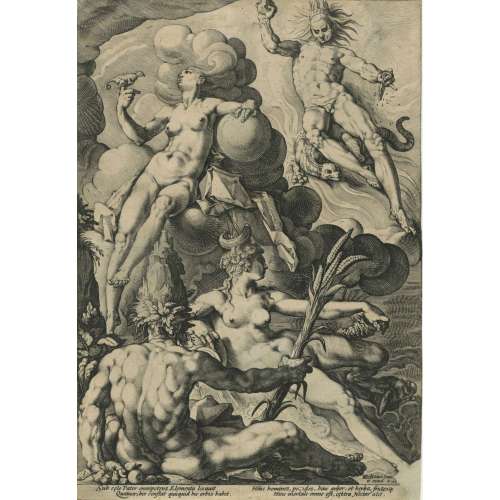
The Four Elements by Jacob Matham (Netherlandish, Haarlem 1571–1631 Haarlem) after Hendrick Goltzius (Netherlandish, Mühlbracht 1558–1617 Haarlem). Engraving on copper, printed on laid paper, 1588.
Dimensions: 298 mm × 206 mm.
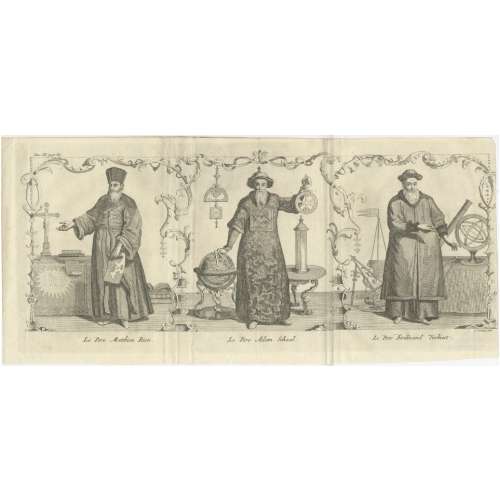
Three priests: Le Pere Matthieu Ricci, Le Pere Adam Schaal, and Le Pere Ferdinand Verbiest. Three priests with navigational instruments. Image taken from Description geographique, historique, chronologique et physique de l'Empire de la Chine et de la Tartarie Chinoise. Enrichies des cartes generales et particulieres de ces pays, etc. by Jean-Baptiste Du Halde (1674–1743), vol. 3, page 78. Originally published/produced in La Haye [The Hague], 1736. J.v.Solingen fecit
Jean-Baptiste Du Halde (Chinese: 杜赫德; 1 February 1674 – 18 August 1743) was a French Jesuit historian specializing in China. He did not travel to China, but collected seventeen Jesuit missionaries' reports and provided an encyclopedic survey of the history, culture and society of China and "Chinese Tartary," that is, Manchuria. Voltaire said of Du Halde's work: "Although it is developed out of Paris, and he hath not known the Chinese, [he] gave on the basis of the memoirs of his colleagues, the widest and the best description the empire of China has had worldwide." Le Pere Matthieu Ricci, a.k.a. Matteo Ricci, S.J. (Italian pronunciation: [matˈtɛːo ˈrittʃi]; Latin: Mattheus Riccius Maceratensis; 6 October 1552 – 11 May 1610), was an Italian Jesuit priest and one of the founding figures of the Jesuit China missions. His 1602 map of the world in Chinese characters introduced the findings of European exploration to East Asia. He is considered a Servant of God by the Roman Catholic Church. Ricci arrived at the Portuguese settlement of Macau in 1582 where he began his missionary work in China. He became the first European to enter the Forbidden City of Beijing in 1601 when invited by the Wanli Emperor, who sought his services in matters such as court astronomy and calendrical science. He converted several prominent Chinese officials to Catholicism, such as Xu Guangqi, who aided in translating Euclid's Elements into Chinese as well as the Confucian classics into Latin for the first time. Le Pere Adam Schaal, a.k.a. Johann Adam Schall von Bell (1 May 1591 – 15 August 1666) was a German Jesuit and astronomer. He spent most of his life as a missionary in China (where he is remembered as "Tang Ruowang") and became an adviser to the Shunzhi Emperor of the Qing dynasty. Le Pere Ferdinand Verbiest, a.k.a. Father Ferdinand Verbiest (9 October 1623 – 28 January 1688) was a Flemish Jesuit missionary in China during the Qing dynasty. He was born in Pittem near Tielt in the County of Flanders (now part of Belgium). He is known as Nan Huairen (南懷仁) in Chinese. He was an accomplished mathematician and astronomer and proved to the court of the Kangxi Emperor that European astronomy was more accurate than Chinese astronomy. He then corrected the Chinese calendar and was later asked to rebuild and re-equip the Beijing Ancient Observatory, being given the role of Head of the Mathematical Board and Director of the Observatory. He became close friends with the Kangxi Emperor, who frequently requested his teaching, in geometry, philosophy and music. Verbiest worked as a diplomat and cartographer, and also as a translator because he spoke Latin, German, Dutch, Spanish, Hebrew, and Italian. He wrote more than thirty books. During the 1670s, Verbiest designed what some claim to be the first ever self-propelled vehicle – many claims this as the world's first automobile, in spite of its small size and the lack of evidence that it was actually built.Joshua Van Solingen was an engraver and publisher from Holland, working, besides other places, in Scotland. Information about him can be found at Catastrophic Bliss (The Griot Project Book Series) by Accounting in Scotland (RLE Accounting): A Historical Bibliography History of the Scottish Metrical Psalms: With an Account of the Paraphrases ... The History of Edinburgh, from the Earliest Accounts to the Present Time ... History of the Bassandyne Bible, the First Printed in Scotland: With Notices ...
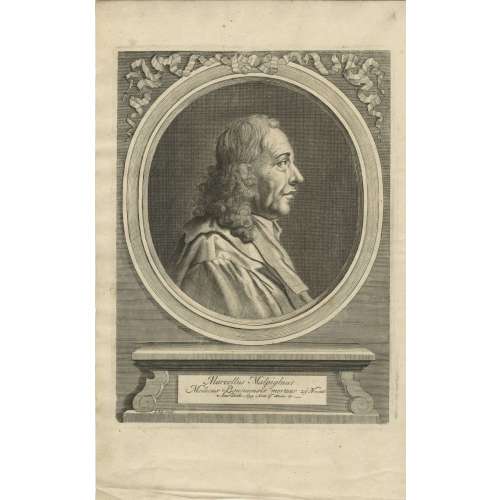
A portrait of Marcello Malpighi from his book Opera posthuma: figuris aeneis illustrata, quibus praefixa est ejusdem vita a seipso scripta, Londini:Churchill, 1697. Inscription: Marcellus Malpighius | Medicus Bononiensis mortuus 29 Novemb. Anno Dom. 1694. Anno aetatis 67. I. Kip. sculp.
Marcello Malpighi (10 March 1628 – 29 November 1694) was an Italian biologist and physician, who is referred to as the "Father of microscopical anatomy, histology, physiology and embryology" [Wikipedia].
From European Journal of Anatomy 22(5):433-439 · September 2018, an article by Sanjib Ghosh and Ashutosh Kumar 'Marcello Malpighi (1628-1694): Pioneer of microscopic anatomy and exponent of the scientific revolution of the 17th Century': Italian anatomist and an eminent scientist who significantly contributed to the advancement of the anatomical sciences in the 17th century. Malpighi was one of the first to use the compound microscope (an instrument designed by Galileo in 1609) and made the most important discovery of his life in 1661 when he identified capillaries as connecting vessels between small arteries and veins in the lungs. Malpighi thus provided the missing link in William Harvey's theory of blood circulation. He made significant contributions in the field of embryology based on his observations on chick embryo, and his efforts provided deep insights into the development of the heart and the nervous system. His communications based on microscopic studies scripted valuable details on the structural organization of organs like the liver, kidney and spleen. He identified the hepatic lobule as the fundamental unit of the liver and noted that bile was being secreted by these lobules and not from the gall bladder (the popular belief then). In the kidney, he discovered the glomerulus (Malpighian Corpuscle) and was the first to observe the convoluted tubules in the renal cortex. He was the first to describe the presence of lymphatic bodies (Malpighi's Corpuscle) in the spleen. Although he was exceedingly successful in his scientific activities, his life was fraught with unfortunate events and savage criticism from detractors arising out of professional jealousy and personal feuds. Nevertheless, his exploits were instrumental in understanding the human microscopic anatomy (histology) and his accomplishments have etched his name in the pages of medical science forever.
The portrait was engraved by Johannes "Jan" Kip (1652/53, Amsterdam – 1722, Westminster) - a Dutch draftsman, engraver and print dealer.
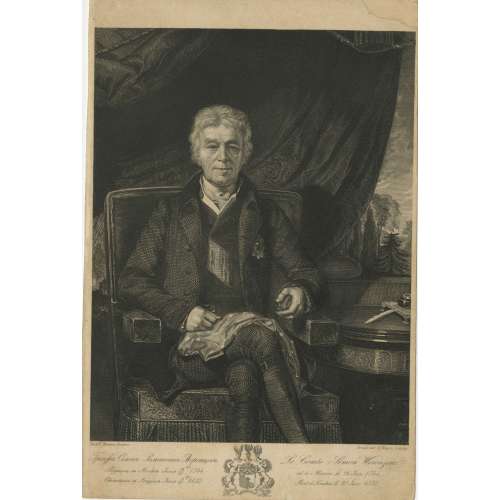
Seated portrait of Russian diplomat Count Semyon Romanovich Vorontsov (Семён Романович Воронцо́в; 26 June 1744 – 9 July 1832). Engraved by August Weger (Born: 1823 in Nürnberg; died: 1892 in Leipzig) from the portrait painted by Richard Evans (1784–1871). Circa 1825-50. Semyon Romanovich Vorontsov, the son of Count Roman Illarionovich and Marfa Ivanovna Surmina, was born on June 15, 1744; Active Privy Councillor; Ambassador to Venice and London from 1784, for over 20 years. Died in London on June 26, 1832.
Inscription: Графъ Семенъ Романовичь Воронцовъ. Родился въ Москвѣ Iюня 15-го/26 1744, Скончался въ Лондонѣ Iюня 9-го/21 1822. | Le Comte Simon Woronzow. né à Moscou le 26 Juin 1744, Mort à Londres le 21 Juin 1832. | Richd. Evans, Peintre. - Gravé par A. Weger, Leipzig. Vorontsov family coat of arms in the middle.
Dimensions: 23 x 15 cm. Ref.: Подробный словарь русских гравированных портретов Д. А. Ровинского, том. 1, 534-540.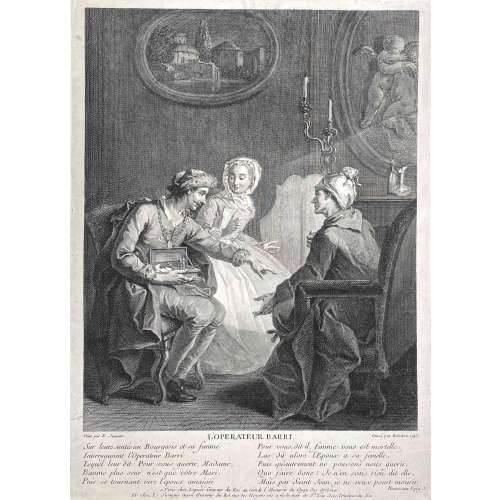
Engraving by J.J. Balechou after E. Jeaurat. A husband and wife ask a quack doctor for advice about health: he suggests substituting himself for the husband in the wife's affections, and she agrees: Épigrammes de Jean-Baptiste Rousseau (French, 1671–1741).
Date: 1743.
Size: 380 x 270 mm
Inscriptions under the image:
Top: Peint par E. Jeaurat | L'Operateur Barri | Grave par Balechou 1743
Middle: Sur leurs santés un Bourgeois et sa femme
Interrogeoient l'Operateur Barri, Lequel leur dit : Pour vous guérir, Madame, Baume plus sûr n'est que votre Mari, Puis se tournant vers l'époux amaigri, Pour vous, dit il, femme vous est mortelle, Las ! dit alors l'Epoux à sa femelle, Puis qu'autrement ne pouvons nous guérir, Que faire donc ? Je n'en sçai rien, dit elle,Mais, par Saint Jean, je ne veux point mourir.
Rousseau Epig. X
Center bottom: a Paris chez Lepicie Graveur du Roi au coin de l'Abreuvoir du Quay des Orfevres. Et Chez L. Surugue Aussi Graveur du Roi rue des Noyers vis a vis le mur de St. Yves Avec Privilege du Roi.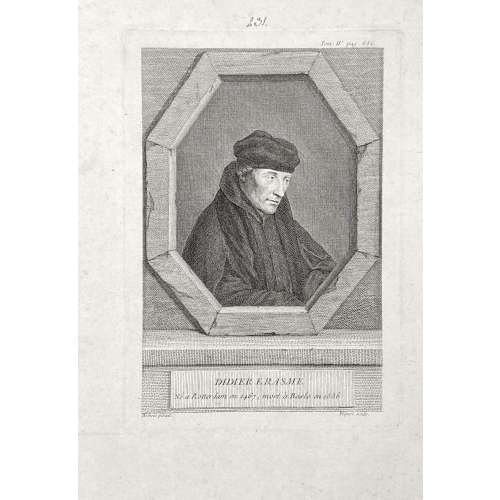
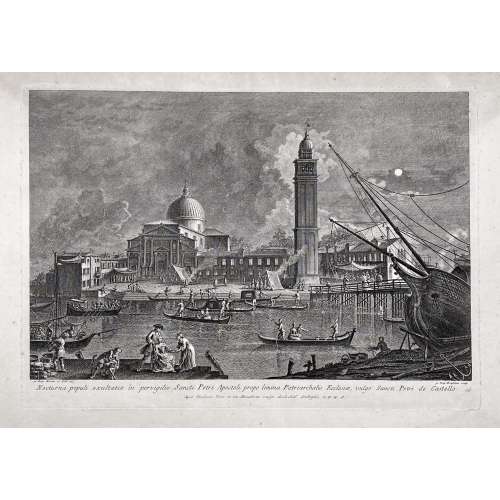
From the series of prints 'Prospectum Ædium Viarumque Insigniorum Urbis Venetiarum'. Inscribed below image left: "Jo. Bap. Moretti et Filii del. e Pinx."; right: "Jo. Baptista Brustoloni sculp."; in lower margin centre: "Nocturna populi exultatio in pervigilio Sancti Petri Apostoli prope limina Patriarchalis Ecclesiæ, vulgò Sancti Petri de Castello. / Apud Ludovicum Furlanetto supra Pontem vulgo dictum dei Baretteri C.P.E.S.". The third state, published by Teodoro Viero; the numbering on plate lower right, next to the inscription in Latin is cancelled as indicated by bibliography.
The subject is taken from a drawing by Giovanni Battista Moretti (Italian, active Venice, 1748-75) which in turn derives from a Canaletto painting. The print comes from the most important of Brustolon’s series, Prospectuum Aedium Viarumque Insignorum Urbis Venetiarum, dedicated to the Doge Marco Foscarini, from drawings by Canaletto, Moretti and sons and others, published for the first time by Ludovico Furlanetto in 1763 and later by Teodoro Viero. Giambattista Brustolon (1712–1796) was a famous Venetian engraver, a pupil of Joseph Wagner; whose talent is best displayed in his famous nocturnals: ‘riesce a dare il meglio di sé … nei famosi notturni’ (Succi).
Plate: 324 × 458 mm Sheet: 350 × 471 cm
References: The British Museum 1944,1014.209.48; The Metropolitan Museum of Art 60.611.29(4) (first state); Dario Succi, Da Carlevaris ai Tiepolo, 1983, pp.81-93, n. 55; William George Constable, J. G. Links, Canaletto: Giovanni Antonio Canal. 1697–1768. Oxford, 1989, vol. II, cat. no. 10, p. 674.
Condition: a very slight central fold, slight foxing and a very slight stain to the top, four small pinholes in corners, not affecting the engraving; else a well-margined copy in good condition.
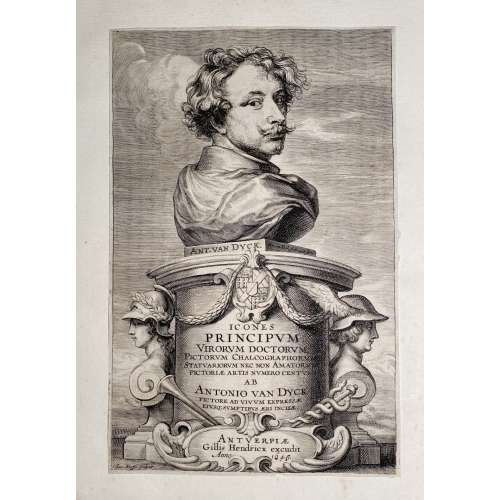
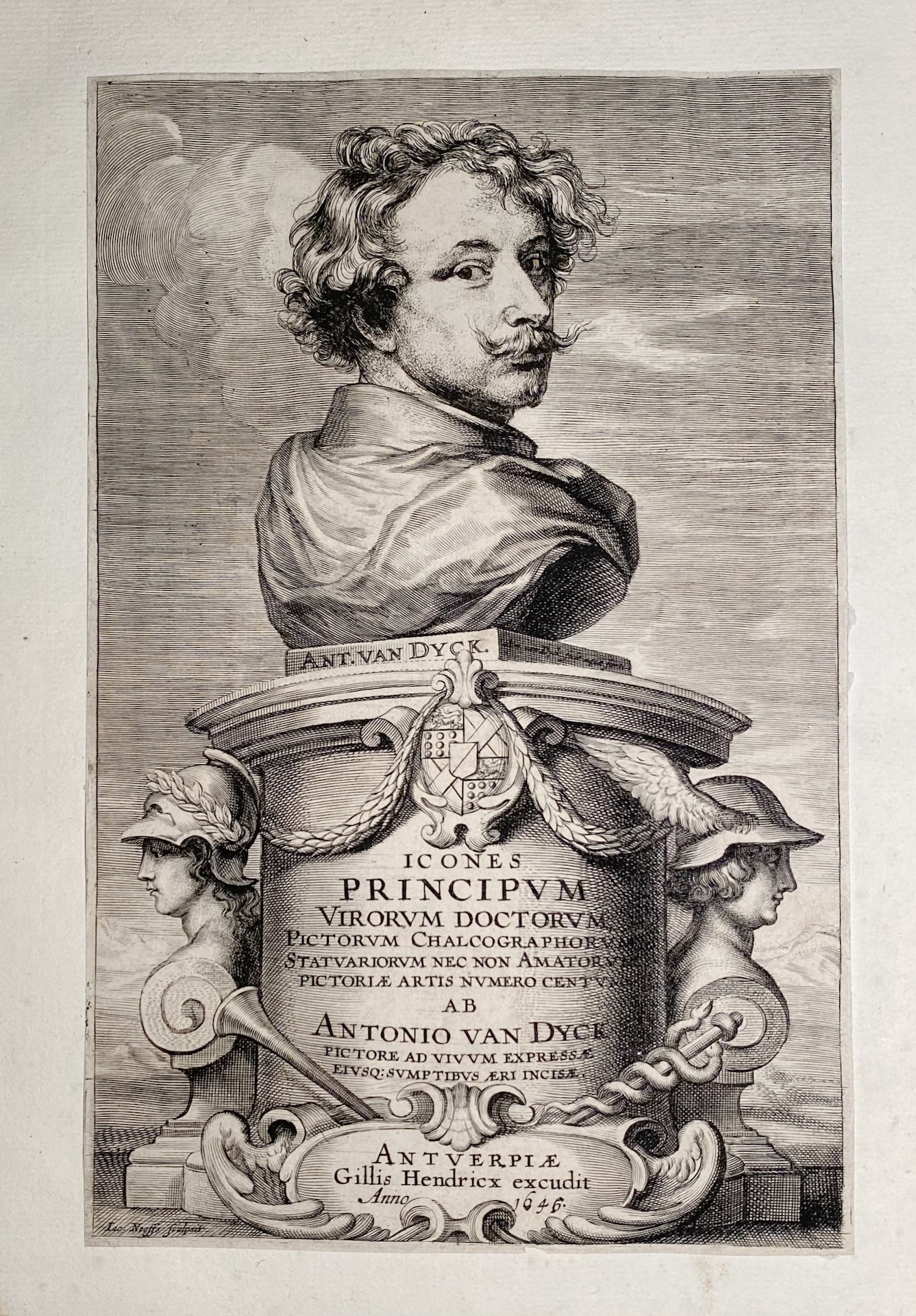 |
1. Engraved title page by Jacob Neeffs in 1646. On the slab supporting the bust, left: “ANT. VAN DYCK”, right: “Ant. van Dyck fecit aqua forti”. On the face of pedestal: “PRINCIPVM | VIRORVM DOCTORVM, | PICTORVM CHALCOGRAPHORVM, | STATVARIORVM NEC NON AMATORVM | PICTORIÆ ARTIS NVMERO CENTVM | AB | ANTONIO VAN DYCK, | PICTORE AD VIVVM EXPRESSÆ | EIVSQ: SVMPTIBVS ÆRI INCISÆ.” In cartouche: “ANTVERPIÆ | Gillis Hendricx excudit | Anno 1645” (corrected by hand “1646”). At lower left margin: “Iac. Neeffs Sculpsit.” The print with cut off margins pasted to the bound-in leaf. Size of the print: 24.3 x 15.8 cm. |
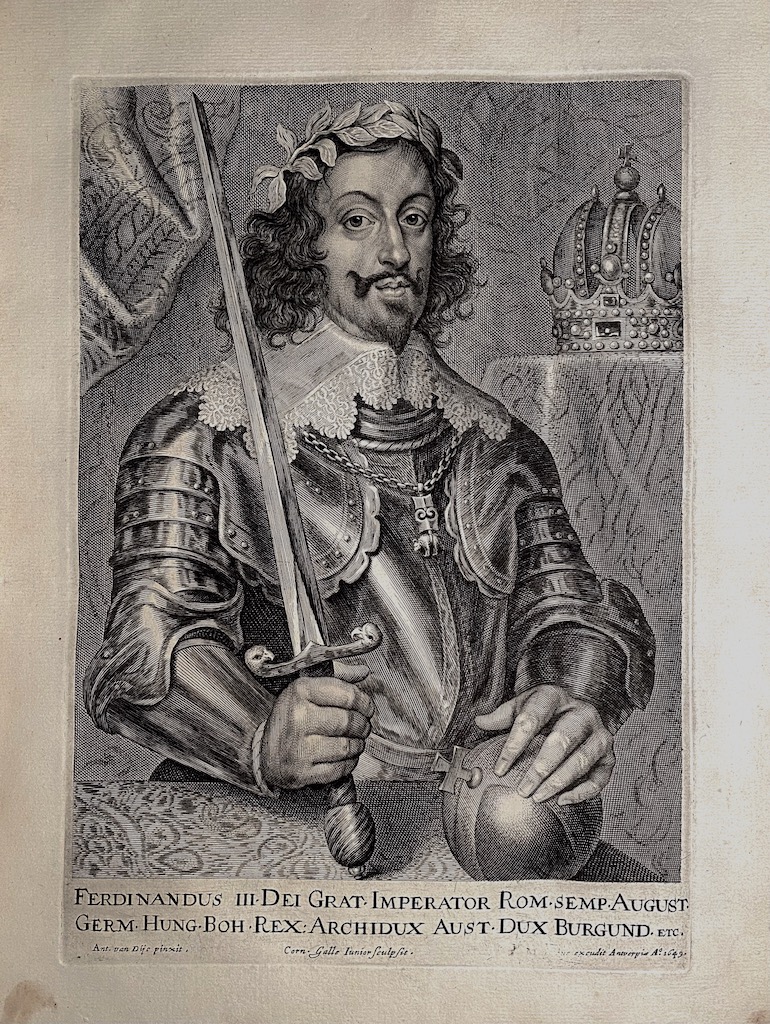 |
2. Ferdinand III, Holy Roman Emperor and King of Hungary and Bohemia (1608 – 1657); engraved by Cornelis Galle the Younger (Flemish, 1615–1678) in 1649. Inscription: “FERDINANDUS III. DEI GRAT. IMPERATOR ROM.SEMP.AUGUST. | GERM. HUNG. BOH. REX: ARCHIDICUX AU ST. DUX BURGUND. ETC.”. Below: “Ant. van Dÿc pinxit” <–> “Corn. Galle Iunior sculp∫it.”<–> “…excudit Antuerpiæ A.o 1649”. Second state with Meyssens’ name burnished. |
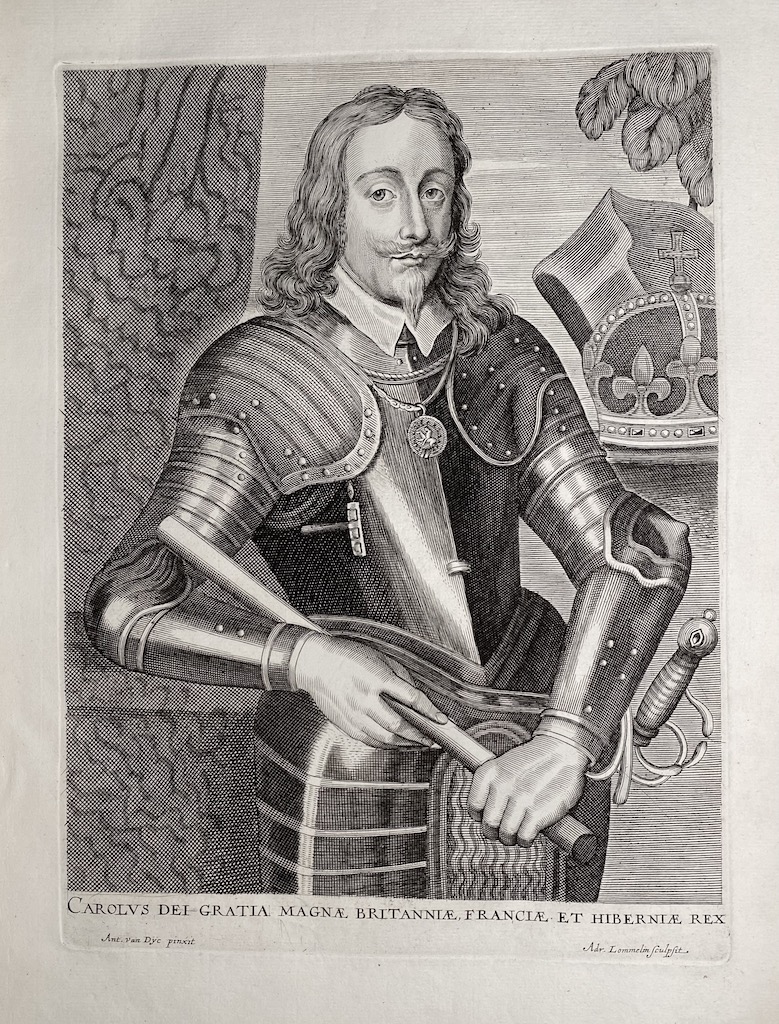 |
3. Charles I, King of England, Scotland, and Ireland (British, 1600 – 1649); engraved by Adriaen Lommelin (French, 1637 – c. 1673). Inscription: “CAROLVS DEI GRATIA MAGNÆ BRITANNIÆ, FRANCIÆ ET HIBERNIÆ REX”. Below: “Ant. van Dÿc pinxit” <–> “Adr. Lommelin sculpsit”. |
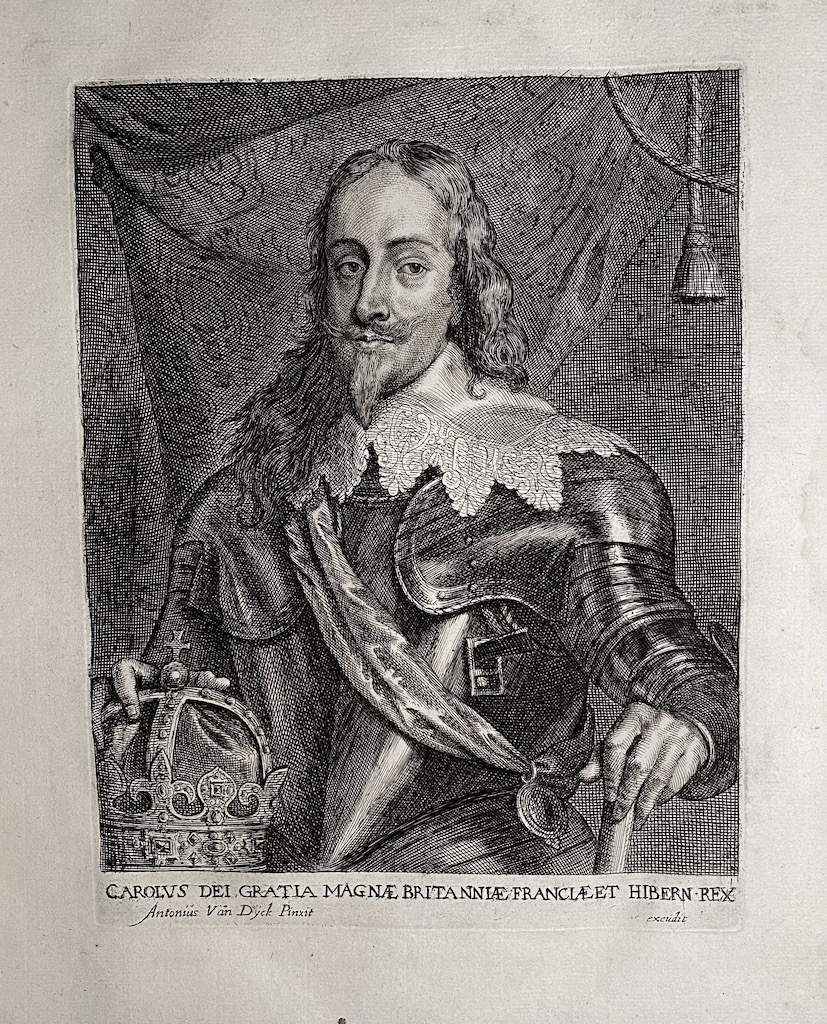 |
4. Charles I, King of England, Scotland, and Ireland (British, 1600 – 1649); engraved by Johannes [Jan] Meyssens (Flemish, 1612 – 1670). Inscription: “CAROLVS DEI GRATIA MAGNÆ BRITANNIÆ, FRANCIÆ ET HIBERNIÆ REX”. Below: Antonius Van Dÿck eques pinxit” <–> “...excudit”. Meyssens’ name burnished. [See similar print №61 with Ioannes Meysens name present]. |
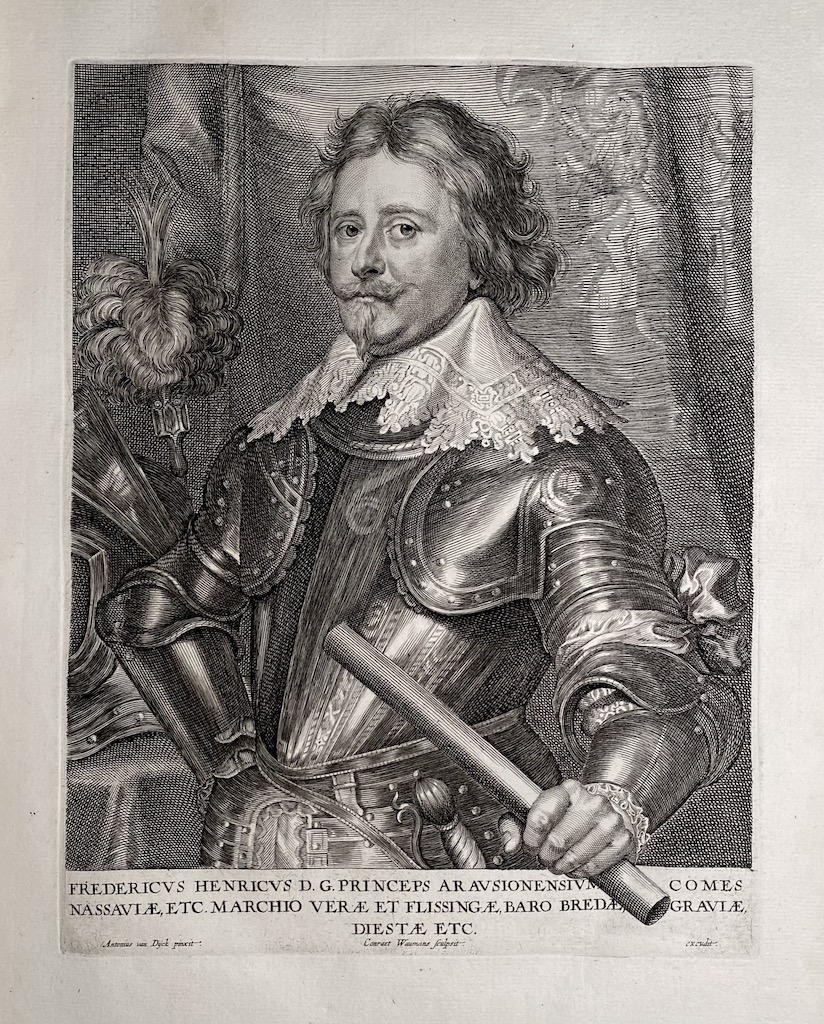 |
5. Frederick Henry, Prince of Orange, Count of Nassau (Dutch, 1584 – 1647); engraved by Conrad Waumans [Woumans] (Flemish, 1619 – after 1675). Inscription: “FREDERICVS HENRICVS, D.G. PRINCEPS ARAVSIONENSIVM, COMES | NASSAVIÆ, ETC. | MARCHIO VERÆ ET FLISSINGÆ, BARO BREDÆ GRAVÆ, | DIESTÆ ETC.” Below: “Antonius van Dÿck pinxit” <–> “Conraet Waumans sculpsit” <–> “…excudit”. Meyssens’ name burnished. [Similar to №57, but with Ioannes Meyssens name in place]. |
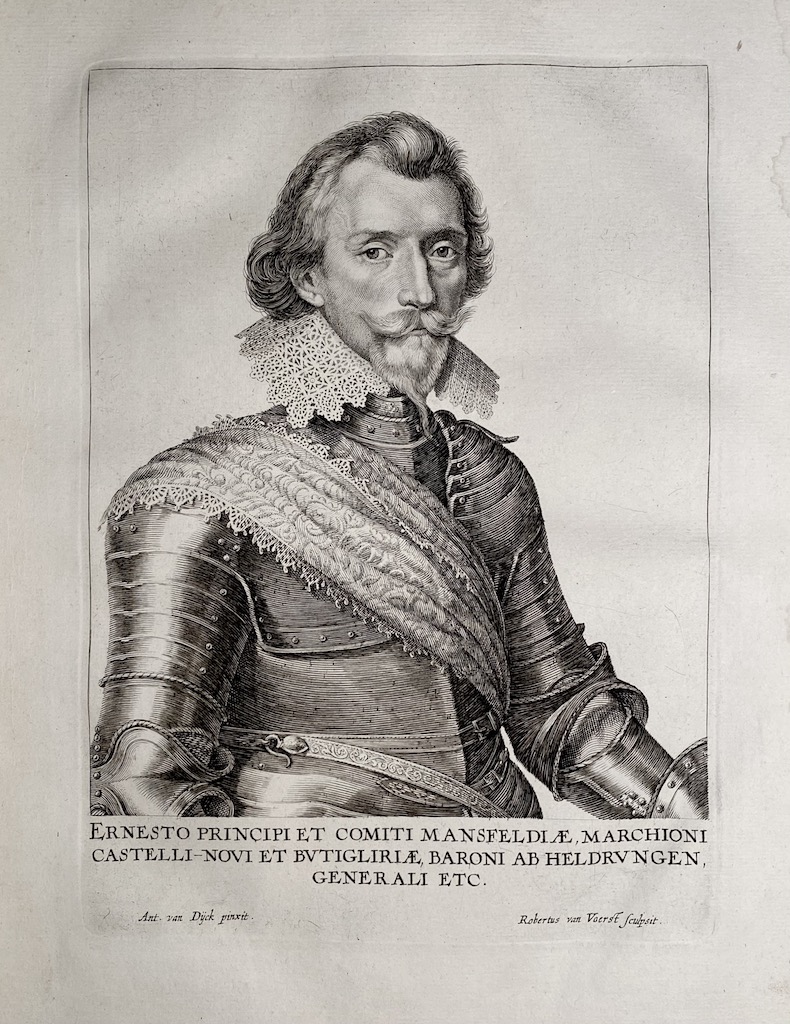 |
6. Count Ernst von Mansfield (German, 1580 – 1626); engraved by Robert van Voerst (Dutch, 1597 – 1636). Inscription: “ERNESTO PRINCIPI ET COMITI MANSFELDIÆ, MARCHIONI | CASTELLI-NOVI ET BUTIGLIRIÆ, BARONI AB HELDRUNGEN, GENERALI ETC.” Below “Ant. Van Dÿck pinxit” <–> “Robertus van Voerst Sculpsit”. |
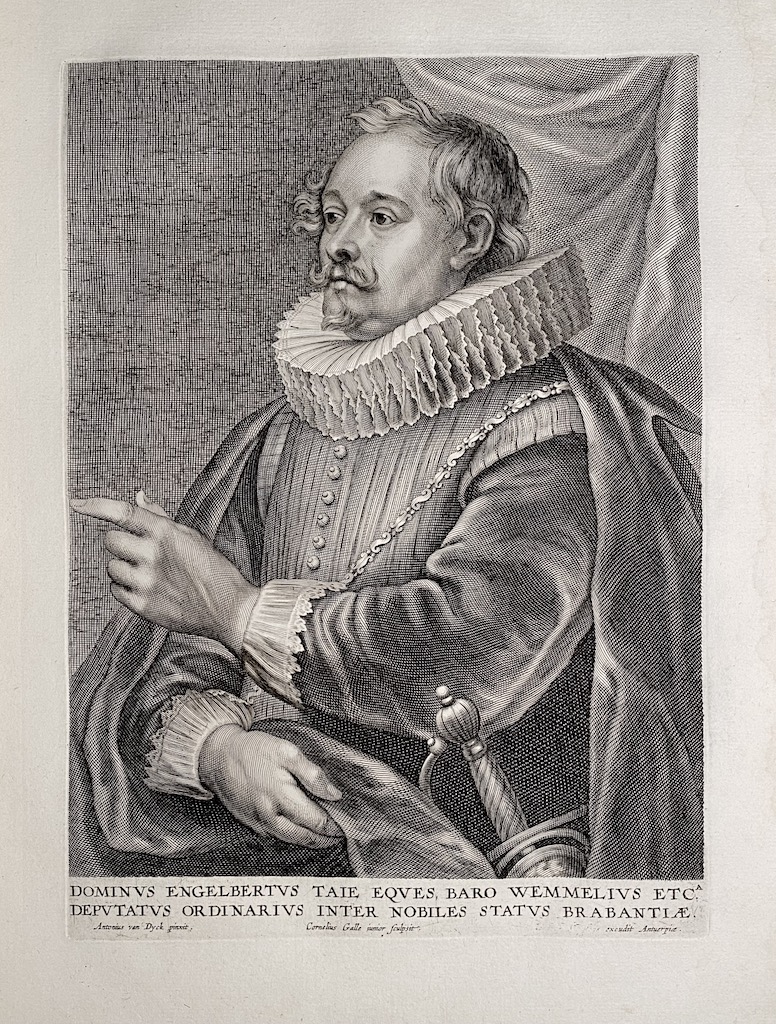 |
7. Engelbert Taye, Baron of Wemmel (Flemish, ? – 1638); engraved by Cornelis Galle the Younger. “DOMINVS ENGELBERTVS TAIE EQVES, BARO WEMMELIVS ETC.A | DEPVTATVS ORDINARIVS INTER NOBILES STATVS BRABANTIÆ.”. Below: “Antonius van Dyck pinxit”, “Cornelius Galle iunior ∫culpsit” <–> “…excudit Antuerpiæ.”. Second state, with “Ioannes Meyssens” erased. |
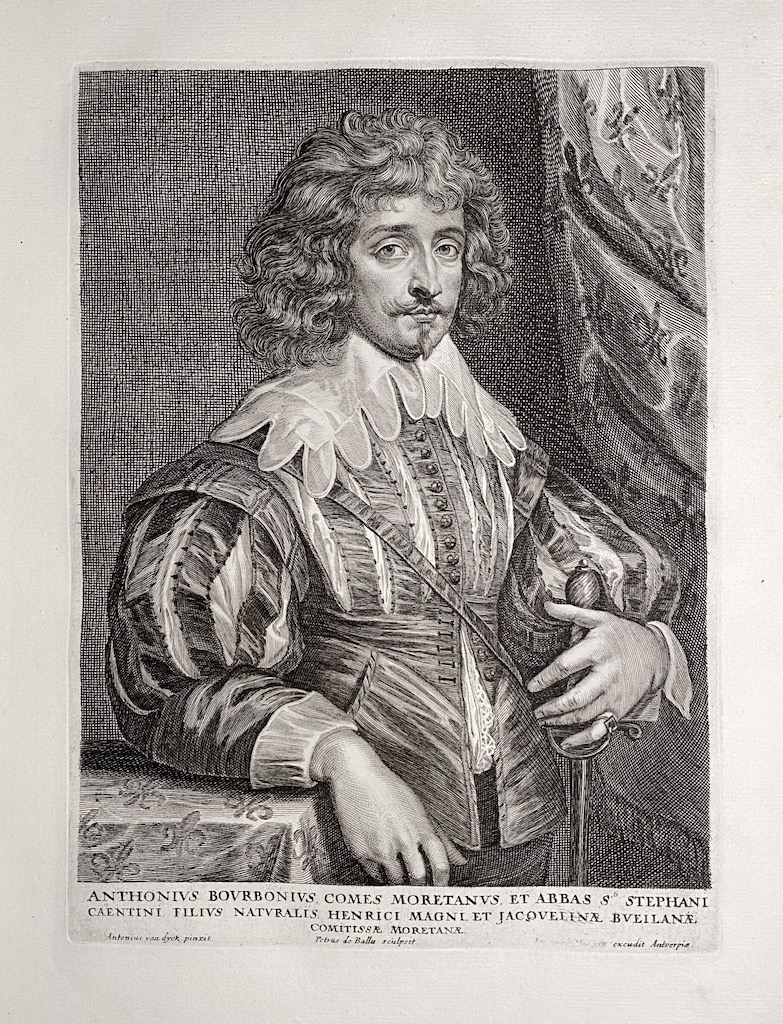 |
8. Antoine de Bourbon, comte de Moret (French, 1607 – 1632); engraved by Pieter de Bailliu (Flemish, 1613 – after 1660). Inscription: “ATHONIVS BOVRBONIVS, COMES MORETANVS, ET ABBAS S.TI STEPHANI | CAENTINI, FILIVS NATVRALIS, HENRICI MAGNI ET JACQVELINÆ BVEILANÆ | COMITISSÆ MORETANÆ,”. Below: “Antonius van dyck pinxit.” <–> “Petrus de Ballu sculpsit.” <–>“… excudit Antverpiæ.”. Second state with “Ioannes Meyssens” erased. Antoine de Bourbon was the illegitimate son of Henri IV, Roi de France and Jacqueline de Bueil, Comtesse de Moret. |
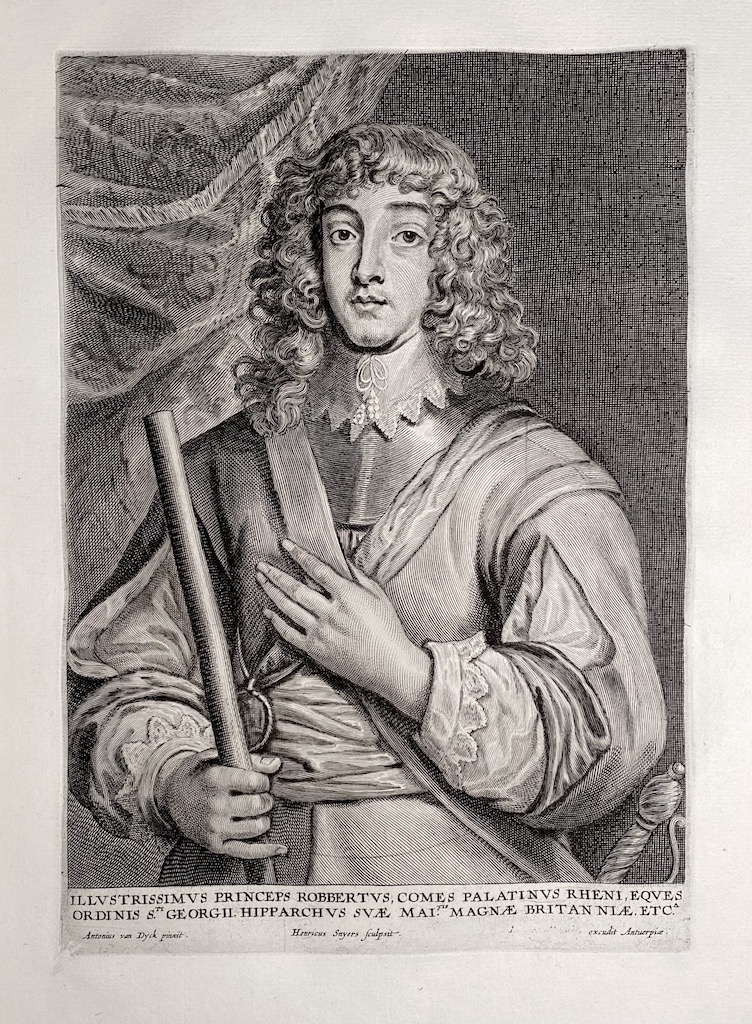 |
9. Prince Rupert of the Rhine (German, Bohemian, 1619 –1682); engraved by Hendrick Snyers (Flemish, 1611 – 1644). Inscription: “ILLVSTRISSIMVS PRINCEPS ROBBERTVS, COMES PALATINVS RHENI, EQVES | ORDINIS S.TI GEORGII. HIPPARCHVS SVÆ MAI.TIS MAGNÆ BRITANNIÆ. ETC.A”. Below: “Antonius van Dyck pinxit” <–> “Henricus Snyers sculpsit” <–> “...excudit Antuerpiæ.”. Second state with “Ioannes Meyssens” erased. |
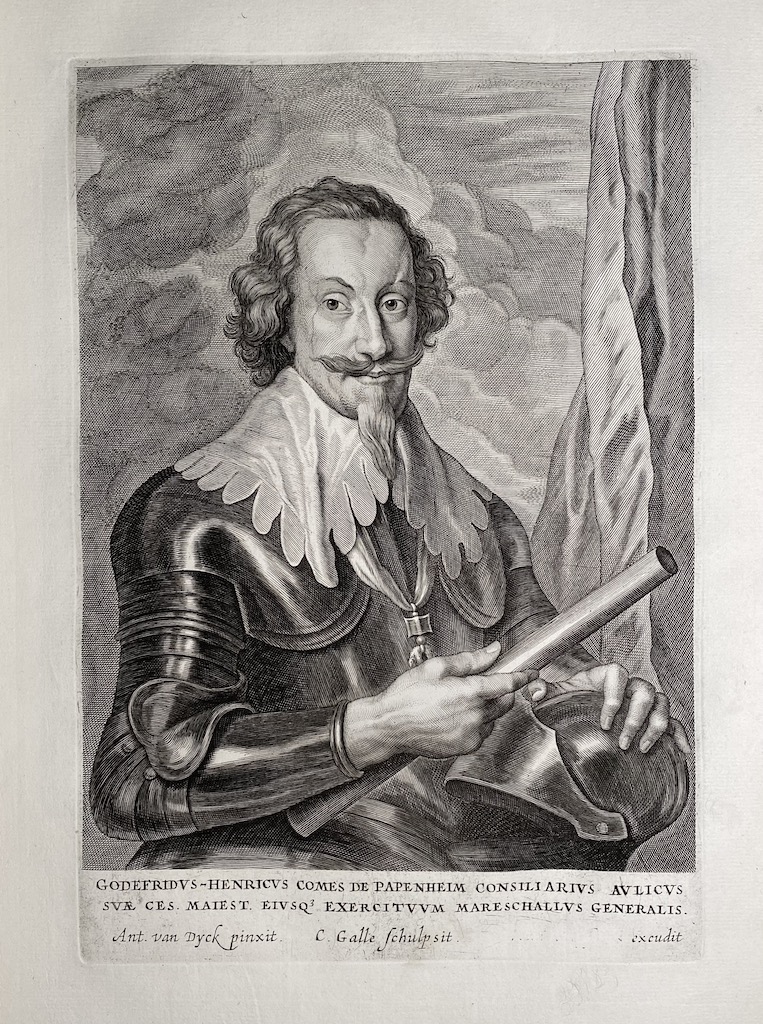 |
10. Gottfried-Heinrich, Count of Pappenheim; engraved by Cornelis Galle the Younger. Inscription: “GODEFRIDVS-HENRICVS COMES DE PAPENHEIM CONSILIARIVS AVLICVS | SVÆ CES. MAIES. EIVSQ³ EXERCITVVM MARESCHALLVS GENERALIS.” Lettered with production details below: “Ant. van Dyck pinxit” <–> “C. Galle ∫chulpsit.” <–> “…excudit”. Second state with “Ioan. Meyßens” erased. |
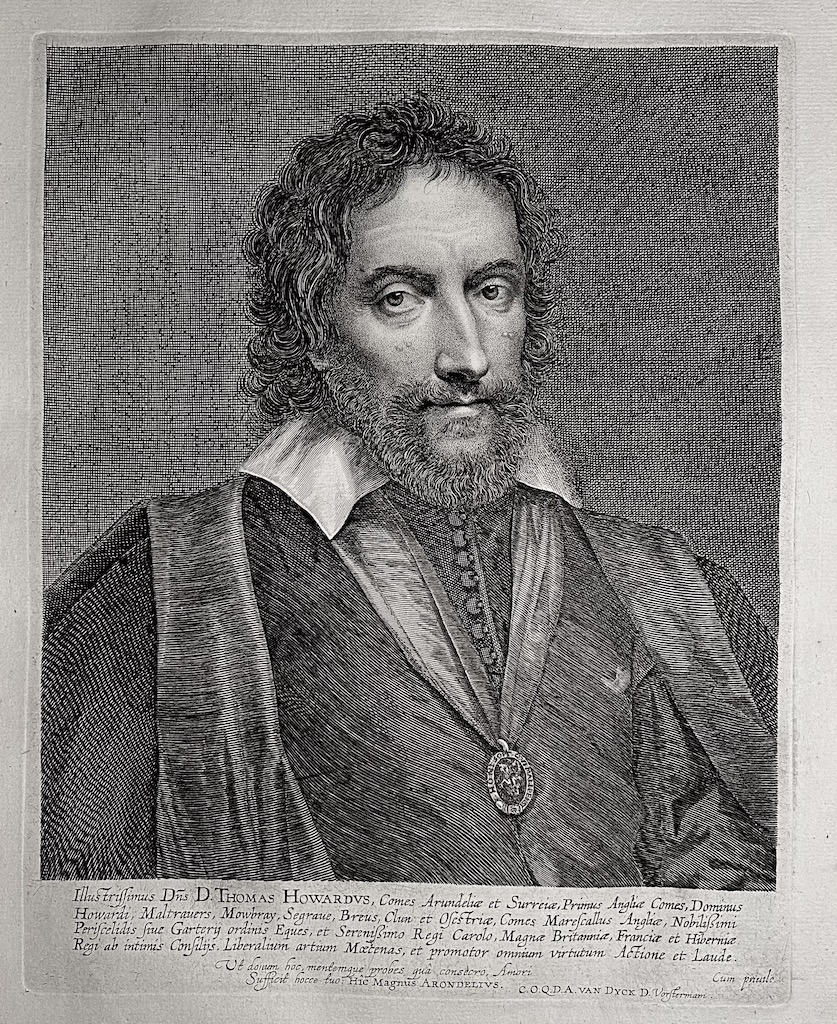 |
11. Thomas Howard, 14th Earl of Arundel (British, 1585 – 1646); engraved by Lucas Vorsterman the Elder (1595–1675). Inscription: “Illustri∫∫imus Dñs. D.Thomas Howardvs, Comes Arundeliæ et Surreiæ, Primus Angliæ Comes, Dominus | Howardi, Maltrauers, Mowbray, Segraue, Breus, Clun et O∫estriæ, Comes Mare∫callus Angliæ, Nobilißimi | Pericelidis ∫iue Garterij ordinis Eques, et Serenißimo Regi Carolo, Magnæ Britaniæ, Franciæ et Hiberniæ | Regi ab intimis Consilijs, Liberalium artium Mæcenas, et promotor omnion virtutum Actione et Laude.”. Below: “Ut donum hoc, mantenque probes qua consecro, Amori | Sufficit hocci tuo: Hic Magnvs ARONDELIVS”, “C.O.Q.D.A. VAN DYCK D. Vor∫termani.”, “Cum priuile.”. Third state with ‘Opera Vorstermanni’ burnished and two lines of Latin added below the four lines of the title. |
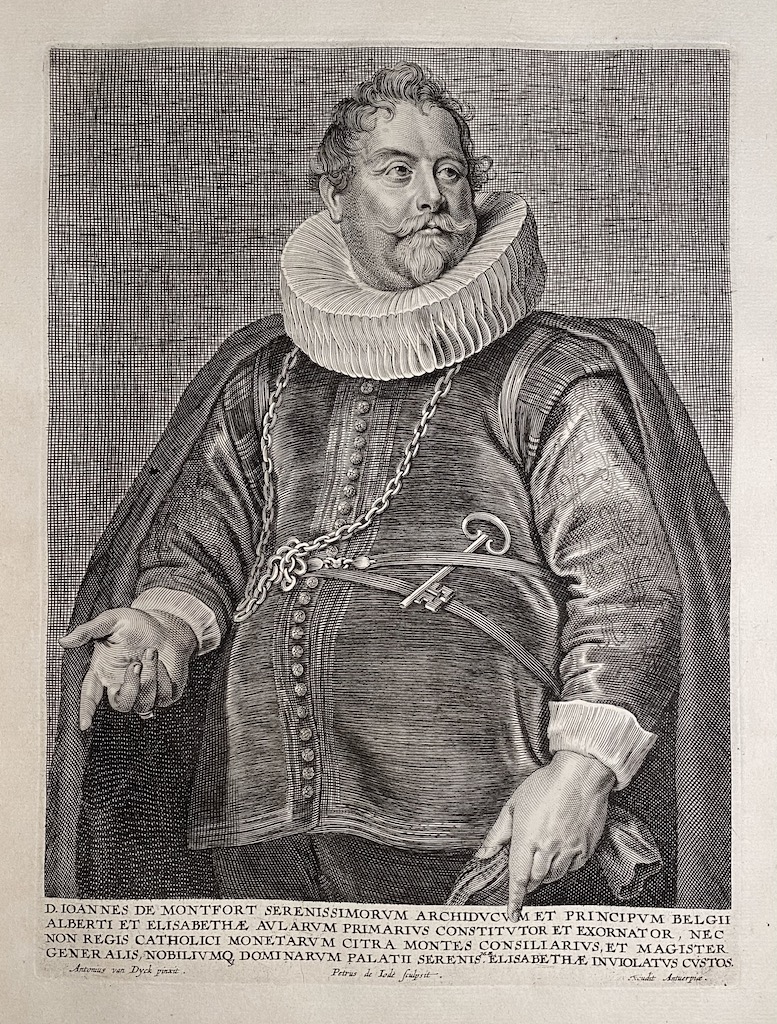 |
12. Jan van Montfort [Jean de Montfort] (Flemish, 1567 – 1648); engraved by Pieter de Jode II (Flemish, 1606 – 1670/74). Inscription: “D. IOANNES DE MONTFORT SERENISSIMORVM ARCHIDVCVM ET PRINCIPVM BELGII | ALBERTI ET ELISABETHÆ AVLARVM PRIMARIVS CONSTITVTOR ET EXORNATOR, NEC | NON REGIS CATHOLICI MONETARVM CITRA MONTES CONSILIARIVS, ET MAGISTER. | GENERALIS, NOBILIVMQ3 DOMINARVM PALATII SERENIS.MÆ ELISABETHÆ INVIOLATVS CVSTOS.” Below: “Antonius van Dyck pinxit.” <–> “Petrus de Iode sculpsit.” <–> “…excudit Antuerpiæ”. Second state with “Ioannes Meyssens” erased. |
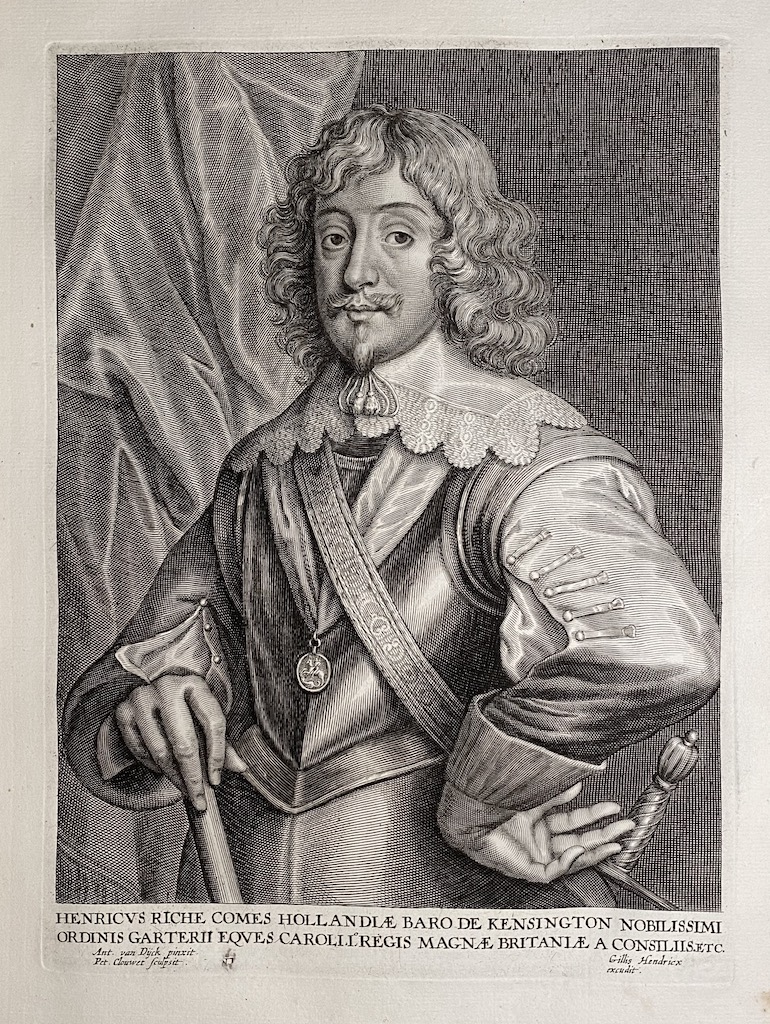 |
13. Henry Rich, 1st Earl of Holland (British, 1590 – 1649), engraved by Pieter Clouwet (Flemish, 1629 – 1670). Inscription: “HENRICVS RICHE COMES HOLLANDIÆ BARO DE KENSINGTON NOBILISSIMI | ORDINIS GARTERII EQVES CAROLI. LOREGIS MAGNÆ BRITANIÆ A CONSILIIS. ETC.”. Below: “Ant. van Dÿck pinxit.” | “Pet. Clouwet sculpsit” <–> “Gillis Hendricx | excudit”. Third state with the title added and production details re-engraved. |
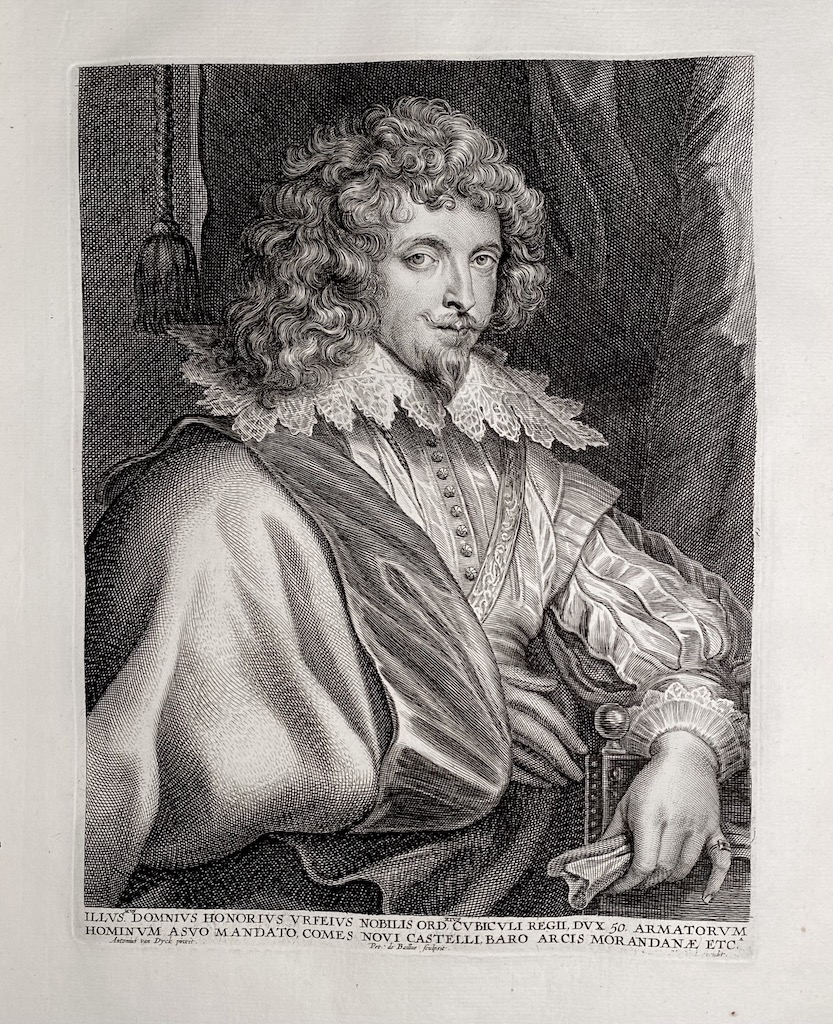 |
14. Honoré d’Urfé, marquis de Valromey, comte de Châteauneuf (French, 1568 – 1625); engraved by Pieter de Bailliu (Flemish, 1613 – 1660). Inscription: “ILLVS.MVS DOMNIVS HONORIVS VRFEIVS NOBILIS ORD.RIVS CVBICVLI REGII, DVX 50. ARMATORVM | HOMINVM A SVO MANDATO, COMES NOVI CASTELLI, BARO ARCIS MORANDANÆ ETC.A”. Below: “Antonius van Dyck pinxit” <–> “Pet. de Bailliue sculpsit.” <–> “… excudit”. Second lettered state with title and production details, with “Ioannes Meyssens” erased. [There is another copy in this binding, №54, where Ioannes Meysens' name is in place]. |
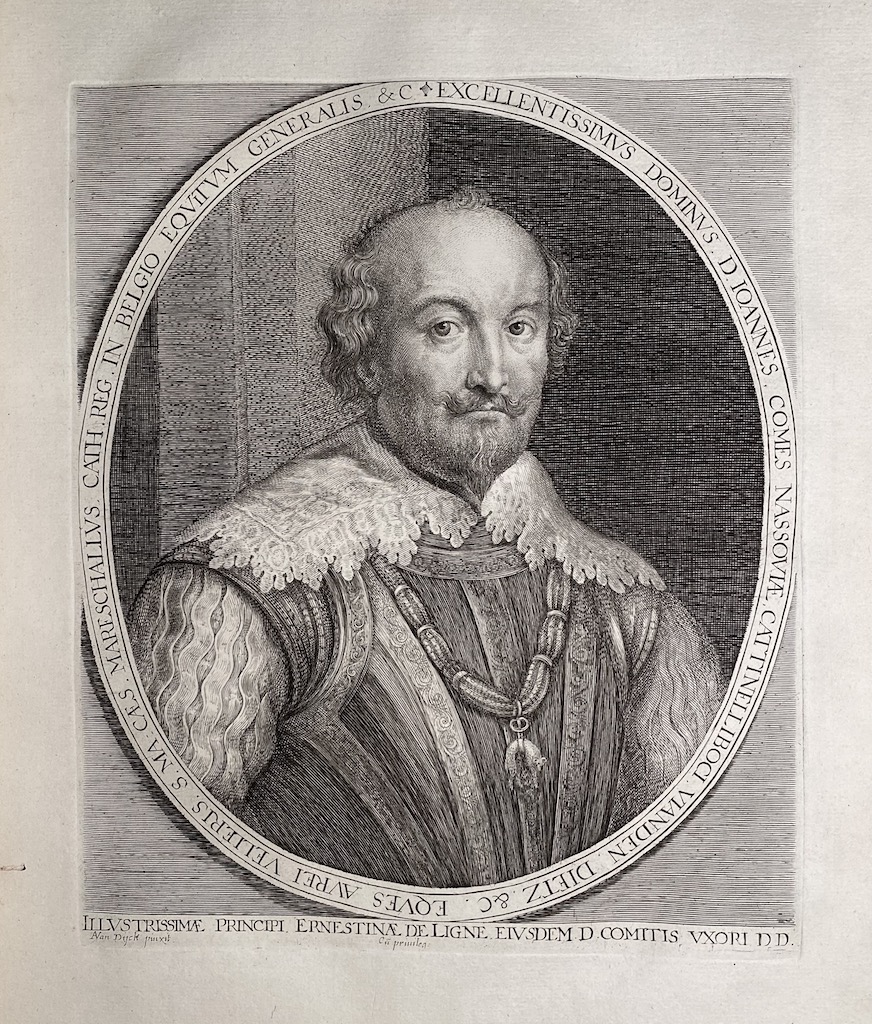 |
15. Johannes [John VIII], Count of Nassau-Siegen (German, 1583 – 1638); engraved by Lucas Vorsterman I (Flemish, 1595 – 1675). Inscription: in the oval around the portrait “EXCELLENTISSIMVS DOMINVS: D. IOANNES, COMES NASSAOVIÆ, CATTNELLIBOCI: VIANDEN, DIETZ, &C. EQVES AVREI VELLERIS. S. MA: CÆS, MARESCHALIVS, CATH. REG. IN BELGIO. EQVITVM GENERALIS. &C”, in lower margin: “ILLVSTRISSIMÆ PRINCIPI ERNESTINÆ DE LIGNE EIVSDEM D. COMITIS VXORI DD.”, and “AVan Dÿck pinxit.” <–> “Cu Priuleg”. Fourth state with Vorsterman’s address burnished. [For the third state with “Lucas Vorsterman exc” present see № 55]. |
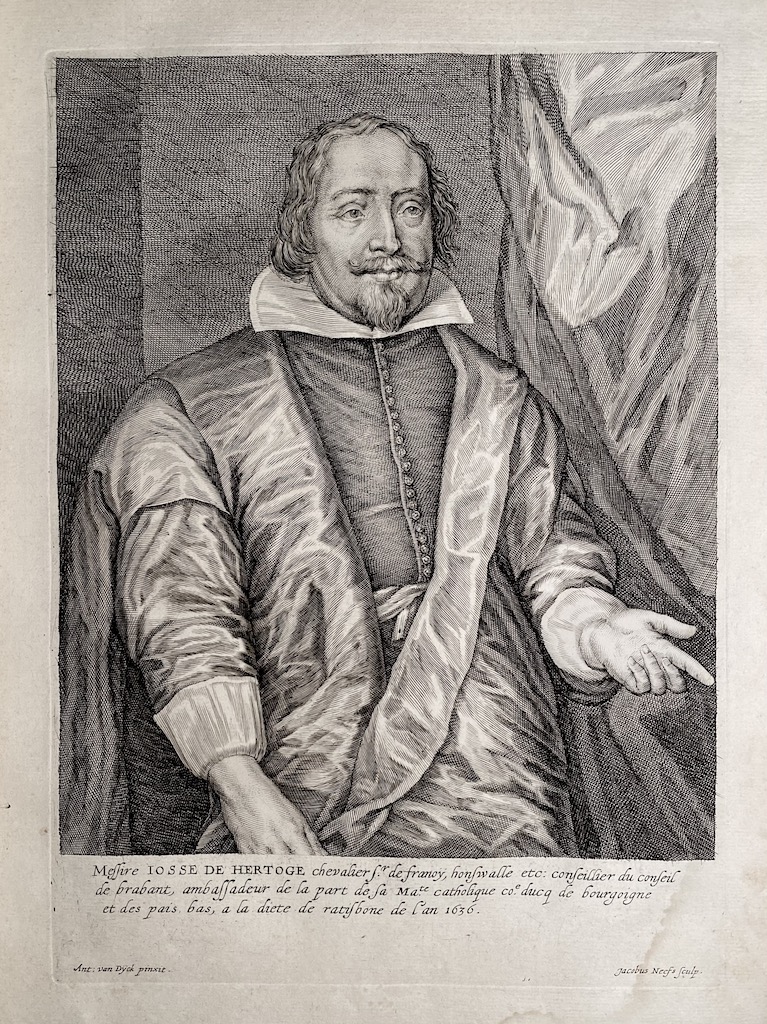 |
16. Joost de Hertoghe (Flemish, ? –1638); engraved by Jacobus Neefs. Inscription: "Me∫∫ire IOSSE DE HERTOGE chevalier ∫.r de franoÿ, hon∫walle etc: con∫eillier du conseil | de brabant, amba∫∫adeur de la part de ∫a Ma.te catholique co.e ducq de bourgoigne | et des pais bas, a la diete de rati∫bone de l'an 1636." In Lower margine: "Ant: van Dÿck pinxit.", <–>"Jacobus Neefs ∫culp.". Second, lettered state with the title and production details added. |
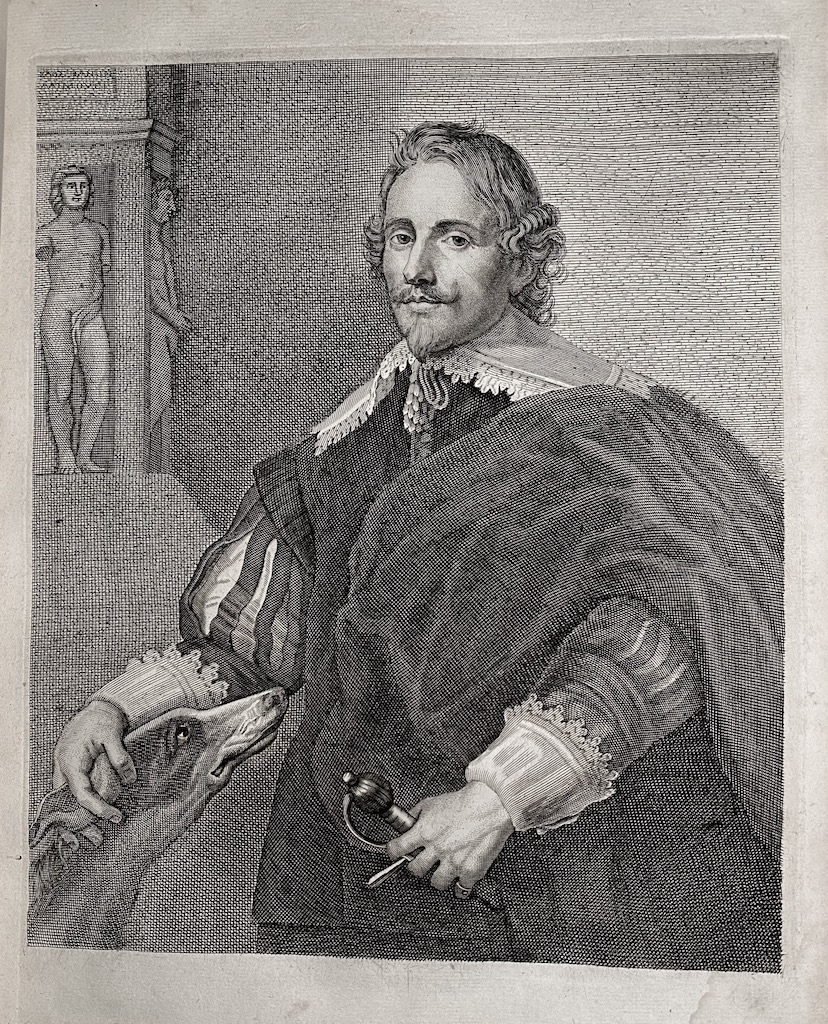 |
17. Philippe Le Roy (Flemish, 1596 – 1679). No inscription. The printmaker is unidentified but is possibly Adriaen Lommelin. The print is a copy of the print by Vorsterman and Pontius. |
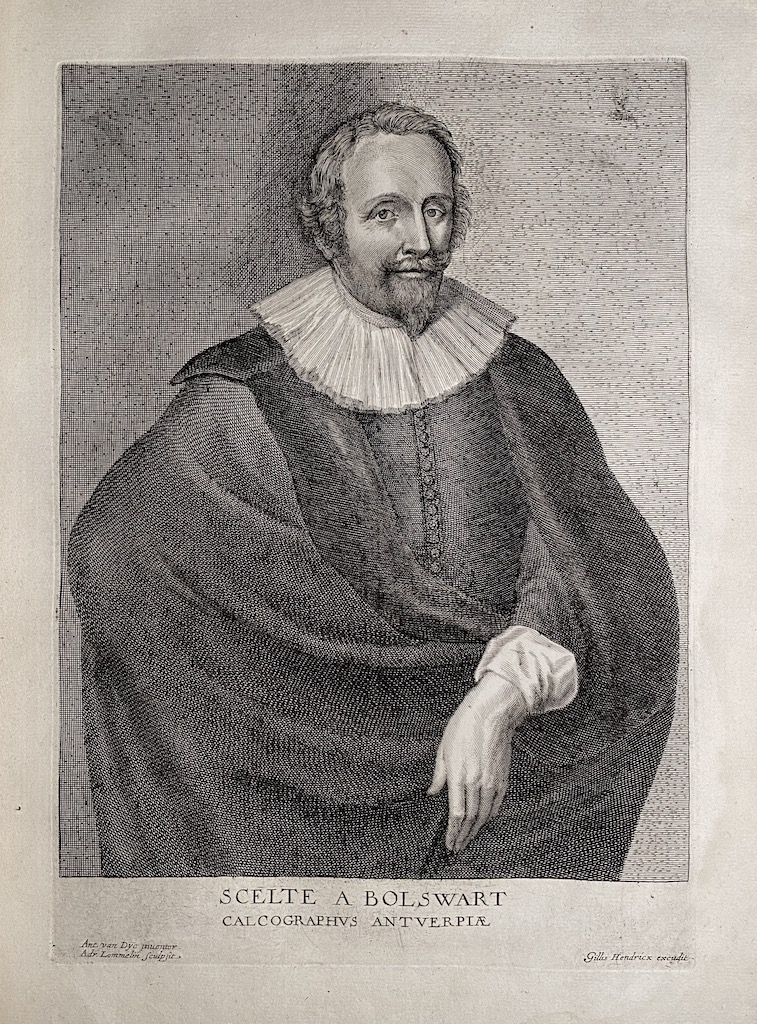 |
18. Schelte Adamsz. Bolswert (Flemish, c. 1586 – 1659); engraved by Adriaen Lommelin, published by Gillis Hendricx. Inscription: “SCELTE A BOLSWART | CALCOGRAPHVS ANTVERPIÆ”. In lower margin: “Ant. van Dÿc inuentor | Adr. Lommelin sculpsit” <–> “Gillis Hendricx excudit”. Third state with an entirely different head, title and production details added. |
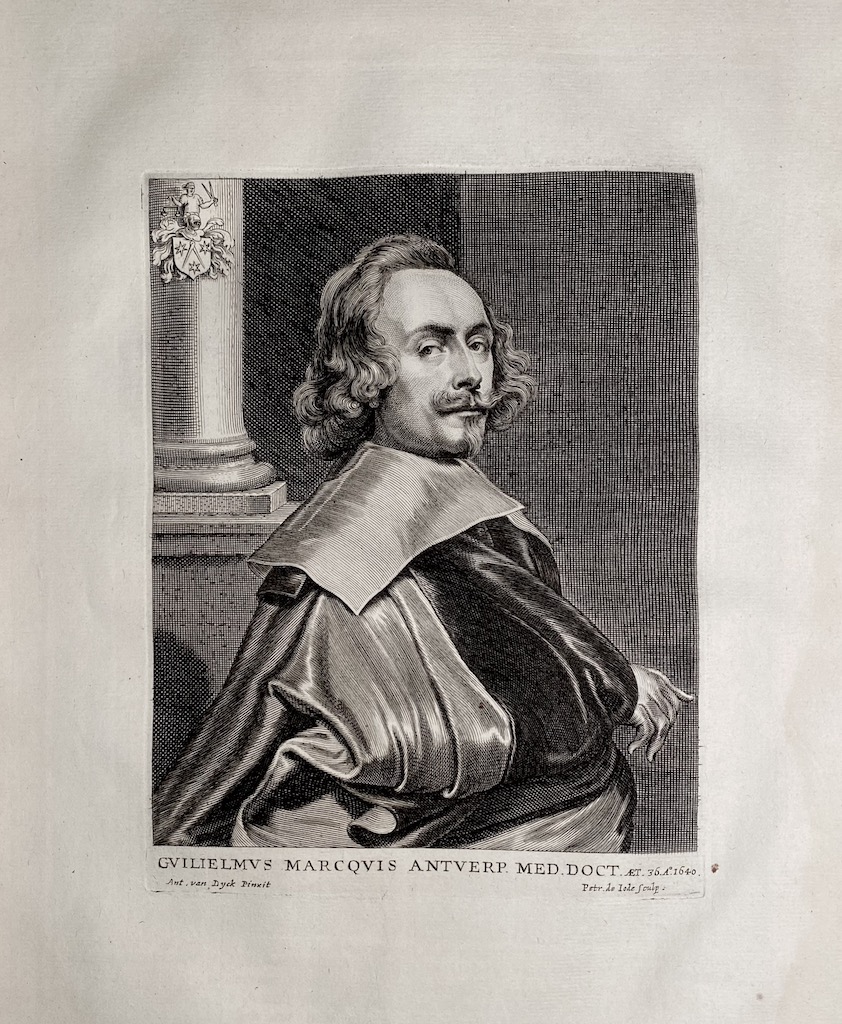 |
19. Willem Marquis (Flemish, 1604 – 1640); engraved by Pieter de Jode II. Inscription: “GVILIELMVS MARCQUIS ANTVERP. MED. DOCT. ÆT. 36.A.O 1640.” In lower margin: “Ant. van Dyck Pinxit” <–> “Petr. de Iode sculp.”. Second, lettered state with Borreken’s name burnished and replaced by Van Dyck’s. |
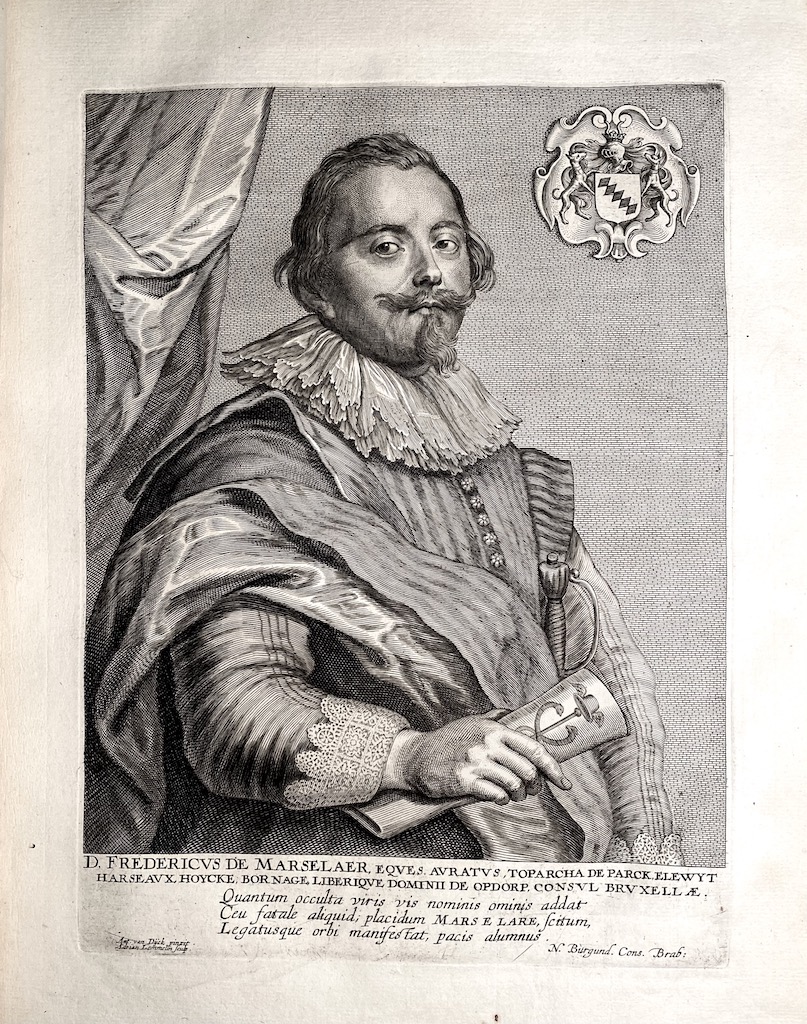 |
20. Frederik de Marselaer (Flemish, 1584 – 1670); engraved by Adriaen Lommelin. Inscription: “D. FREDERICVS DE MARSELAER, EQVES AVRATVS, TOPARCHA DE PARCK, ELEWYT | HARSEAVX, HOYCKE, BORNAGE, LIBERIQUE DOMINII DE OPDORP, CONSVL BRVXELLÆ.” Three lines of verse below: “Quantum occulta viris vis nominis ominis addat | Ceu fatale aliuid; placidum Mars E Lare, scitum, | Legatusue orbi manifestat, pacis alumnus.”. In lower margin: “Ant. van Dÿck pinxit | Adrian Lommelin sculpsit” <–> “N. Burgund. Cons. Brab:”. Third state with the roll of paper rounded. |
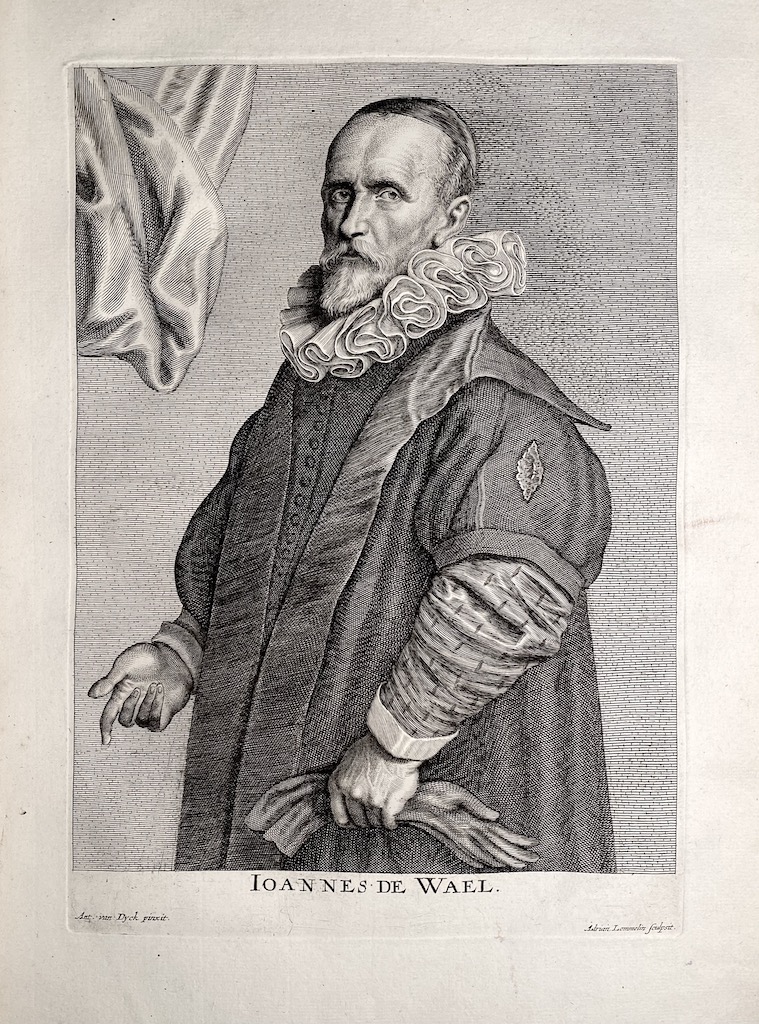 |
21. Jan Baptist de Wael I (Flemish, 1558 – 1633); engraved by Adriaen Lommelin. Inscription: “IOANNES DE WAEL.”. In lower margin: “Ant. van Dyck pinxit.”<–> and “Adrian Lommelin sculpsit.”. Second, lettered state with the title and production details. British Museum № 1872,1012.4168. |
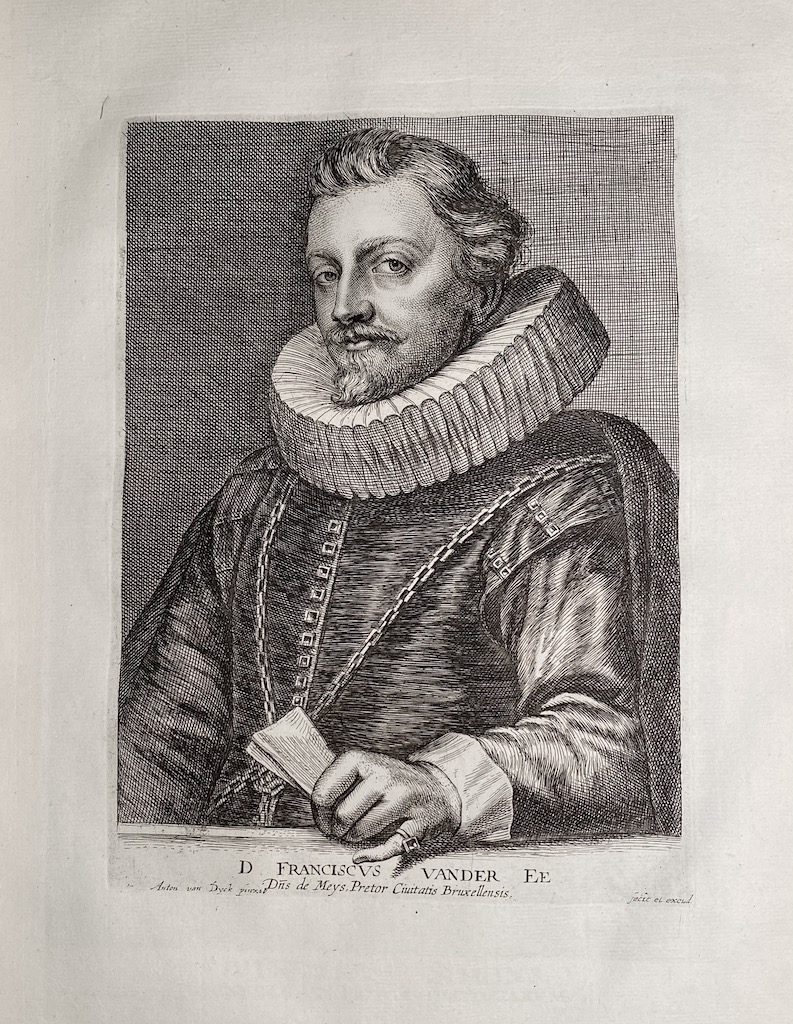 |
22. François van der Ee (Flemish, ? – 1645); engraved and published by Johannes Meyssens. Inscription: “D . FRANCISCVS VANDER EE | Dñs de Meys, Pretor Ciuitatis Bruxellensis”. In lower margin: “Anton van Dyck pinxit”, and “fecit et excud.”. Fourth, lettered state, finished with the burin, with second line added to the title, with address “Ioannes Meyssens” almost completely burnished. |
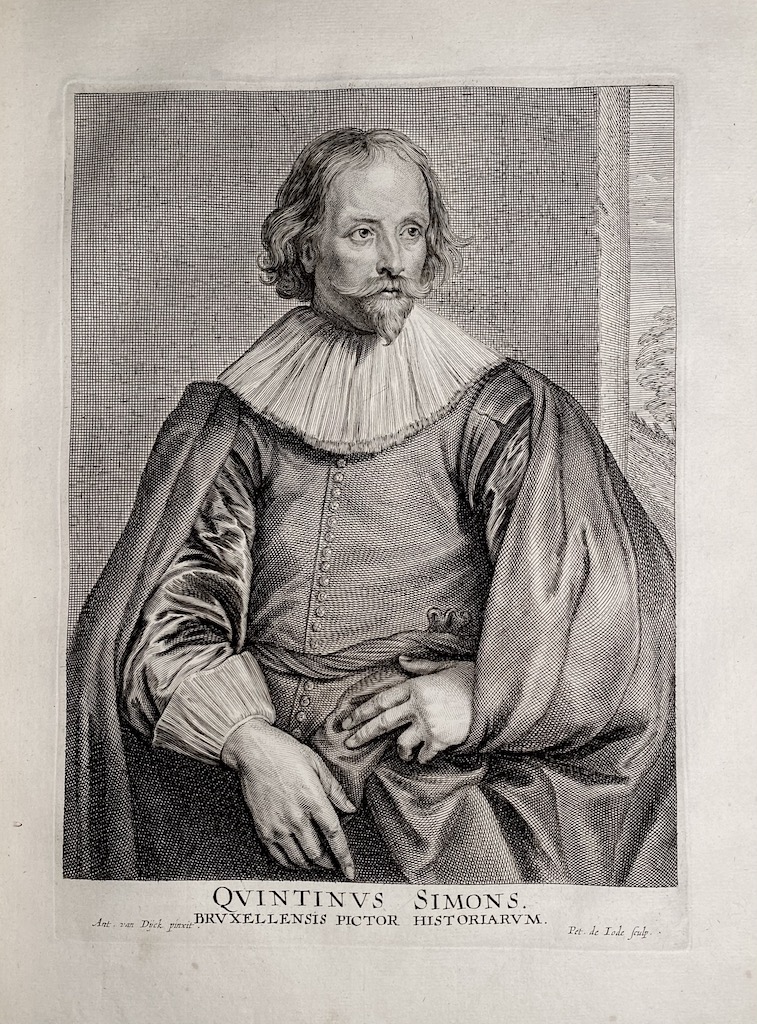 |
23. Quintijn Simons (Flemish, 1592 – after 1634); engraved by Pieter de Jode II. Inscription: “QVINTINVS SIMONIS. | BRVXELLENSIS PICTOR HISTORIARVM.”. In lower margin: “Ant. van Dijck pinxit.” <–> “Pet. de Iode sculp.”. Third state with second line of title added. |
 |
24. Adriaan Stevens (Flemish, 1561 – 1640); engraved by Adriaen Lommelin. Inscription: "INTEGERRIMVS VIR ADRIANVS STEVENS / S.P.Q. ANTVERP. AB ELEMOSYNIS.". In lower margin:"Ant van Dÿc pinxit." <–> "A. Lommelin sculp.". British Museum # R,1b.20. |
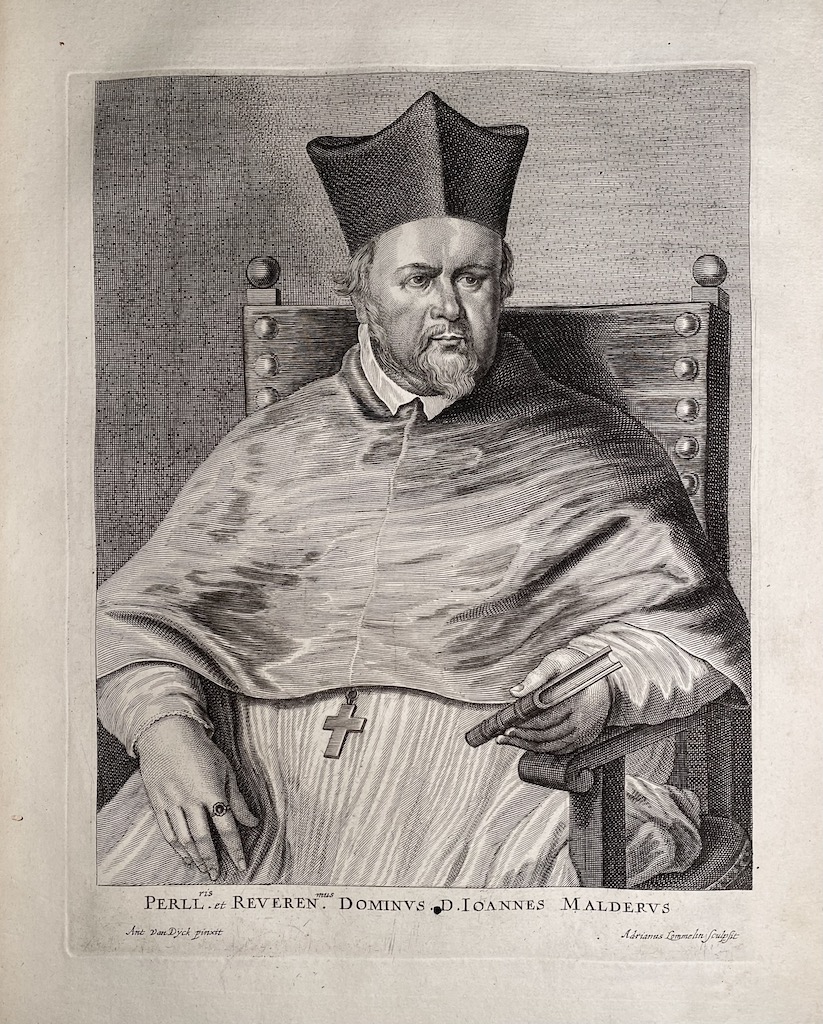 |
25. Jan van Malderus (Flemish, 1563 – 1633); engraved by Adriaen Lommelin. Inscription: “PERLL.ris et REVEREN.mus DOMINVS. D. IOANNES MALDERVS”. In lower margin: “Ant Van Dÿck pinxit” <–> “Adrianus Lommelin sculpsit”. |
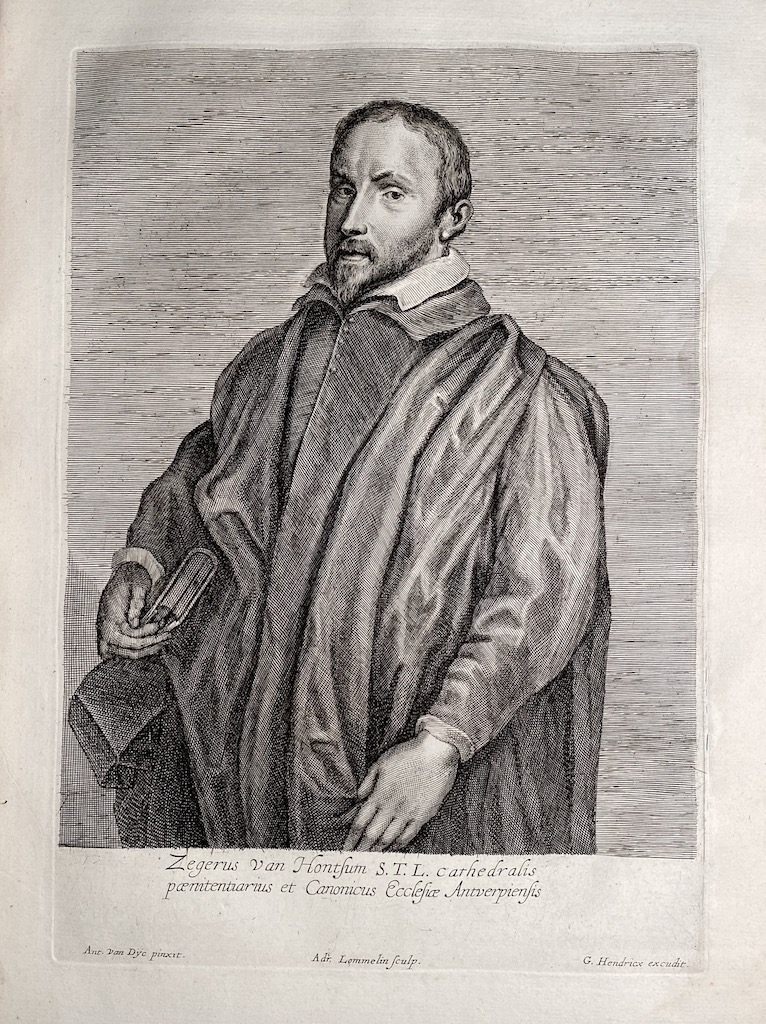 |
26. Zeger van Hontsum (Flemish, ? – -1643). Engraved by Adriaen Lommelin, published by Gillis Hendricx. Inscription: “Zegerus van Hontsum S.T.L. cathedralis | pænitentiarius et Canonicus Ecclesiæ Antuerpiensis”. In lower margin: “Ant. van Dÿc pinxit” <–> “Adr. Lommelin sculp.” <–> “G. Hendricx excudit”. |
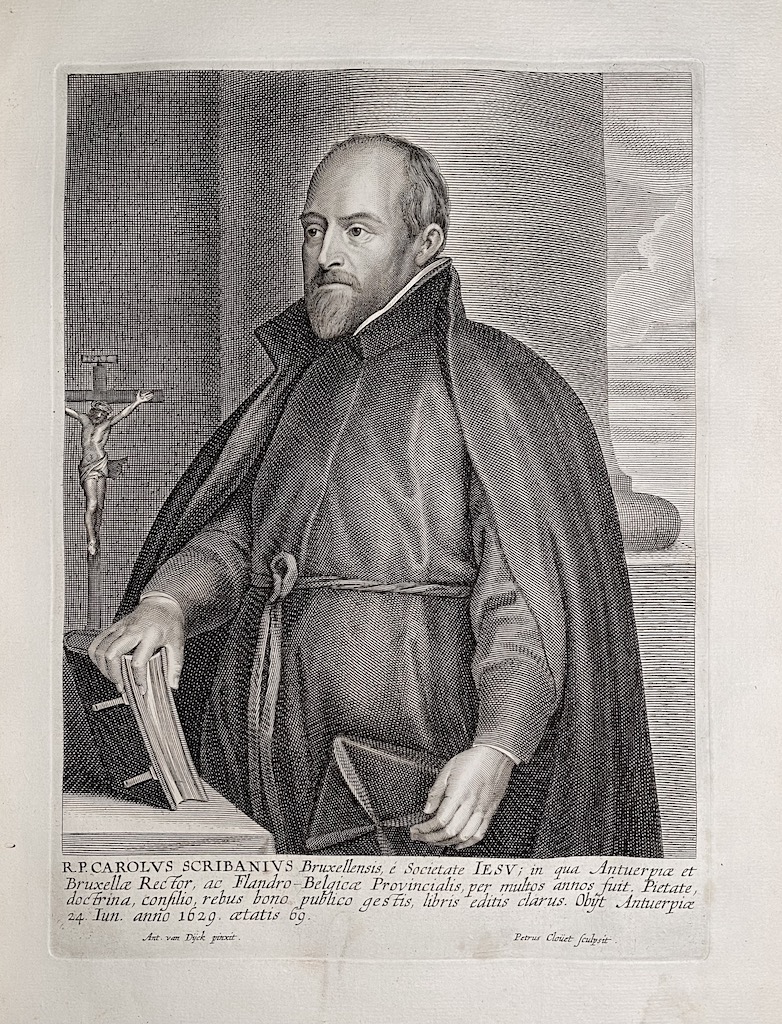 |
27. Carolus Scribani (Flemish, 1561 – 1629); engraved by Pieter Clouwet. Inscription: “R. P. CAROLVS SCRIBANIVS Bruxellensis, é Societate IESV; in qua Antuerpiæ et I Bruxellæ Rector, ac Flandro-Belgicæ Provincialis, per multos annos fuit. Pietate, | doctrina, consilio, rebus bono publico gestis, libris editis clarus. Obijt Antverpiæ | 24. Iun. anno 1629. ætatis 69.”. In lower margin: “Antonius van Dÿck pinxit.” <–> “Petrus Cloüet Sculpsit.”. Second, lettered state with the title and production details. |
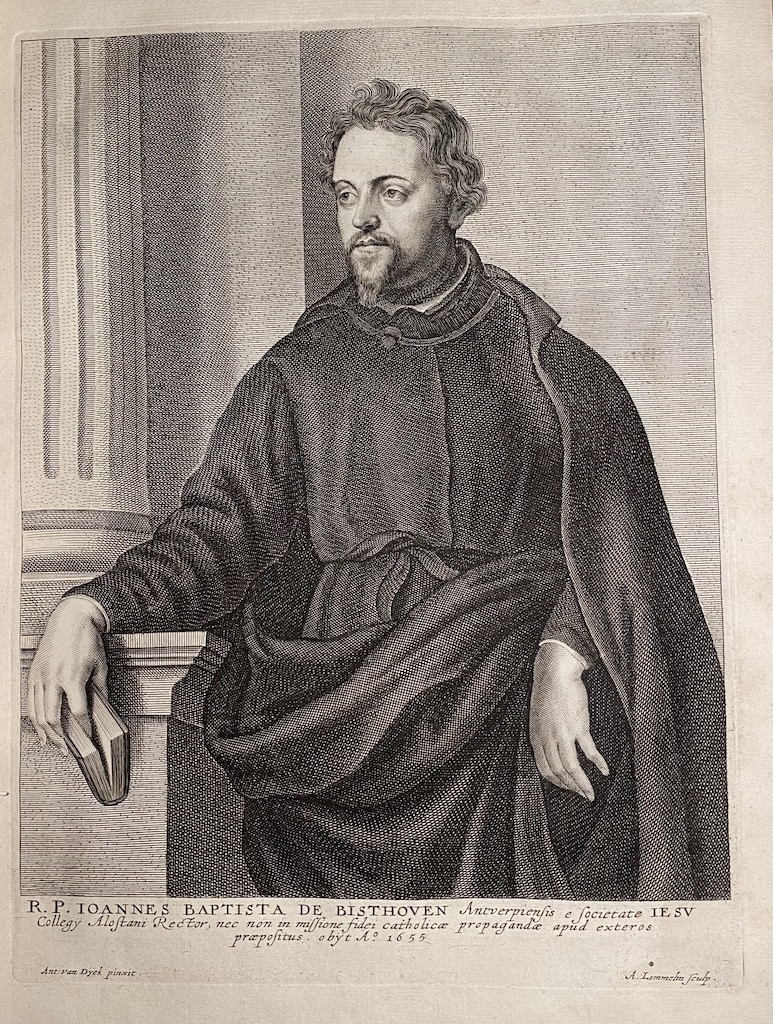 |
28. Jan Baptist van Bisthoven (Flemish, 1602 – 1655); engraved by Adriaen Lommelin. Inscription: “R.P. IOANNES BAPTISTA DE BISTHOVEN Antverpiensis e societate IESV | Collegÿ Alostani Rector, nec non in missione fidei catholicæ propagandæ apud exteros | præpositus obÿt A.o 1655”. In lower margin: “Ant:van Dÿck pinxit”, and “A. Lommelin sculp”. Second, lettered state with the title and production details. |
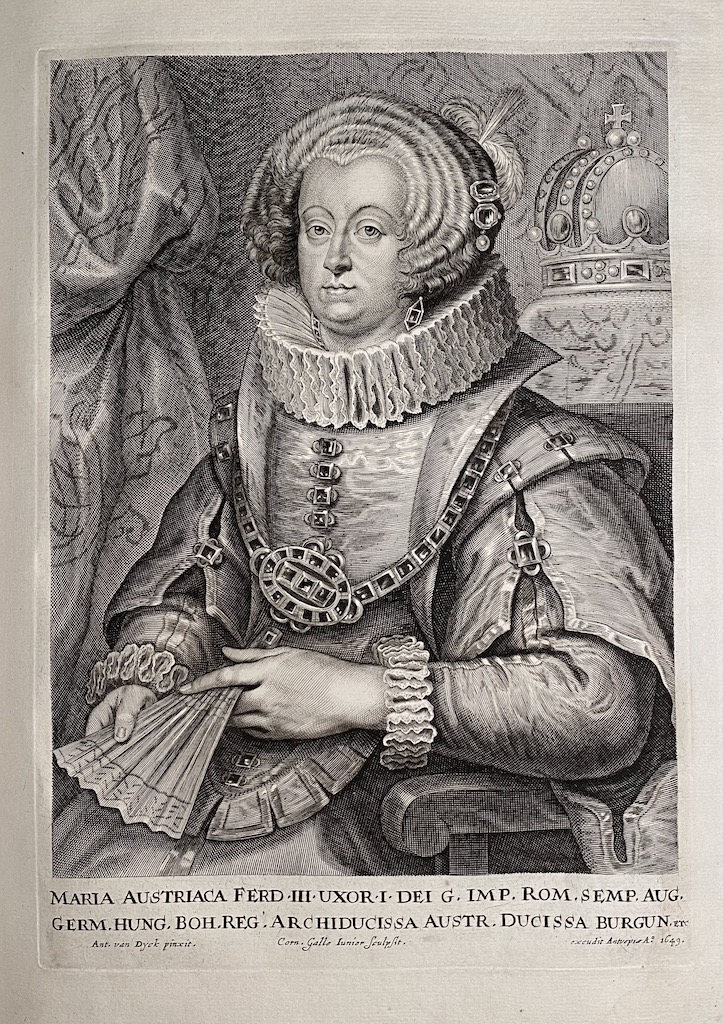 |
29. Maria of Austria (Spanish, 1606 – 1646); engraved by Cornelis Galle the Younger, published by Johannes Meyssens. Inscription: “MARIA AUSTRIACA FERD. III. UXOR. I. DEI G. IMP. ROM. SEMP. AUG. | GERM. HUNG. BOH. REG. ARCHIDUCISSA AUTR. DUCISSA BURGUN. ETC”. In lower margin: “Ant. van Dyck pinxit.” <–> “Corn. Galle Iunior sculpsit.” <–> “...excudit Antuerpiæ A.o 1649”. Third, lettered state with Meyssens’ name burnished badly. |
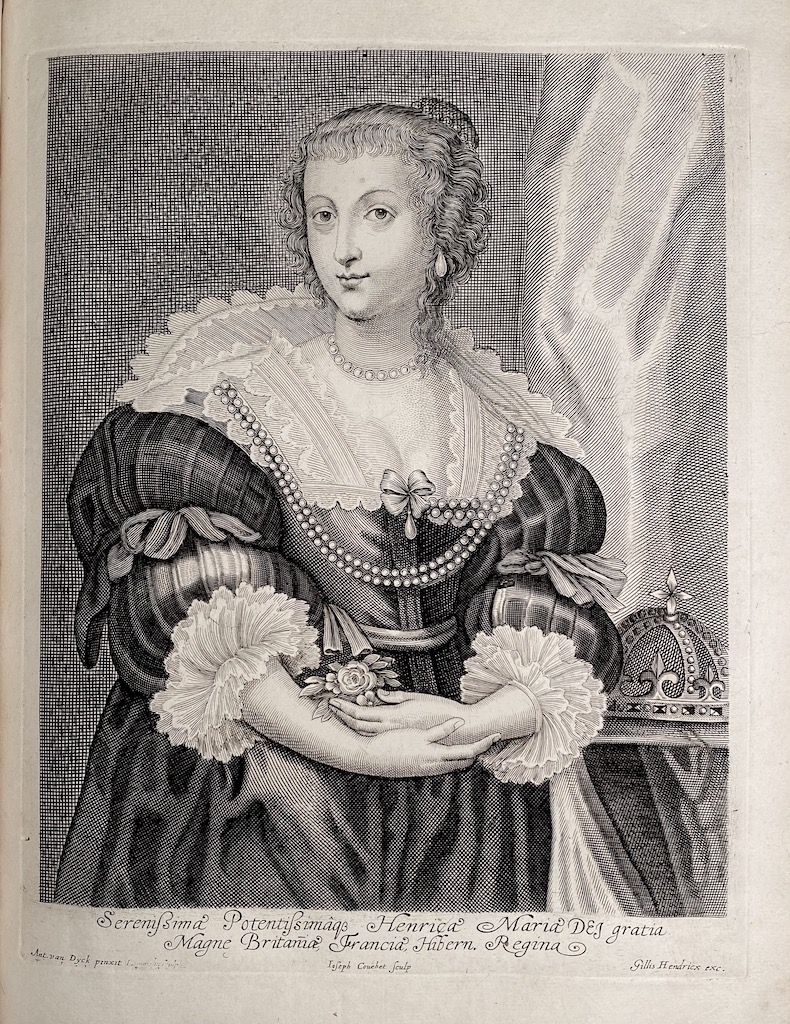 |
30. Henriette Marie de Bourbon, Queen of Charles I (French, 1609 – 1669); engraved by Antoine Couchet and Adriaen Lommelin, published by Gillis Hendricx. Inscription: “Serenißima Potenti∫simâq Henrica Maria Dei gratia | Magne Britaniæ, Franciæ, Hibern. Regina”. In lower margin: “Ant. van Dyck pinxit” <–> “Ioseph Couchet sculp” <–> “Gillis Hendricx exc.”. State with “Lommelin sculp.” right after “Ant. van Dyck pinxit” burnished, but still legible. |
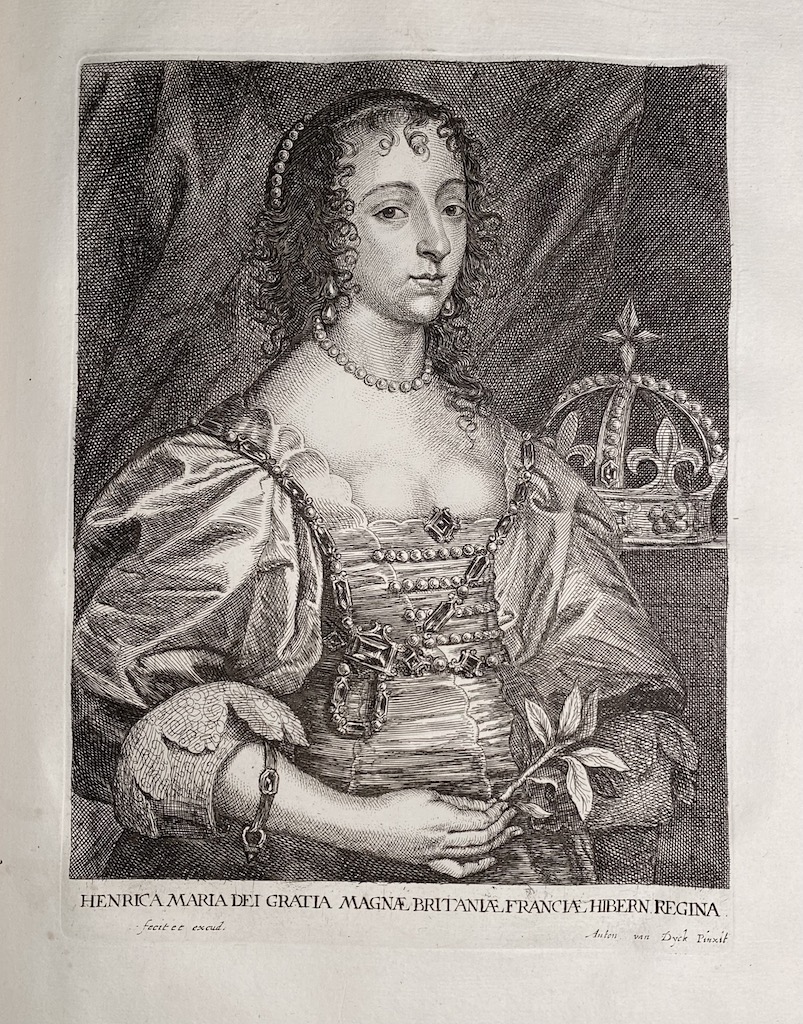 |
31. Henriette Marie de Bourbon, engraved and published by Ioannes Meyssens. Inscription: “HENRICA MARIA DEI GRATIA MAGNÆ BRITANIÆ FRANCIAÆ HIBERN. REGINA.”. In lower margin: “fecit et excud.” <–> “Anton van Dyck Pinxit”. Third state, finished with a burin; with Meyssens’ name burnished. [Similar to print №62 which has "Ioan. Mey∫ens" signature present]. |
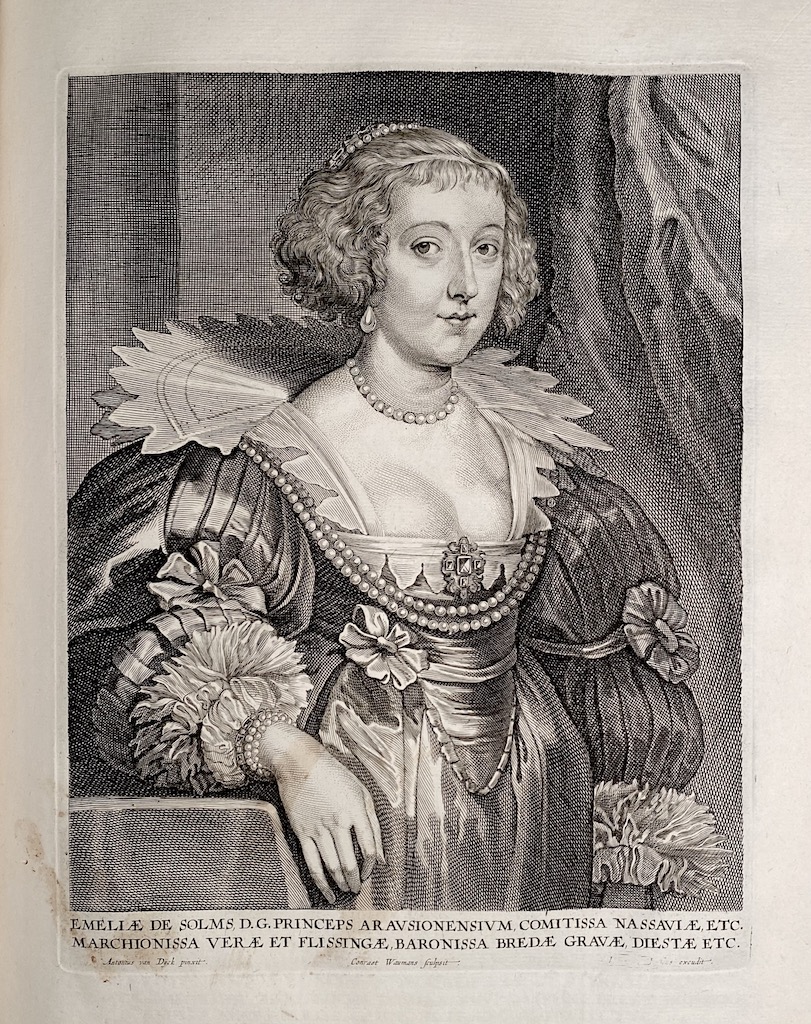 |
32. Amalia van Solms, Princess of Orange (German, 1602 – 1675), engraved by Conraad Waumans and published by Johannes Meyssens. Inscription: “EMELIÆ DE SOLMS, D. G. PRINCPES ARAVSIONENSIVM, COMITISSA NASSAUVIÆ, ETC. | MARCHIONISSA VERÆ ET FLISSINGÆ, BARONISSA BREDÆ, GRAVÆ, DIESTÆ ETC.”. In lower margin: “Antonius van Dijck pinxit.” <–> “Conraet Waumans sculpsit.” <–> “… excudit”. First, lettered state with the title and production details, with Meyssens’ name burnished. [Similar to №66, which has Ioannes Meysens name present]. |
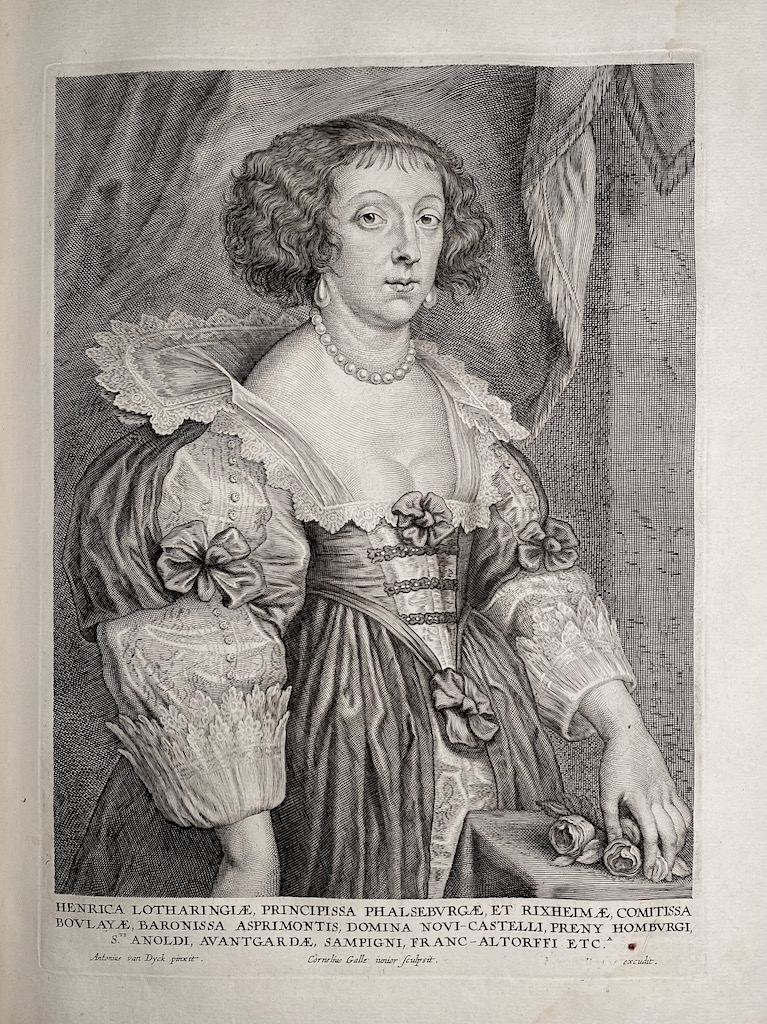 |
33. Henriette de Lorraine, Princess of Phalsbourg (or Pfalzburg) (French, 1605 – 1660); engraved by Cornelis Galle the Younger, published by Ioannes Meyssens. Inscription: “HENRICA LOTHARINGIÆ, PRINCIPISSA PHALSEBVRGÆ, ET RIXHEIMÆ, COMITISSA | BOVLAYÆ, BARONISSA ASPIRIMONTIS, DOMINA NOVI-CASTELLI, PRENY | HOMBVRGI, S.TI ANOLDI, AVANTGARDÆ, SAMPIGNI, FRANC-ALTORFFI ETC.A”. In lower margin: “Antonius van Dyck pinxit.” <–> “Cornelius Galle iunior sculpsit.” <–> “… excudit.”. First state with the title and production details, with Ioannes Meyssens’ name burnished. British Museum # R,1a.248. |
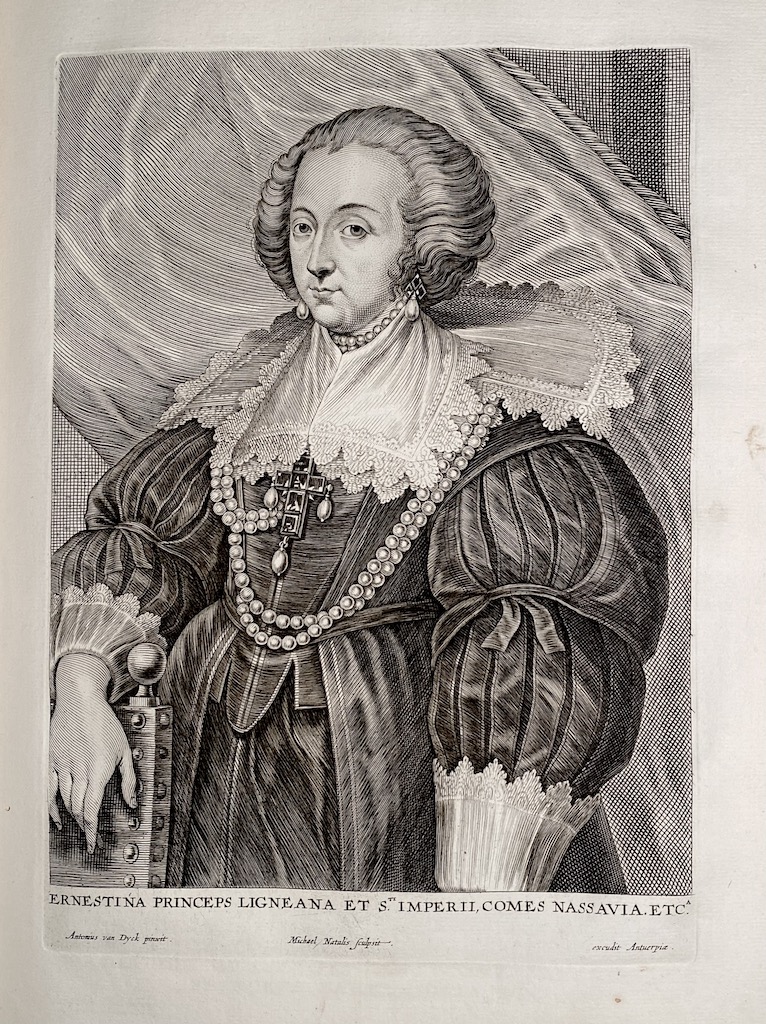 |
34. Ernestine Yolande de Ligne, Countess of Nassau-Siegen (Flemish, 1594 – 1668); engraved by Michiel Natalis, published by Jan Meyssens. Inscription: “ERNESTINA PRINCEPS LIGNEANA ET S.TI IMPERII, COMES NASSAVI. ETC.A”. In lower margin: “Antonius van Dyck pinxit.” <–> “Michael Natalis sculpsit.” <–> “…excudit Antuerpiæ.”. Second state with the initials of Ioannes Meyssens erased. |
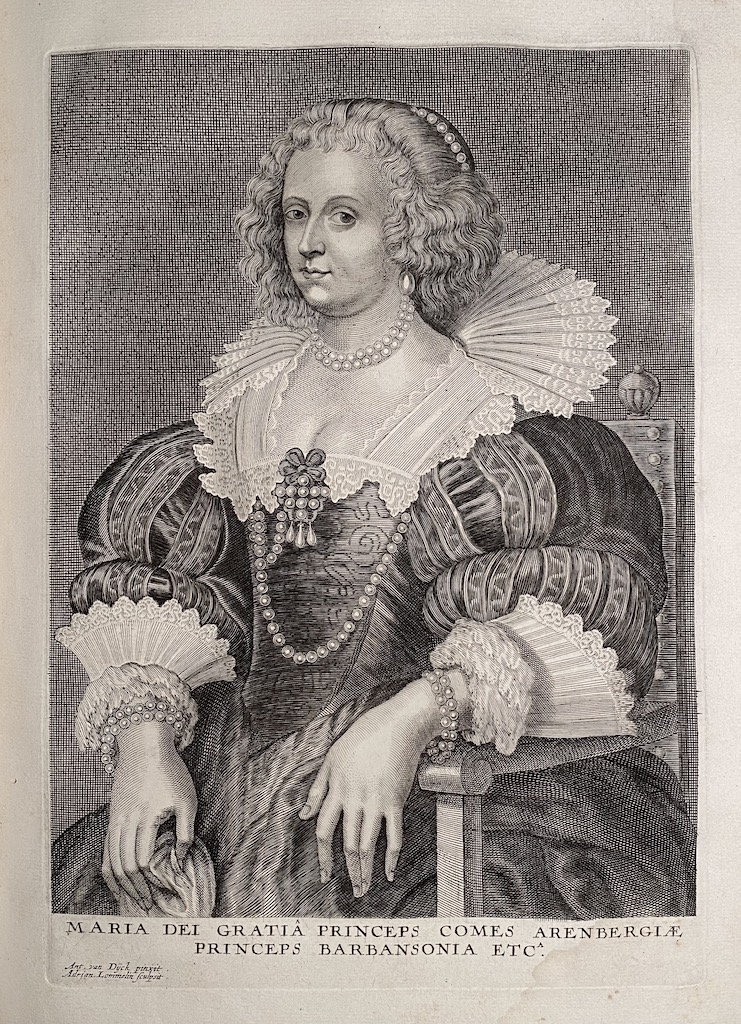 |
35. Marie de Barbançon, Princess of Arenberg (1602 – 1675); engraved by Adriaen Lommelin. Inscription: “MARIA DEI GRATIÂ PRINCEPS COMES ARENBERGIÆ | PRINCEPS BARBASONIA ETC.A”. In lower margin: “Ant. van Dÿck pinxit. | Adrian. Lommelin sculpsit.”. Second, lettered state with title and production details and adjustments made in the face. British Museum # 1876,1014.181 |
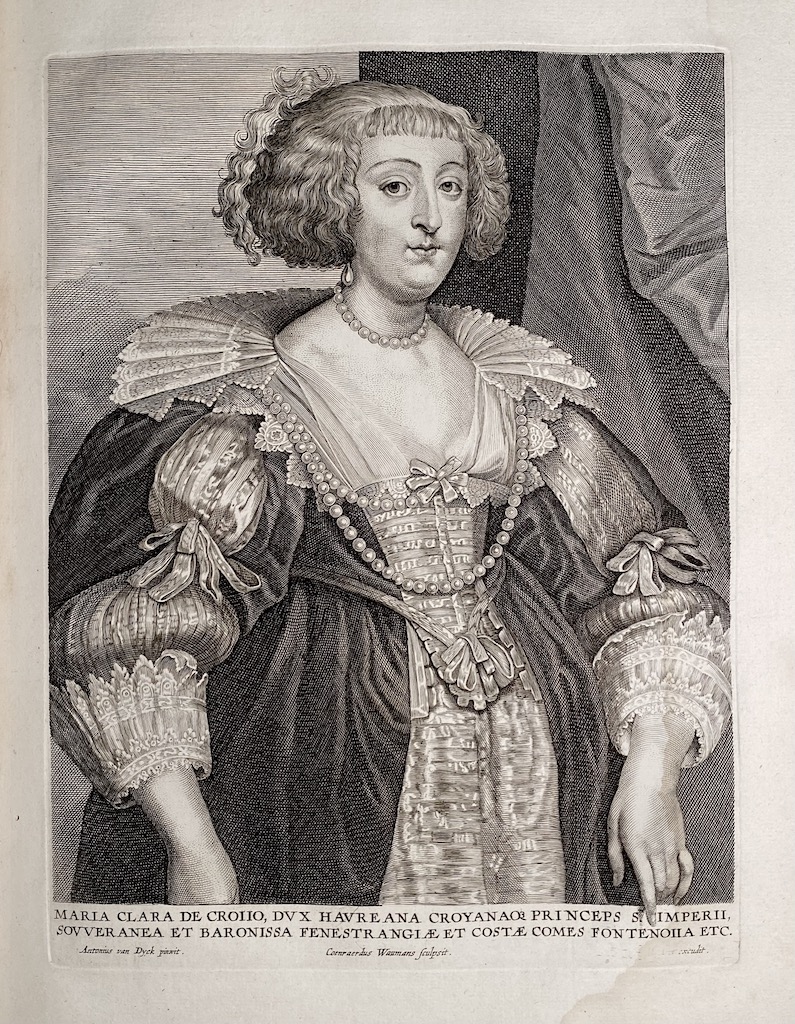 |
36. Marie-Claire de Croy, Duchess of Havré (Flemish, 1605 – 1664); engraved by Conraad Waumans, published by Ioannes Meyssens. Inscription: “MARIA CLARA DE CROIIO, DVX HAVREANA CROYANAQ3 PRINCEPS STE. IMPERII, | SOVVERANEA ET BARONISSA FENESTRANGIÆ ET COSTÆ COMES FONTENOIIA ETC.”. In lower margin: “Antonius van Dyck pinxit.” <–> “Coenraerdus Waumans sculpsit.” <–> “…excudit.”. Third state with Ioannes Meyssens’ name burnished. British Museum # 1891,1015.21. [Similar to №64, which has Ioannes Meysens’ name present]. |
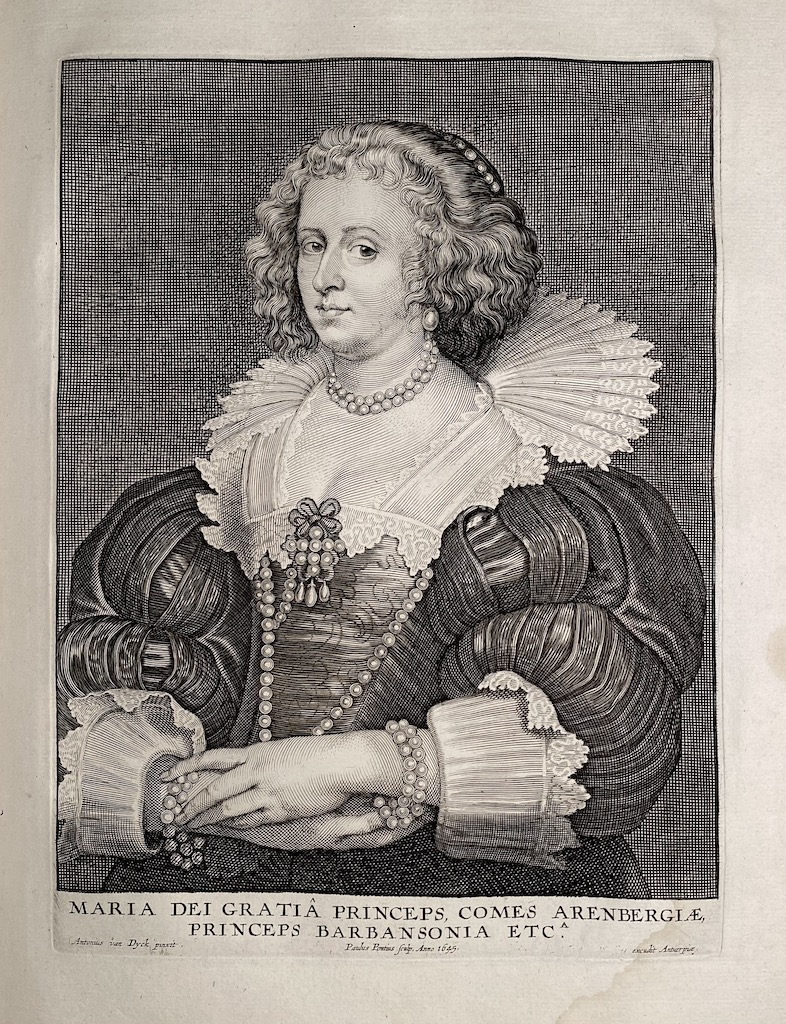 |
37. Marie de Barbançon, Princess of Arenberg (1602 – 1675); engraved by Paulus Pontius, published by Ioannes Meyssens. Inscription: “MARIA DEI GRATIÂ PRINCEPS COMES ARENBERGIÆ, | PRINCEPS BARBASONIA ETC.A”. In lower margin: “Antonius van Dyck pinxit. | Paulus Pontius sculp. Anno 1645.” <–> “… excudit Antuerpiæ”. Second state with a thick borderline, title and production details added, Ioannes Meyssens’s name burnished. |
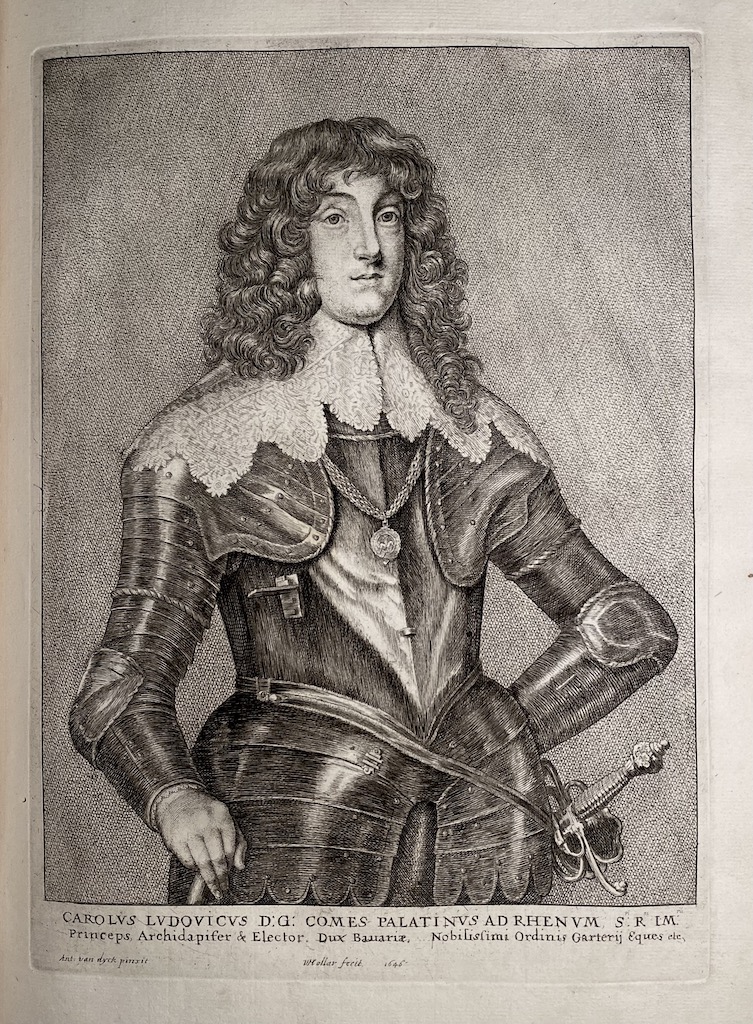 |
38. Karl I Ludwig, Elector Palatine (German, 1617 – 1680); engraved by Wenceslaus Hollar (Bohemian, 1607 – 1677). Inscription: “CAROLVS LVDOVICVS D:G: COMES PALATINVS AD RHENVM, S:ri R.ni IM:rii | Princeps, Archidapifer & Elector, Dux Bauariæ, …Nobilissimi Ordinis Garterij Eques etc.”. Below: “Ant: van Dyck pinxit” <–> “WHollar fecit,” <–> “1646”. First, lettered state with the title and production details, without “H: van de Borcht excu:”. British Museum # 1867,1012.598. Hendrik van der Borcht II (Dutch, 1614 – c. 1690) |
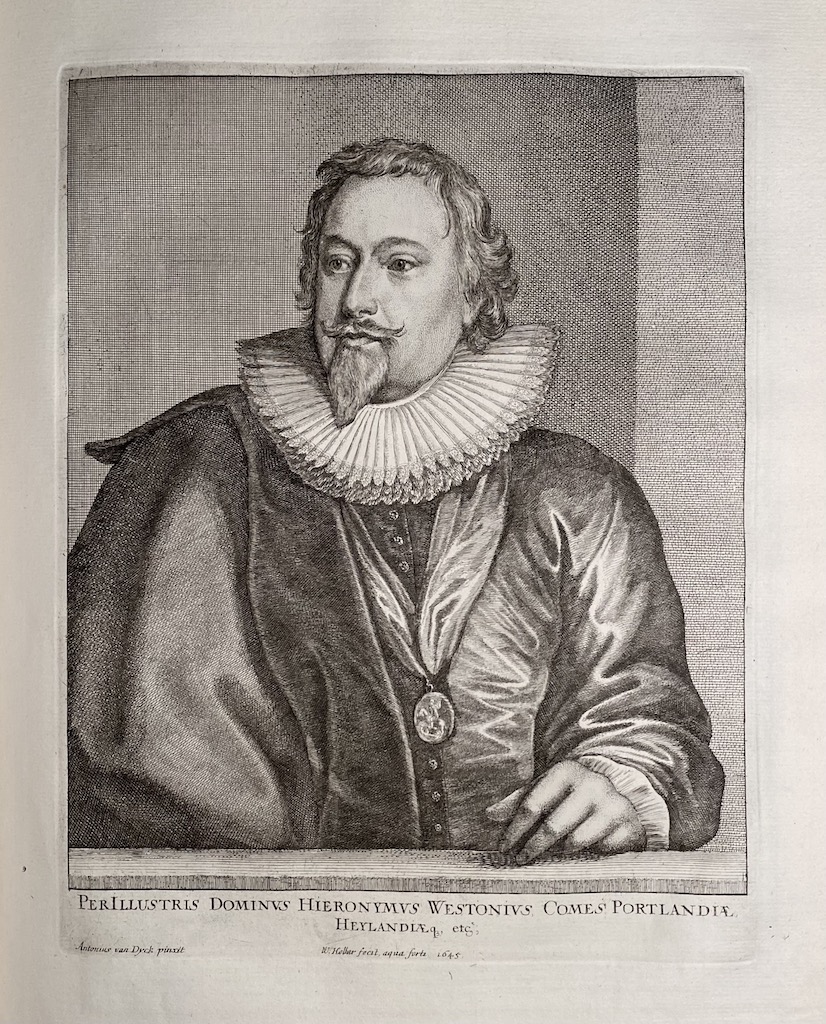 |
39. Richard Weston, 1st Earl of Portland (British, 1577 – 1635); engraved by Wenceslaus Hollar, published by Ioannes Meyssens. Inscription: “PERILLUSTRIS DOMINVS HIERONYMVS WESTONIVS, COMES PORTLANDIÆ, | HEYLANDÆq3, etc’,”. Below: “Antonius van Dyck pinxit”<–> “W: Hollar fecit, aqua forte. 1645”. Ioannes Meyssens’s name completely burnished. |
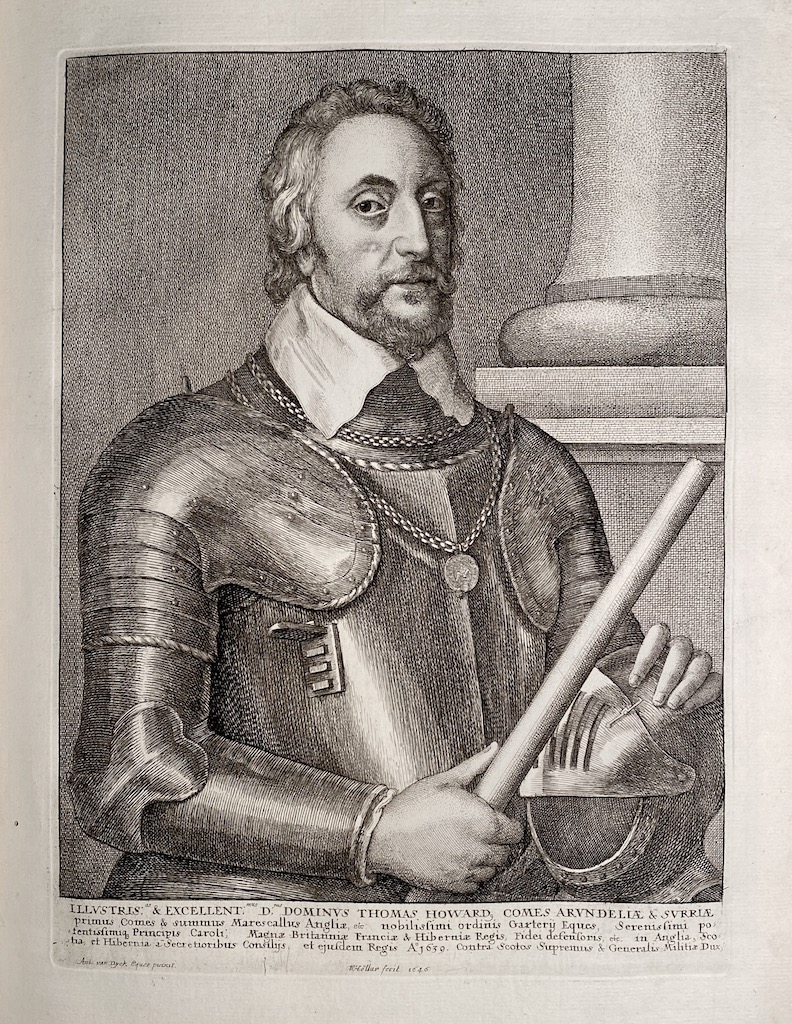 |
40. Thomas Howard, 14th Earl of Arundel (British, 1585 – 1646); engraved by Wenceslaus Hollar, published by Ioannes Meyssens. Inscription: "ILLVSTRIS:us & EXCELLENT:mus D:nus. DOMINVS THOMAS HOWARD, COMES ARXNDELIÆ & SVRRIÆ | primus Comes & summus Marescallus Angliæ, etc nobilisimi ordiuis Garterÿ Eques, Serenis∫imi po: | tentis∫imq3 Principis Caroli: Magnæ Britanniæ & Hiberniæ Regis, Fidei defen∫oris, etc. in Anglia, Sco | tia et Hibernia a Secretioribus Consilijs, et eju∫dem Regis Ao1639. Contra | Scotos Supremus & Generalis Militiæ Dux,”. In lower margin: “Ant: van Dyck Eques pinxit” <–> “WHollar fecit 1646”. Second state with Ioannes Meyssens’s name completely burnished. |
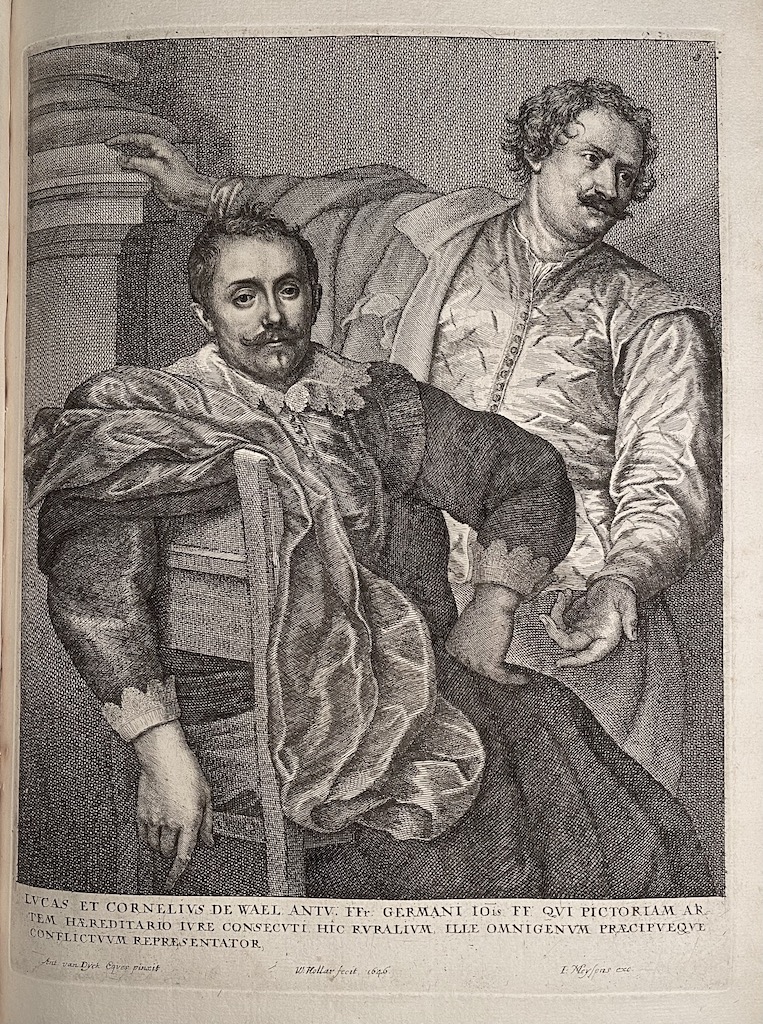 |
41. Lucas de Wael (Flemish, 1591 – 1661) and Cornelis de Wael (Flemish, 1592 – 1667); engraved by Wenceslaus Hollar, published by Ioannes Meyssens. Inscription: “LVCAS ET CORNELIVS DE WAEL ANTV: FFr. GERMANI IOis QUI PICTORIAM AR | TEM HÆREDITARIO IVRE CONSECVTI HIC RVRALIVM, ILLE OMNIGENVM PRÆCIPVEQVE / CONFLICTVVM REPRÆSENTATOR.”. In lower margin: “Ant. van Dyck Eques pinxit.” <–> “W: Hollar fecit, 1646.” <–> “I: Meysens exc”. First, lettered state with the title and production details. |
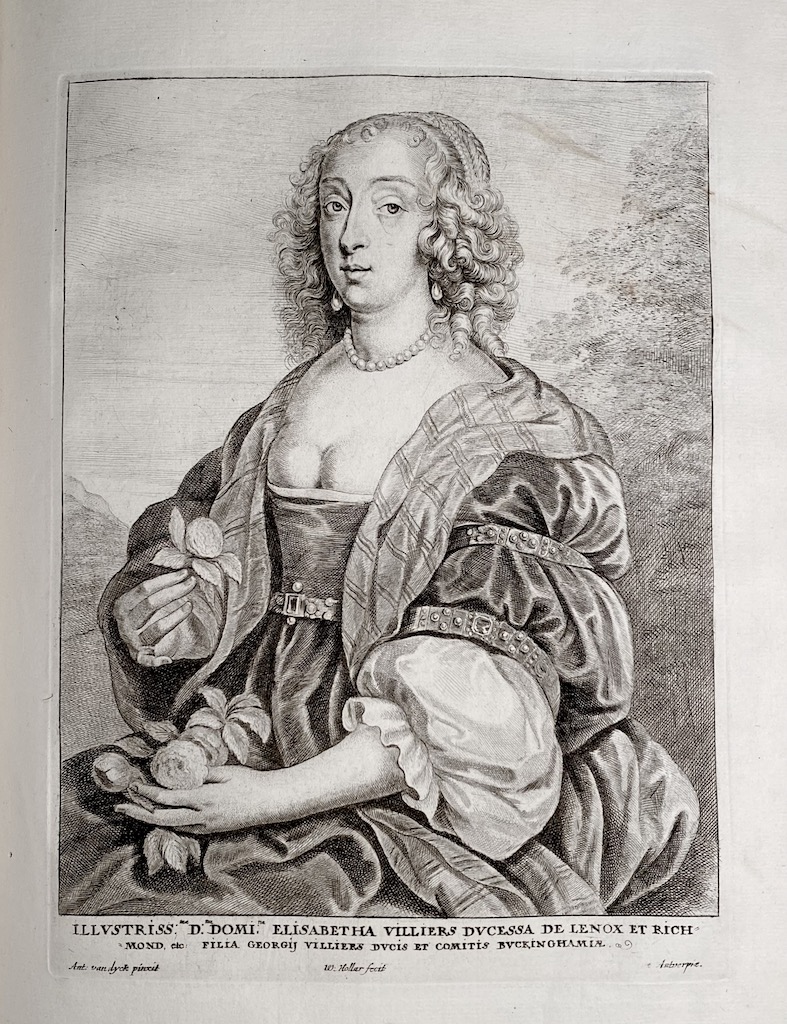 |
42. Mary (Elisabetha ) Villiers, Duchess of Lennox and Richmond (British, 1622 – 1685); engraved by Wenceslaus Hollar, published by Ioannes Meyssens. Inscription: “ILLUSTRISS: ma D:ma DOMI.na ELISABETHA VILLIERS DVCESSA DE LENOX ET RICH | MOND. etc: FILIA GEORGIJ VILLIERS DVCIS ET COMITIS BVCKINGHAMIÆ.”. In lower margin: “Ant: van dyck pinxit” <–> “W:Hollar fecit” <–> “… Antverpiæ.”. Ioannes Meyssens’ name completely burnished. First state with the title and production details. |
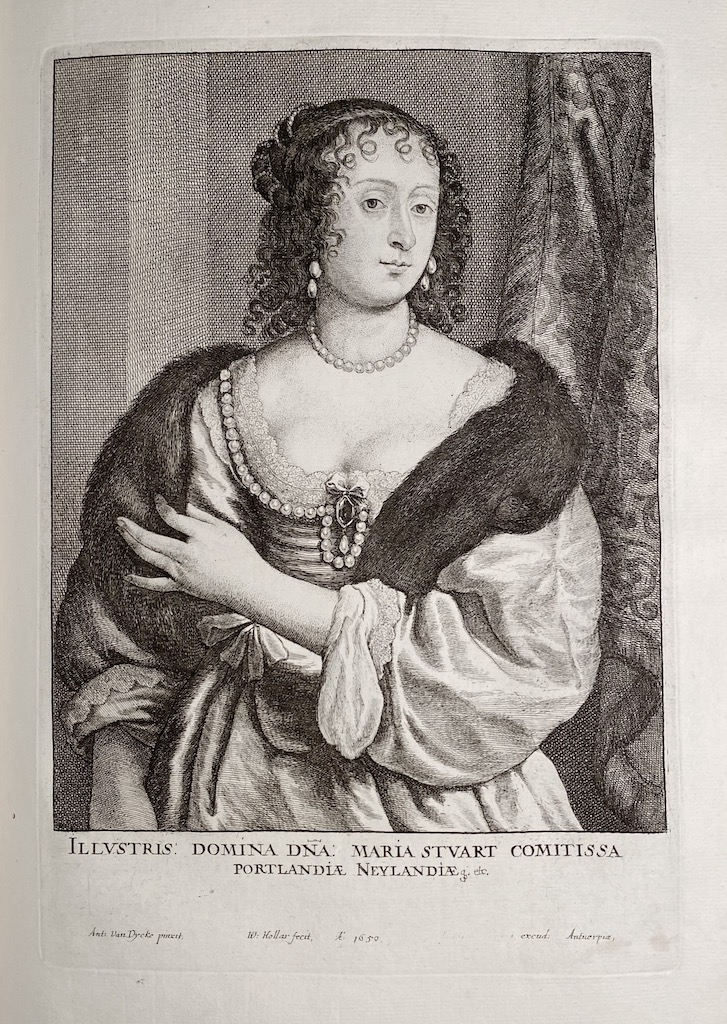 |
43. Frances (Maria) Stuart, Countess of Portland (British, 1617 – 1694); engraved by Wenceslaus Hollar, published by Ioannes Meyssens. Inscription: “ILLVSTRIS: DOMINA DNA: MARIA STVART COMITISSA | PORTLANDIÆ NEYLANDIÆ, etc.”. Below: “Ant: Van Dycke pinxit,” <–> “W: Hollar fecit, A:o 1650,”, “...excud: Antuerpiæ,”. Second state with Meyssens’ name burnished. British Museum # 1853,0112.1761 |
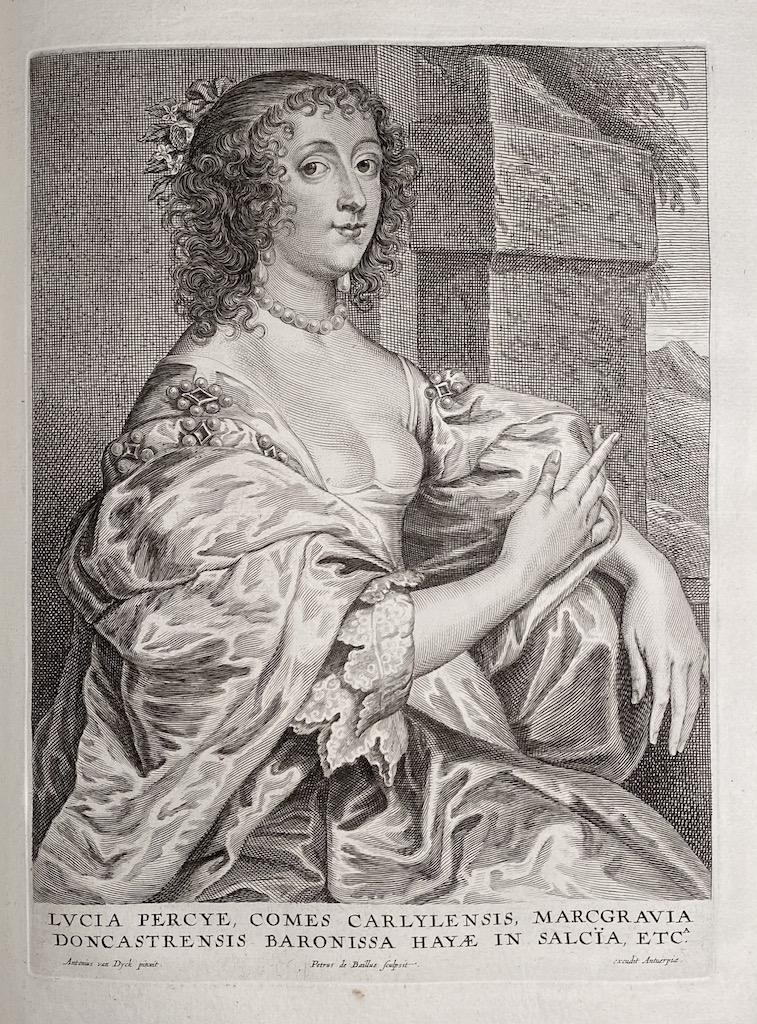 |
44. Lucy Percy, Countess of Carlisle (British, 1599 – 1660); engraved by Pieter de Bailliu, published by Ioannes Meyssens. Inscription: “LVCIA PERCYE, COMES CARLYLENSIS, MARCGRAVIA | DONCASTRENSIS BARONISSA HAYÆ IN SALCÏA, ETC.A”. In lower margin: “Antonius van Dyck pinxit.” <–> “Petrus de Baillue sculpsit.” <–> “...excudit Antuerpia.”. Third, lettered state with Joannes Meyssens’ name burnished. |
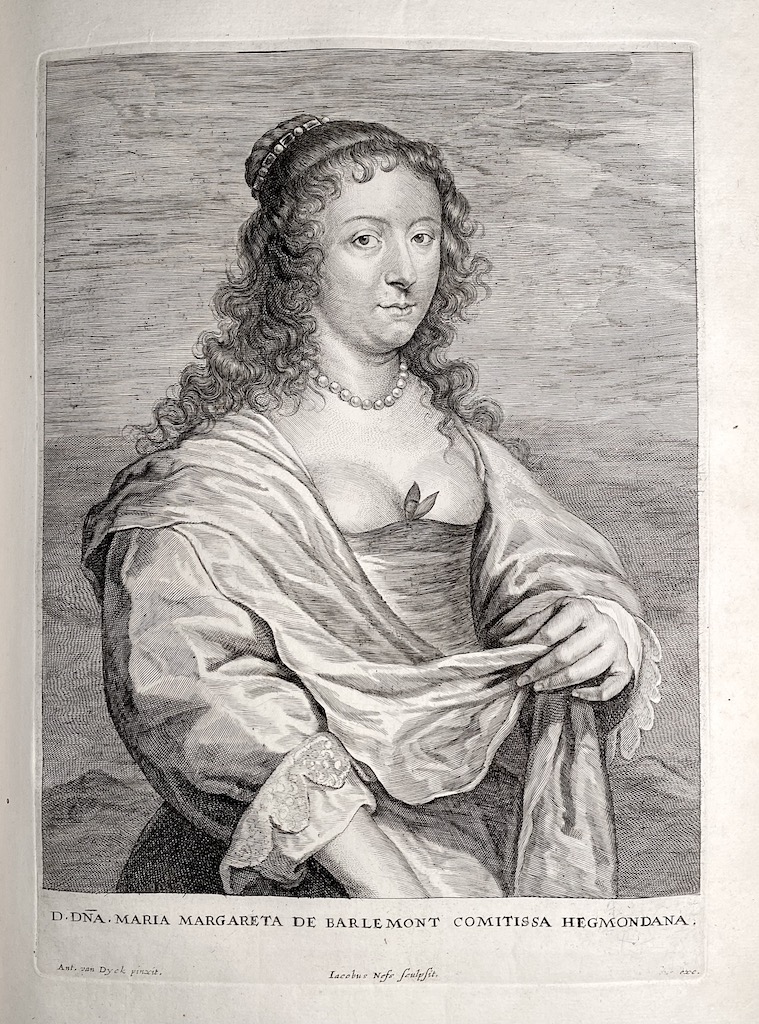 |
45. Marie-Marguerite de Berlaymont ( ? – 1654); engraved by Jacobus Neeffs, published by Ioannes Meyssens. Inscription: “D.DNA. MARIA MARGARETA DE BARLEMONT COMITISSA HEGMONDANA.” In lower margin: “Ant. van Dyck pinxit.” <–> “Iacobus Nefs sculpsit.”<–> “...exc.”. Fourth state with Ioannes Meyssens’ name erased. British Museum # 1876,1014.206. [Similar to №67, which has Ioannes Meysens name present]. |
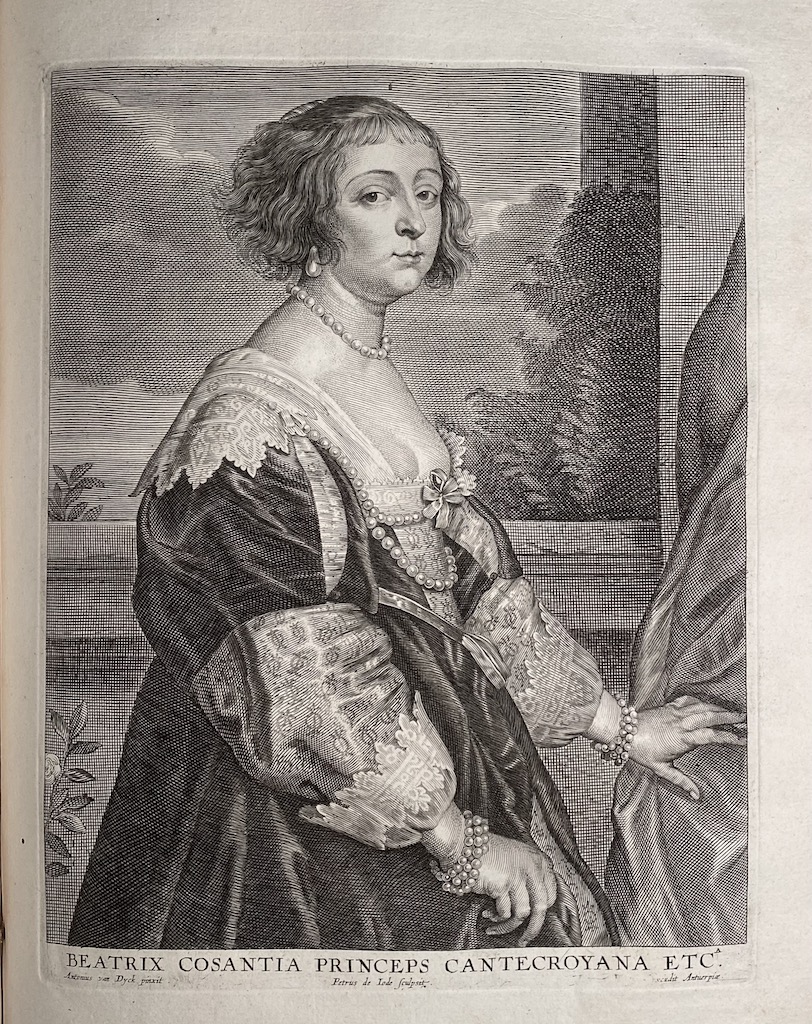 |
46. Béatrix Constance de Cussance, Princess of Cantecroix (French, 1614 – 1663); engraved by Pieter de Jode II, published by Ioannes Meyssens. Inscription: “BEATRIX COSANTIA PRINCEPS CANTECROYANA ETC.A”. In lower margin: “Antonius van Dyck pinxit” <–>“Petrus de Iode sculpsit.” <–> “… excudit Antuerpiæ.”. Second, lettered state with Meyssens’ name burnished. |
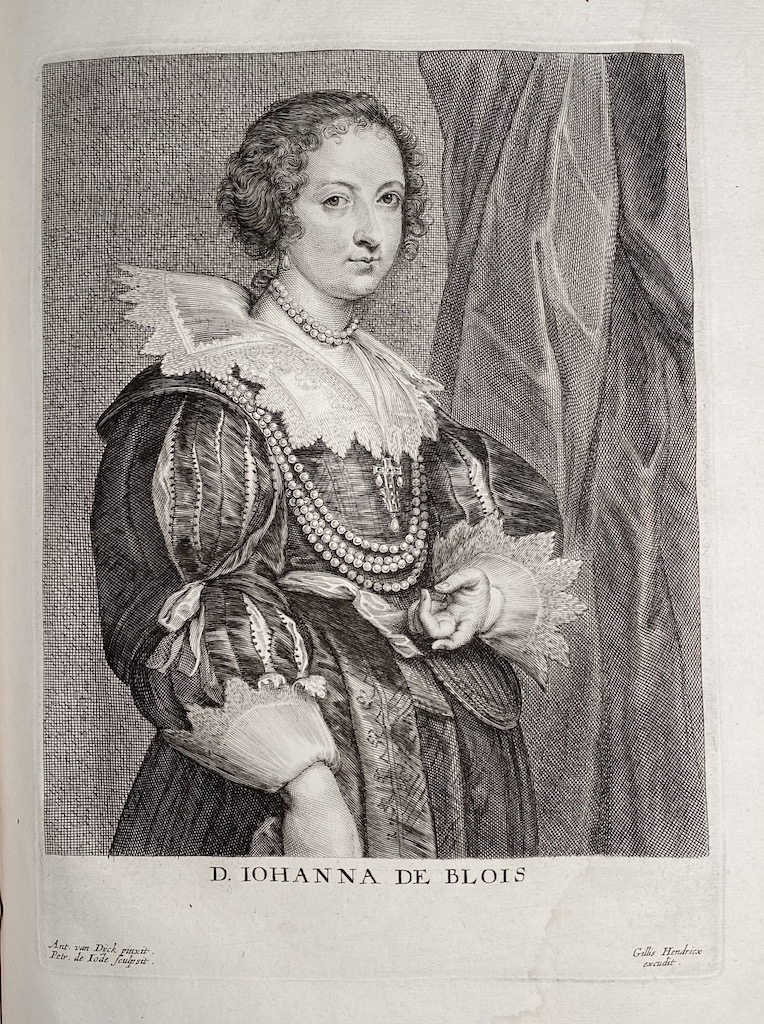 |
47. Johanna de Blois; engraved by Pieter de Jode II, published by Gillis Hendricx. Inscription: “D. IOHANNA DE BLOIS”. In the lower margin: “Ant. van Dÿck pinxit | Petr. de Iode sculpsit” <–> “Gillis Hendricx | excudit.”. British Museum # 1876,1014.189. |
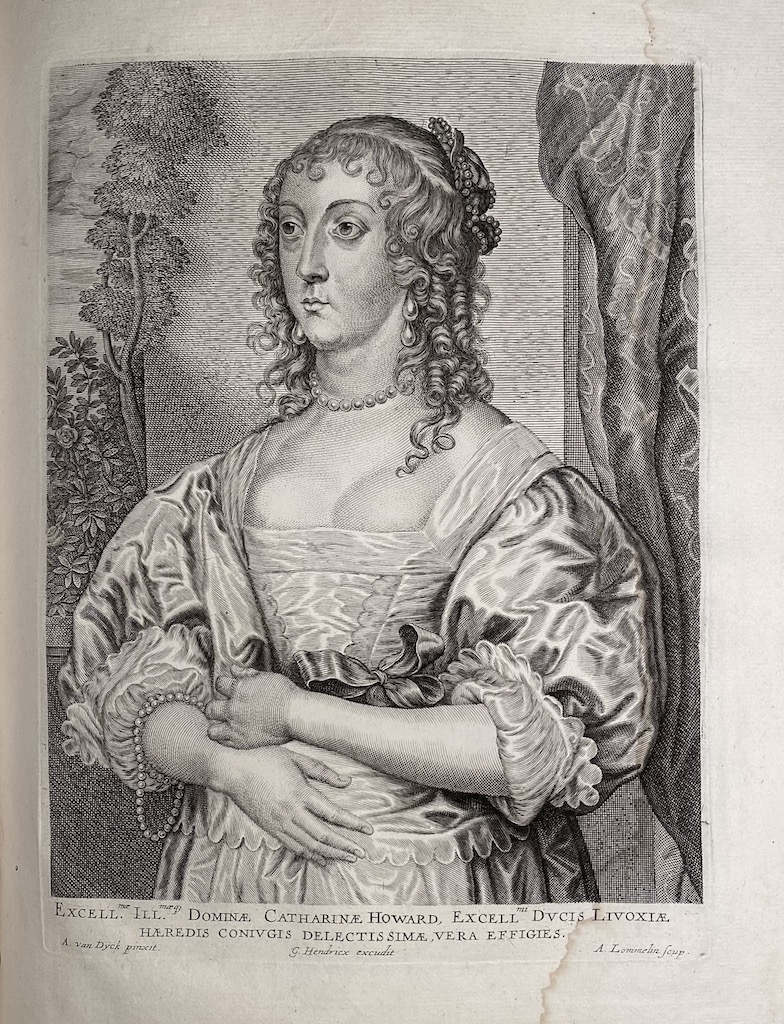 |
48. Katherine Howard, Countess of Newburgh, Lady d’Aubigny (British, ? – 1650); engraved by Adriaen Lommelin, published by Gillis Hendricx. Inscription: “EXCELLmæ ILL.mæq3 DOMINÆ CATHARINÆ HOWARD, EXCELLmi DUCIS LIVOXIÆ | HÆREDIS CONIUGIS DELECTISSIMÆ, VERA EFFIGIES.” In lower margin: “A. van Dÿck pinxit.” <–> “G. Hendricx excudit” <–> “A. Lommelin scup.”. British Museum # P,3.326 |
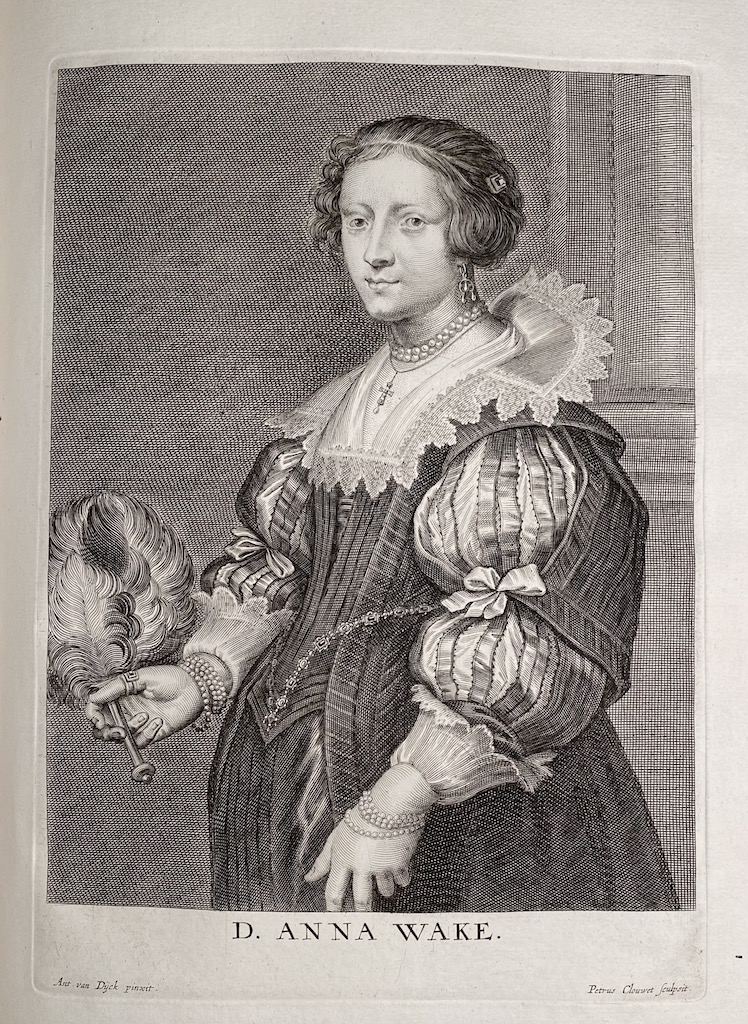 |
49. Anna Wake (Flemish, 1606 – 1680); engraved by Pieter Clouwet. Inscription: “D. ANNA WAKE.”. In lower margin: “Ant. van Dÿck pinxit.” <–> “Petrus Clouwet sculpsit”. |
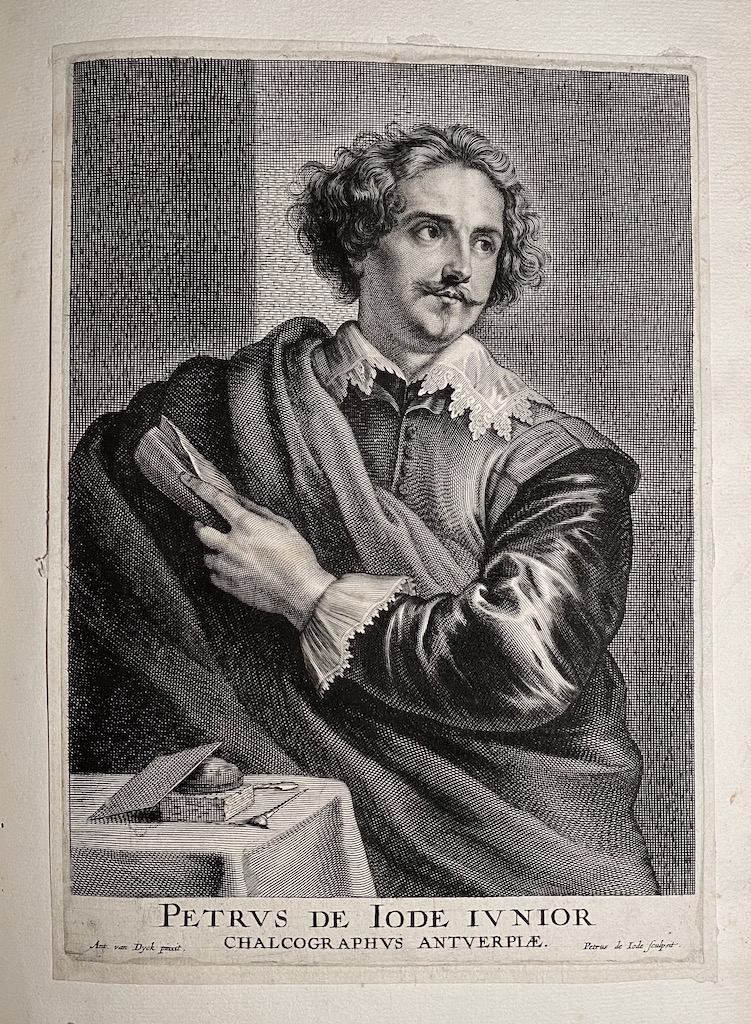 |
50. Pieter de Jode II (Flemish, 1606-1670/74); engraved by Pieter de Jode II. Inscription: “PETRVS DE IODE IVNIOR / CHALCOGRAPHVS ANTVERPIÆ.”. In lower margin: “Ant. van Dyck pinxit.”<–> “Petrus de Iode sculpsit.”. Third state (before the initials G.H. (of Gillis Hendricx) added. The print with cut off margins pasted to the bound-in leaf. |
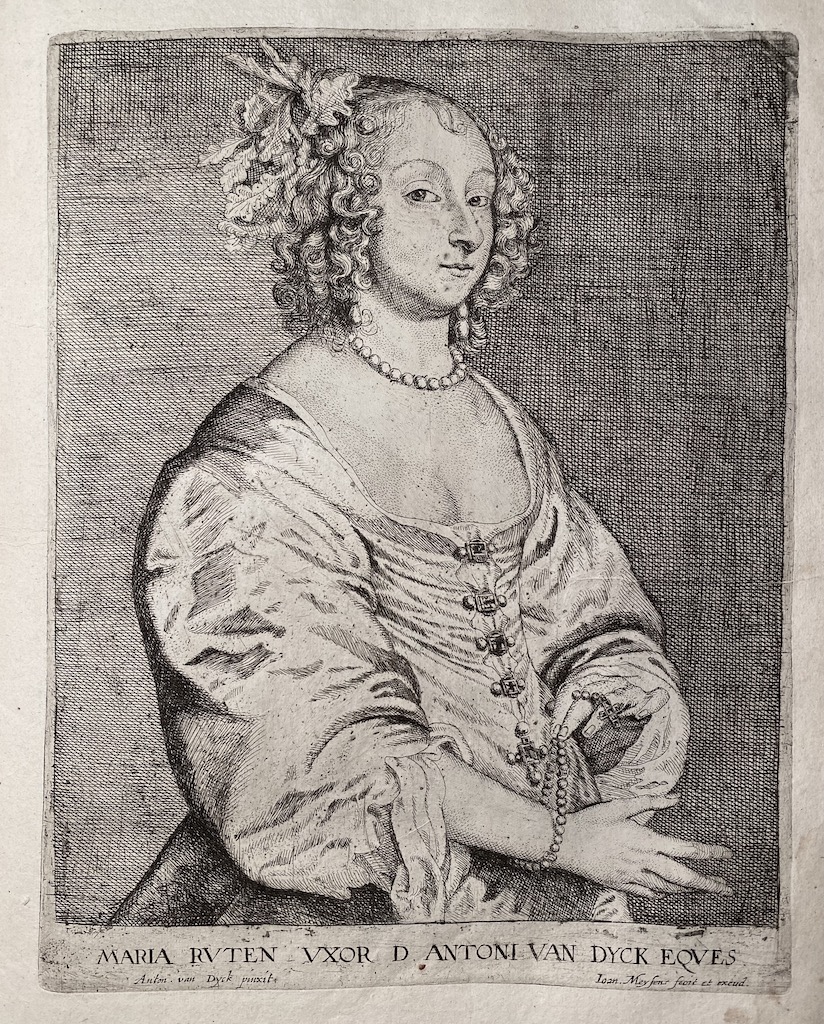 |
51. Mary Ruthven, Lady van Dyck (Scottish, c. 1622 – 1645); engraved and published by Ioannes Meyssens. Inscription: “MARIA RVTEN VXOR D. ANTONI VAN DYCK EQVES”. In lower margin: “Anton.van Dyck pinxit” <–> “Ioan. Meysens fecit et excud.”. First, lettered state with the title and production details. Tired plate. British Museum # 1863,0725.747. Van Dyck's wife. |
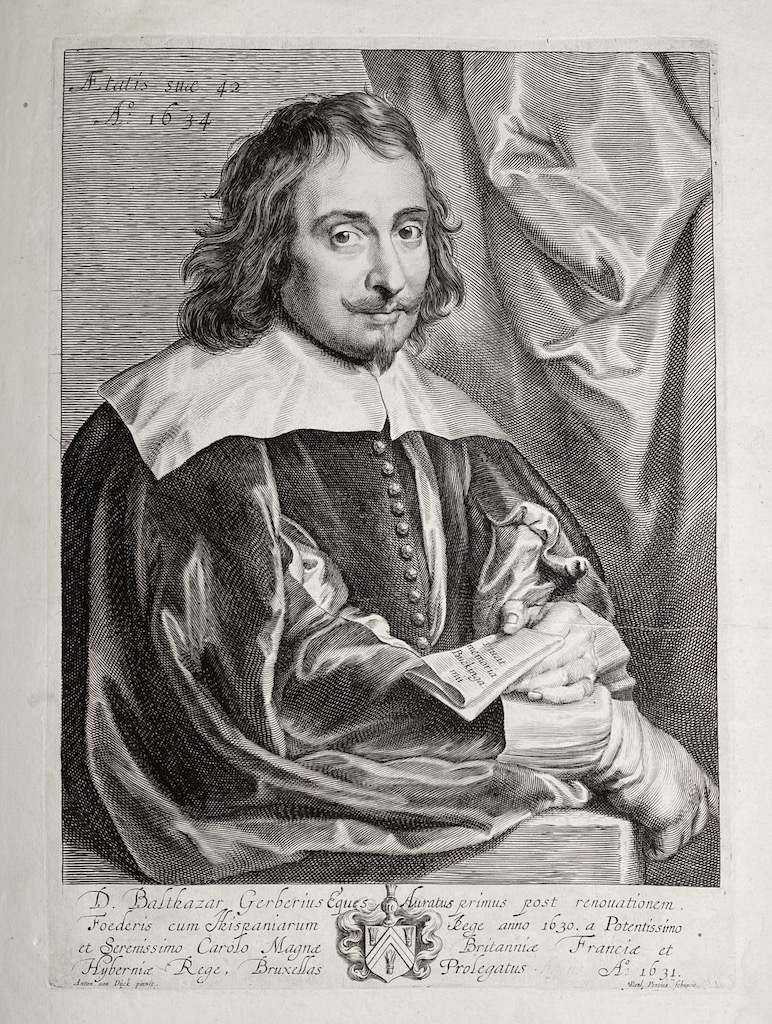 |
52. Sir Balthazar Gerbier (British, Flemish, 1592 – 1663); engraved by Paulus Pontius. Inscription: “D. Balthazar Gerberius Eques Auratus primus post renouationem. | Foederis cum Hispaniarum Rege anno 1630. A Potentissimo | et Serenissimo Carolo Magnæ Britanniæ Franciæ et Hiberniæ. Rege, Bruxellas Prolegatus. A:o 1631”. Below “Anton van Dyck pinxit”<–> “Paul Pontius schupcit.”. Top left corner: “Ætatis suæ 42 | A.o 1634”. The paper in Gerbier’s hand is lettered “viuat | memoria | Buckinga: | mii”. |
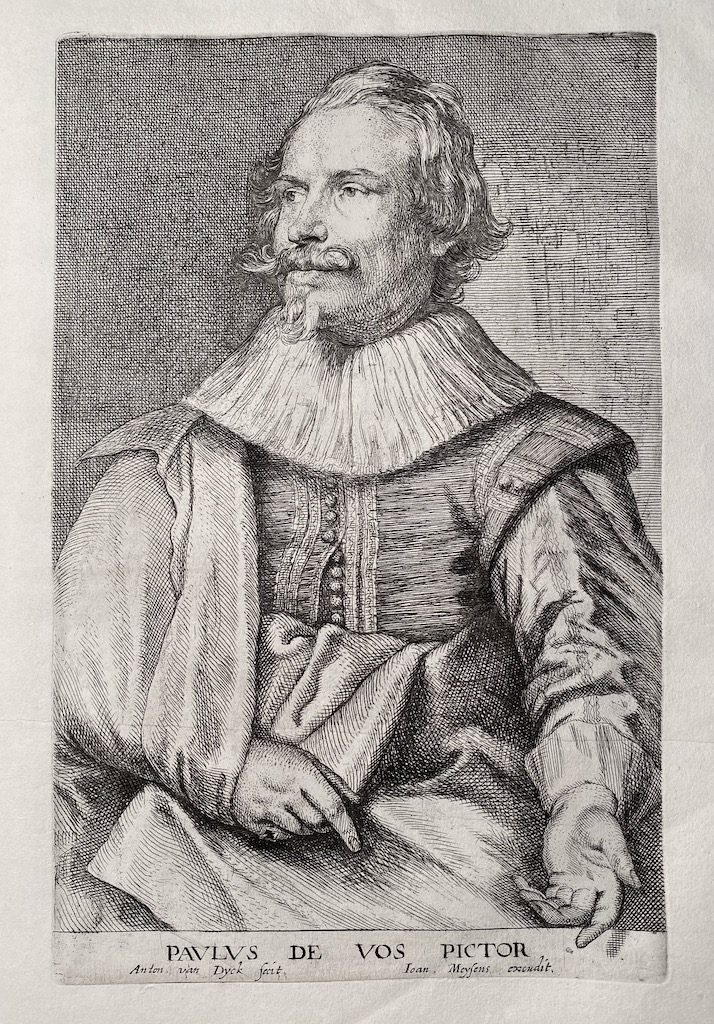 |
53. Paul de Vos (Flemish, 1596 – 1678); printed by Ioannes Meyssens, face and collar engraved by Anthony van Dyck, the body engraved by Ioannes Meyssens. Second, lettered state. Inscription: PAVLVS DE VOS PICTOR”. In lower margin: “Anton. van Dyck pinxit fecit.”, and “Ioan. Meysens excudit.”. British Museum # R,1b.95. [Look s very much alike №68, but with a one-line inscription and engraved by Meyssens instead of Bolswert]. |
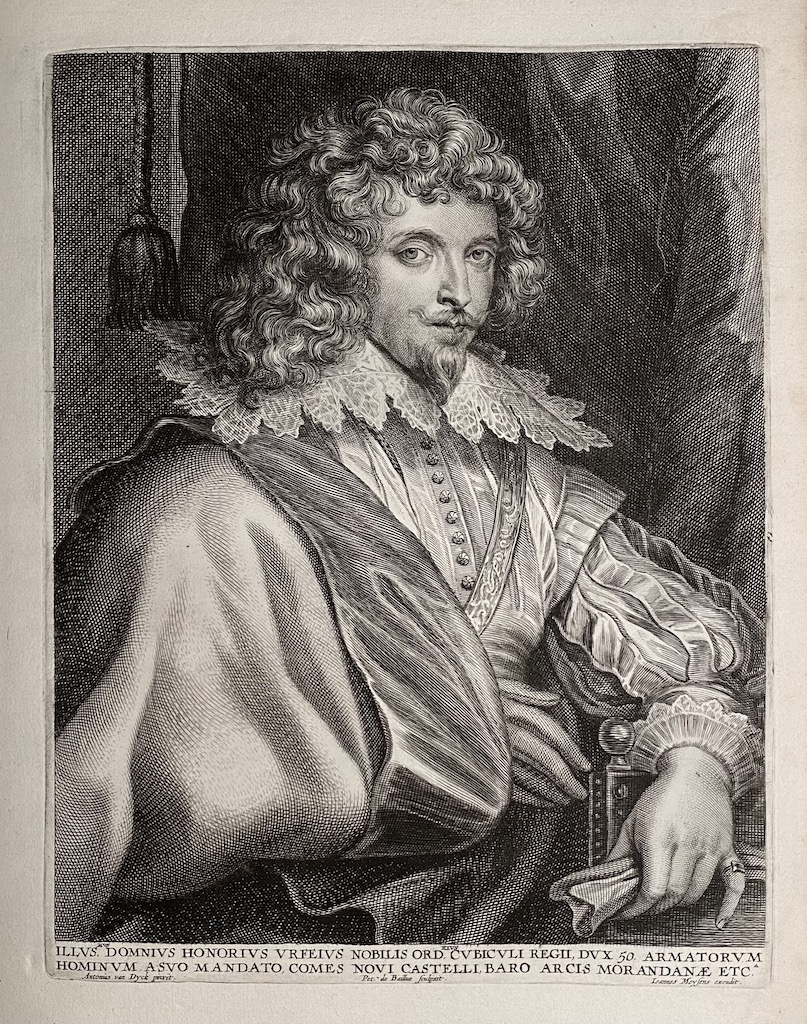 |
54. Honoré d’Urfé, marquis de Valromey, comte de Châteauneuf (French, 1568 – 1625); engraved by Pieter de Bailliu (Flemish, 1613 – 1660). Inscription: “ILLVS.MVS DOMNIVS HONORIVS VRFEIVS NOBILIS ORD.RIVS CVBICVLI REGII, DVX 50. ARMATORVM | HOMINVM A SVO MANDATO, COMES NOVI CASTELLI, BARO ARCIS MORANDANÆ ETC.A”. Below: “Antonius van Dyck pinxit” <–> “Pet. de Bailliue sculpsit.” <–> “Ioanes Meysens excudit.”. Second lettered state with title and production details. [Similar to №14, but with Ioanes Meysens name in place]. |
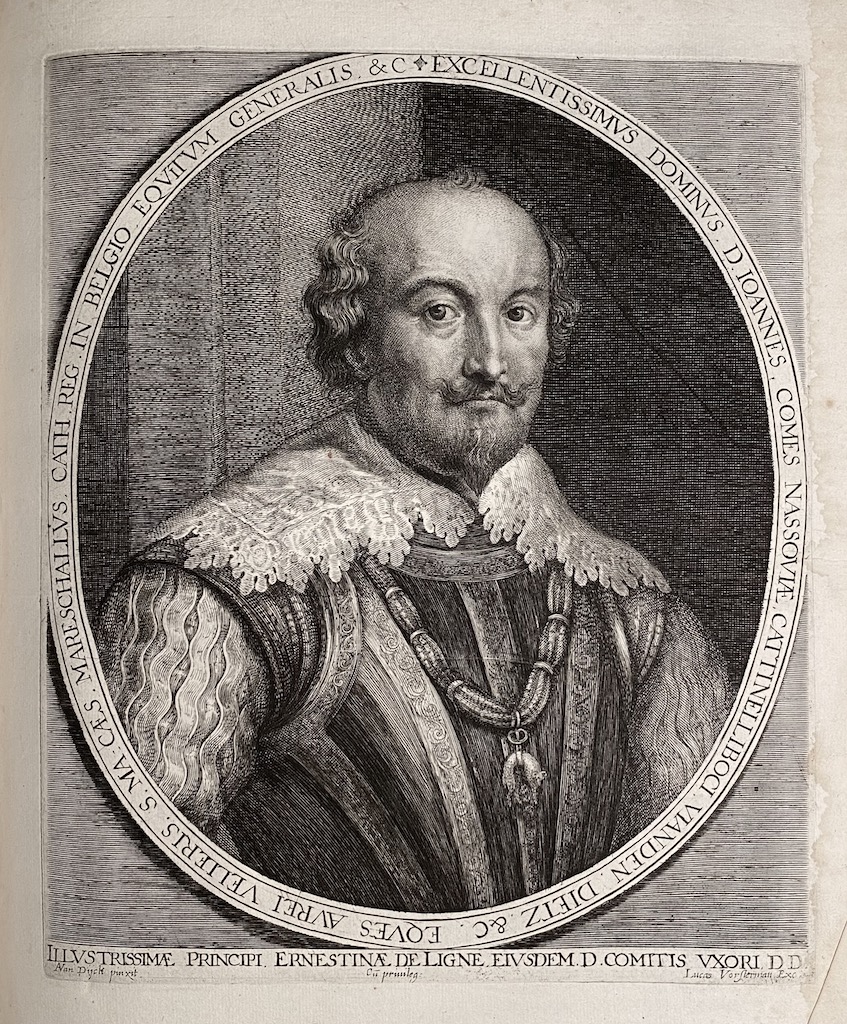 |
55. Johannes [John VIII], Count of Nassau-Siegen (German, 1583 – 1638); engraved by Lucas Vorsterman I (Flemish, 1595 – 1675). Inscription: in the oval around the portrait “EXCELLENTISSIMVS DOMINVS: D. IOANNES, COMES NASSAOVIÆ, CATTNELLIBOCI: VIANDEN, DIETZ, &C. EQVES AVREI VELLERIS. S. MA: CÆS, MARESCHALIVS, CATH. REG. IN BELGIO. EQVITVM GENERALIS. &C”, in lower margin: “ILLVSTRISSIMÆ PRINCIPI ERNESTINÆ DE LIGNE EIVSDEM D. COMITIS VXORI DD.”. Below: “AVan Dÿck pinxit.” <–> “Cū Priuleg” <–> “Lucas Vorsterman exc”. Third state. [For the fourth state with Lucas “Vorsterman exc” burnished see № 15]. |
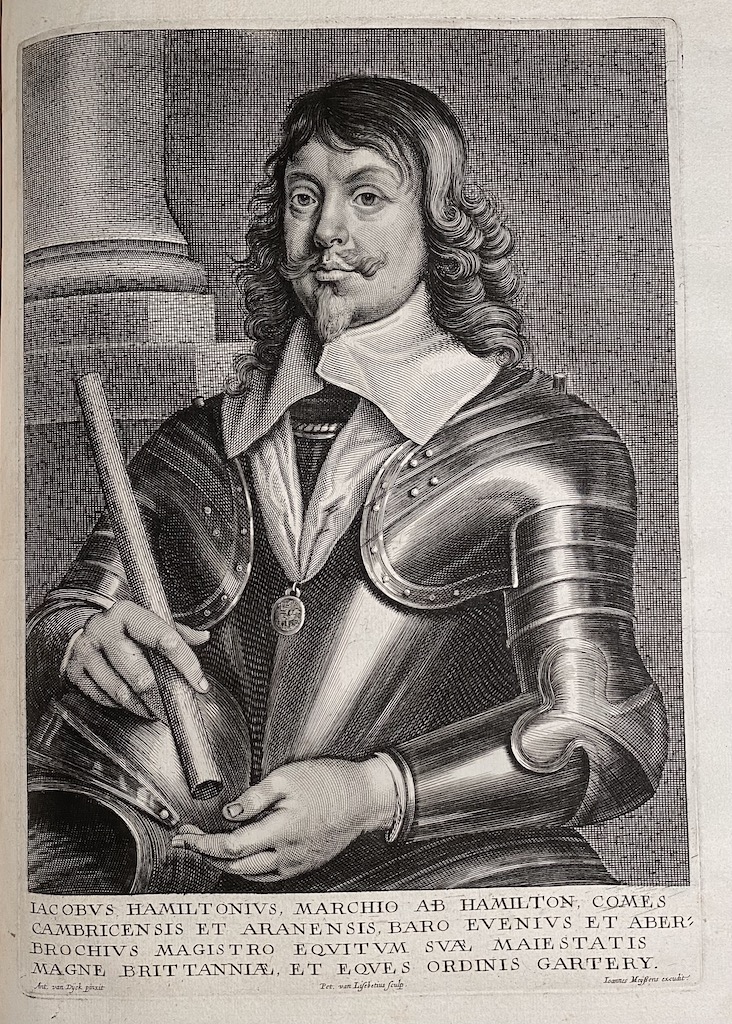 |
56. James Hamilton, 1st Duke of Hamilton (British, 1606 – 1649); engraved by Peeter van Lisebetten (Flemish,(1630 – 1678), published by Ioannes Meysens. Inscription: “IACOBVS HAMILTONIVS, MARCHIO AB HAMILTON, COMES | CAMBRICENSIS ET ARANENSIS, BARO EVENIVS ET ABER: | BROCHIVS MAGISTRO EQVITVM SVÆ MAIESTATIS | MAGNE BRITTANIÆ, ET EQUES ORDINIS GARTERY.”.In lower margin: “Ant. van Dÿck pinxit” <–> “Pet. van Lisebetius sculp.”<–> “Ioannes Meÿssens excudit.”. Second state with title and signatures. British Museum # P,2.208. |
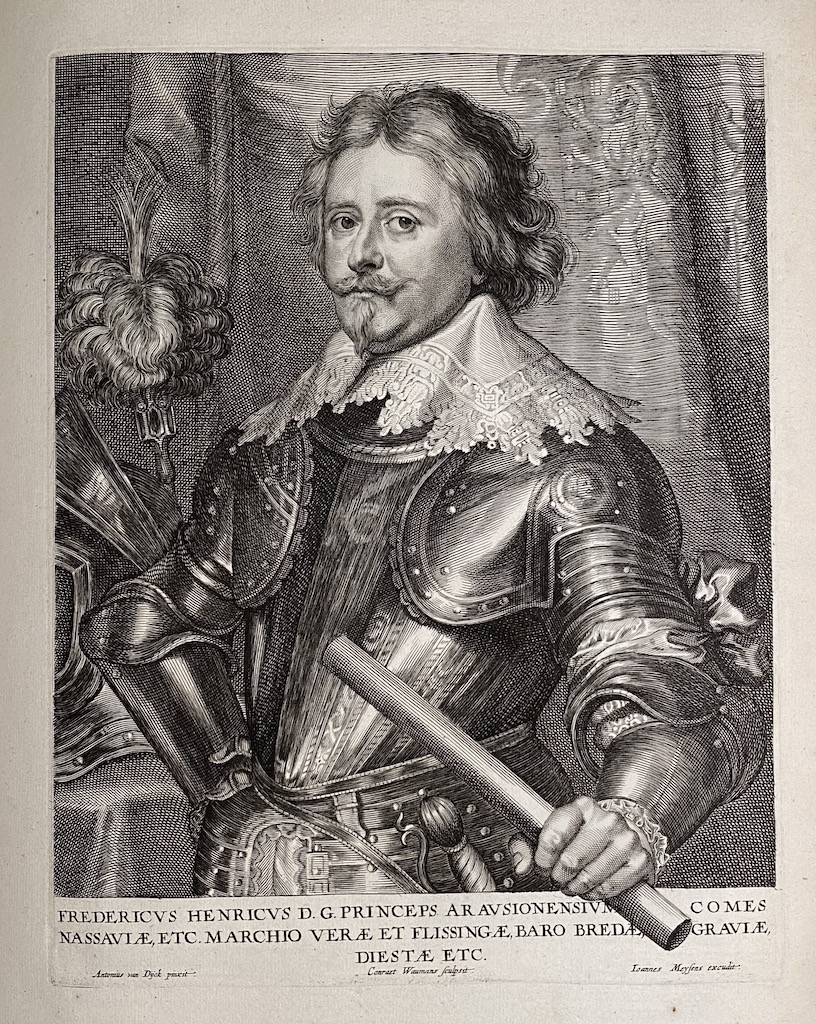 |
57. Frederick Henry, Prince of Orange, Count of Nassau (Dutch, 1584 – 1647); engraved by Conrad Waumans [Woumans] (Flemish, 1619 – after 1675). Inscription: “FREDERICVS HENRICVS, D.G. PRINCEPS ARAVSIONENSIVM, COMES | NASSAVIÆ, ETC. | MARCHIO VERÆ ET FLISSINGÆ, BARO BREDÆ GRAVÆ, | DIESTÆ ETC.”. Below: “Antonius van Dÿck pinxit” <–> “Conraet Waumans sculpsit” <–> “Ioannes Meyssens excudit.” First, lettered state with title and production details. [Similar to №5, but this one with Ioannes Meyssens name present]. |
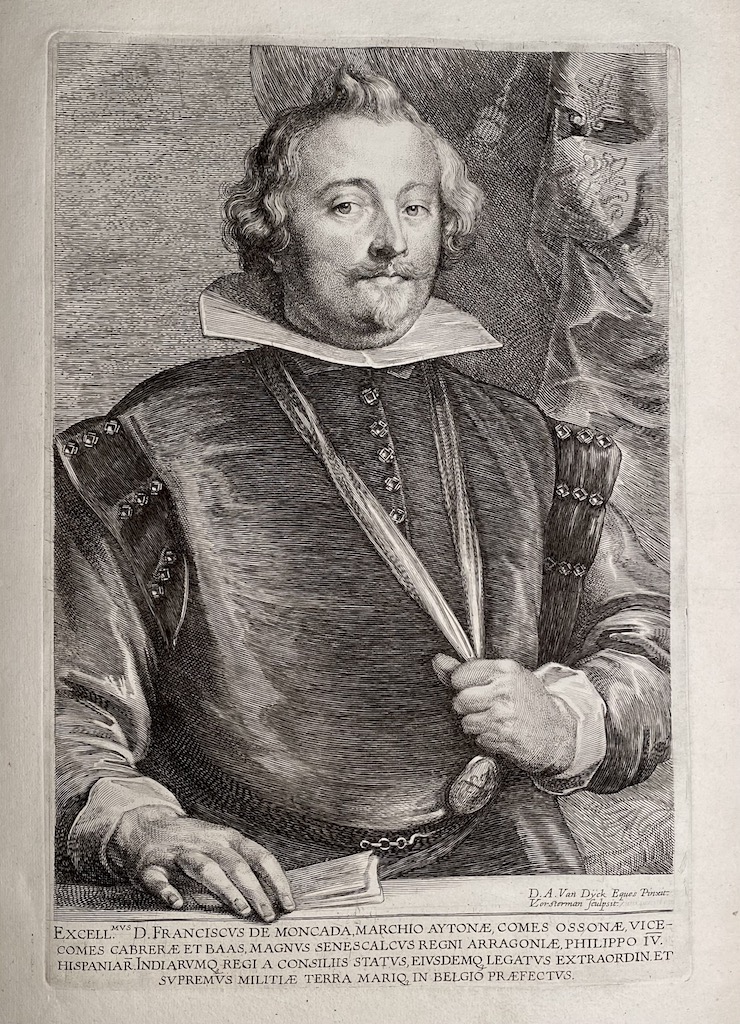 |
58. Francisco de Moncada, Count d’Osuna (Spanish, 1568 – 1635); engraved by Lucas Vorsterman I. Inscription: “EXCELL.MVS D. FRANCISCVS DE MONCADA MARCHIO AYTONÆ, COMES OSSONÆ VICE– | COMES CABRERÆ ET BAAS, MAGNVS SENESCALCVS REGNI ARRAGONIÆ, PHILIPPO IV. | HISPANIAR.INDIARVMQ3 REGI A CONSILIIS STATVS, EIVSDEMQ3 LEGATVS EXTRAORDIN,ET | SVPREMVS MILITIÆ TERRA MARIQ3 IN BELGIO PRÆFECTVS". Above within portrait frame, to the right: “D.A.van Dÿck pinxit. | LVorsterman sculpsit.”. |
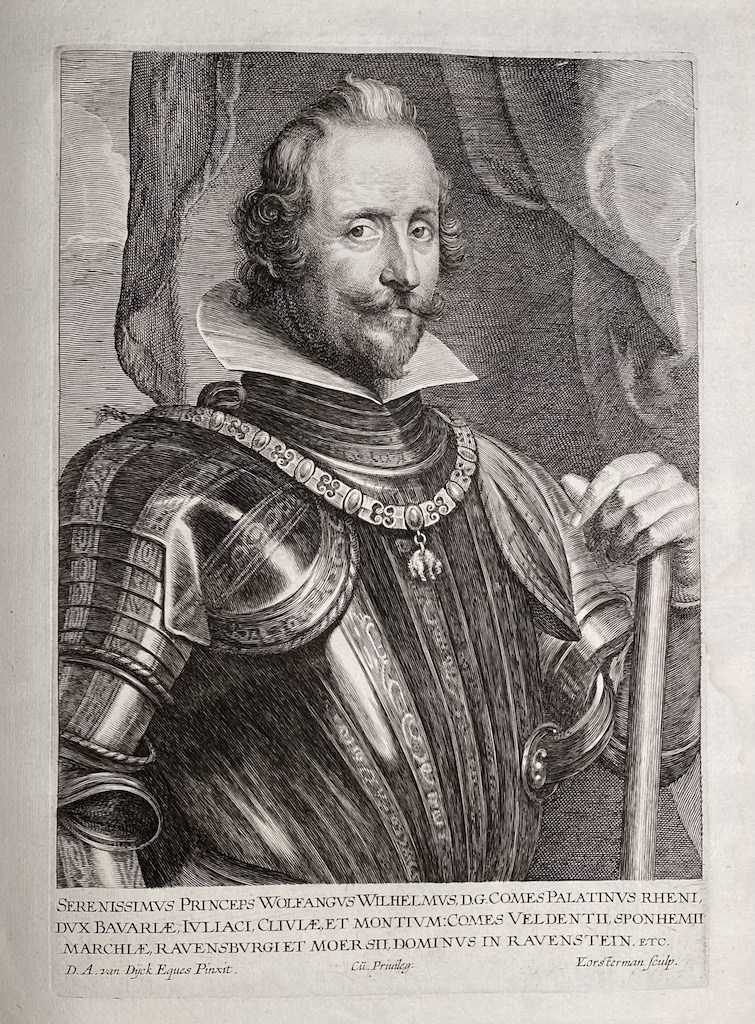 |
59. Wolfgang Wilhelm, Count of Pfalz-Neuburg and Duke of Jülich (German, 1578 – 1653); engraved by Lucas Vorsterman I. Inscription: "SERENISSIMVS PRINCEPS WOLFGANGVS WILHELMVS, D.G. COMES PALATINVS RHENI, | DVX BAVARIÆ, IVLIACÆ, ET MONTIVM :COMES VELDENTII, SPONHEMII | MARCHIÆ, RAVENSBVRGI ET MOERSII, DOMINVS IN RAVENSTEIN. ETC." In lower margin: "D. A. van Dÿck Eques Pinxit." <–> "Cū. Priuileg:" <–> "LVorsterman sculp.". Fifth state with initials of Gillis Hendricx burnished. British Museum # 1863,0509.825. |
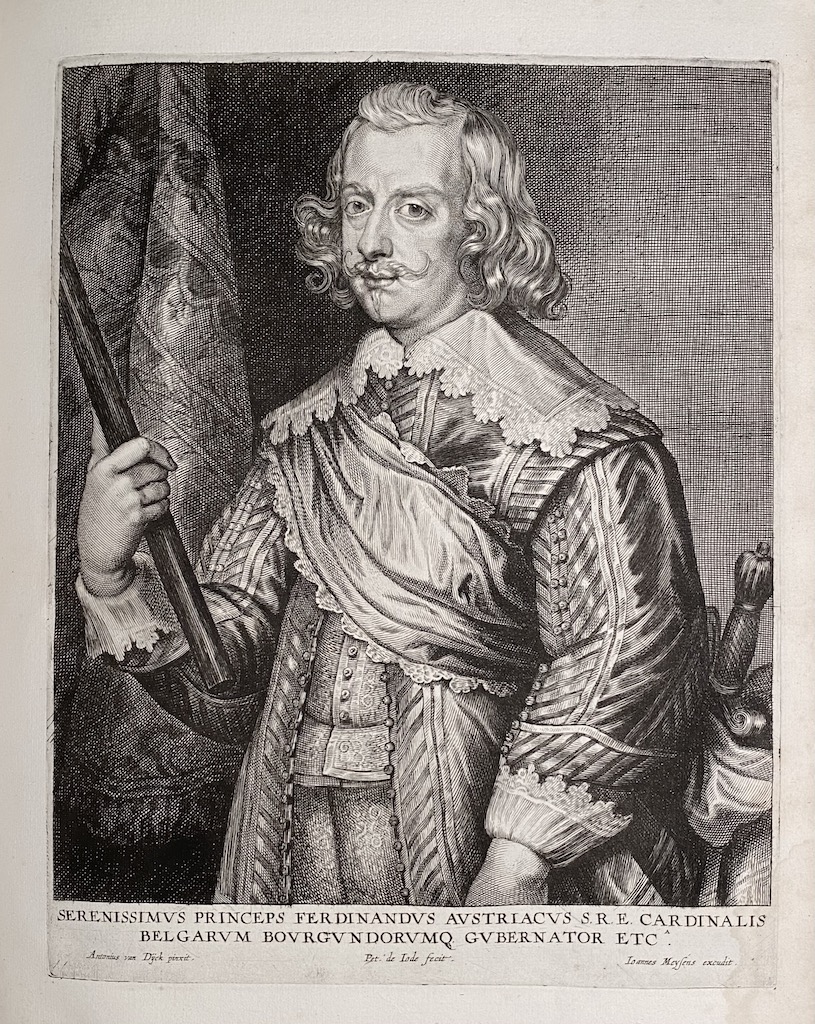 |
60. Ferdinand, Cardinal Infante of Spain and Archduke of Austria (Spanish, 1609 – 1641); engraved by Pieter de Jode II, published by Ioannes Meyssens. Inscription: “SERENISSIMVS PRINCEPS FERDINANDVS AVSTRIACVS S.R.E CARDINALIS | BELGARVM BORGVNDIORVMQ3 GVBERNATOR ETC.A”. In lower margin: “Antonius van Dÿck pinxit” <–> “Pet. de Iode fecit” <–> “Ioannes Meysens excudit”. Third, lettered state with title and production details. British Museum # R,1a.28. |
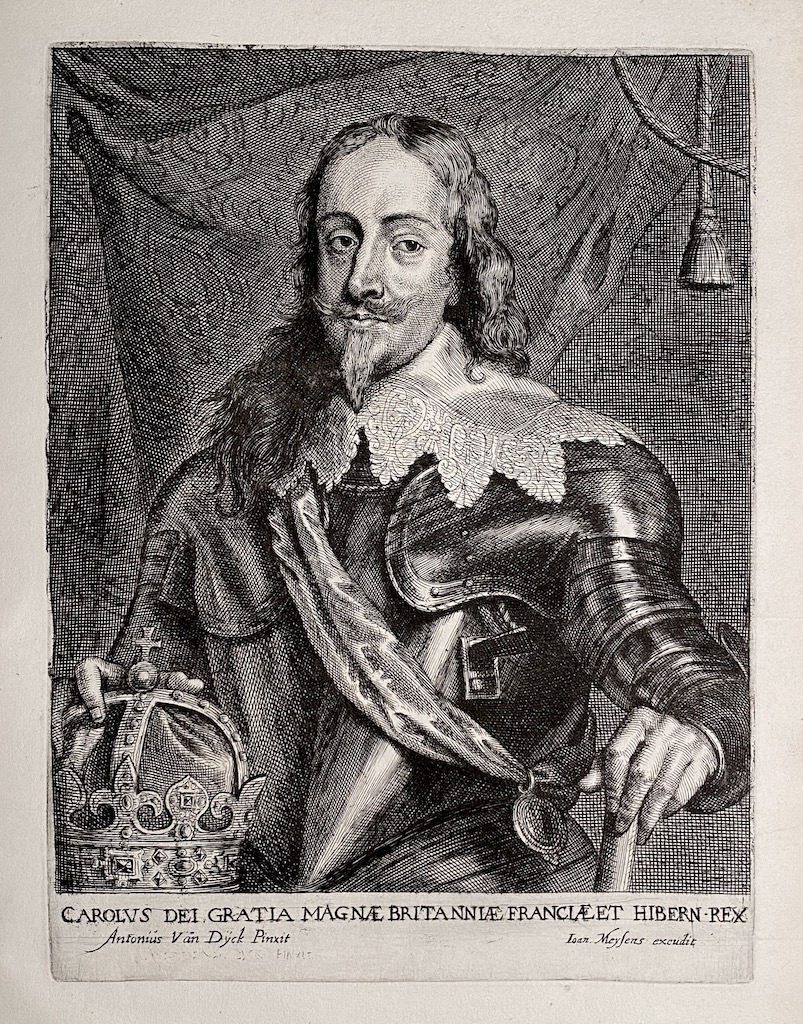 |
61. Charles I, King of England, Scotland, and Ireland (British, 1600 – 1649); engraved by Johannes [Jan] Meyssens (Flemish, 1612 – 1670). Inscription: “CAROLVS DEI GRATIA MAGNÆ BRITANNIÆ, FRANCIÆ ET HIBERNIÆ REX”. Below: “Antonius Van Dÿck eques pinxit” <–> “Ioan. Meysens excudit”. [Similar to №4, but with Ioannes Meysens name present]. |
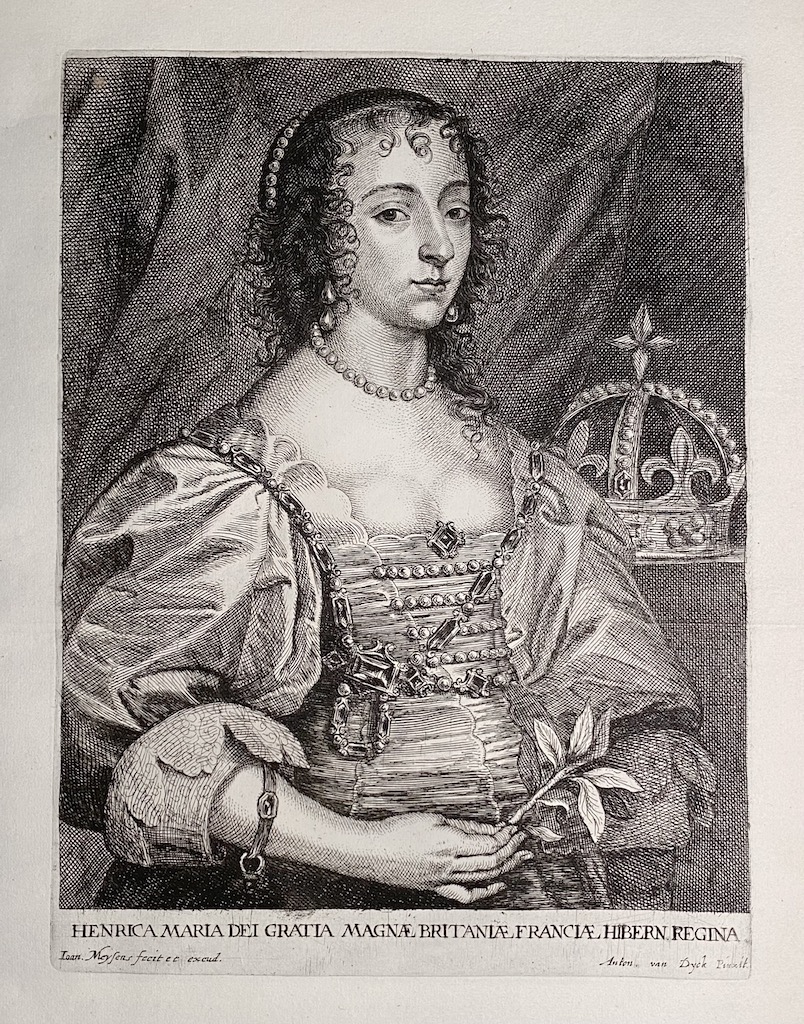 |
62. Henriette Marie de Bourbon, engraved and published by Ioannes Meyssens. Inscription: “HENRICA MARIA DEI GRATIA MAGNÆ BRITANIÆ FRANCIAÆ HIBERN. REGINA.” Lettered with production details in lower margin: “Ioan. Meysens fecit et excud.” <–> “Anton van Dyck Pinxit”. Third state, finished with a burin. [Similar to print №31, but this one with Ioan. Mey∫ens signature present]. |
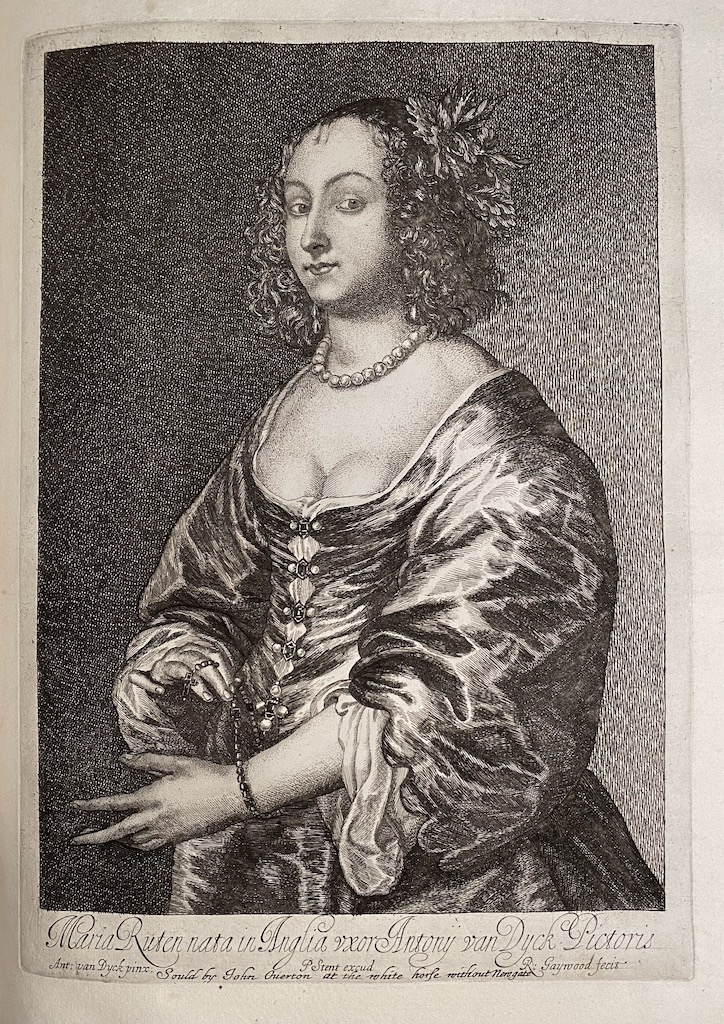 |
63. Mary Ruthven, Lady van Dyck (Scottish, c. 1622 – 1645); copy in reverse by Richard Gaywood after Bolswert (see also №51 by Meyssens) published by Peter Stent. Inscription: “Maria Ruten nata in Anglia vxor Antonÿ van Dyck Pictoris”. Below: “Ant: van Dyck pinx:”, “P Stent excud”, “R: Gaywood fecit”. Below centre: “Sould by John Ouerton at the white horse without New gate”. John Overton, publisher (British, 1639/40 – 1713); Richard Gaywood (British, fl. c. 1644 – 1677). Peter Stent (British, fl. c. 1637 – 1665). See BM # P,3.351. |
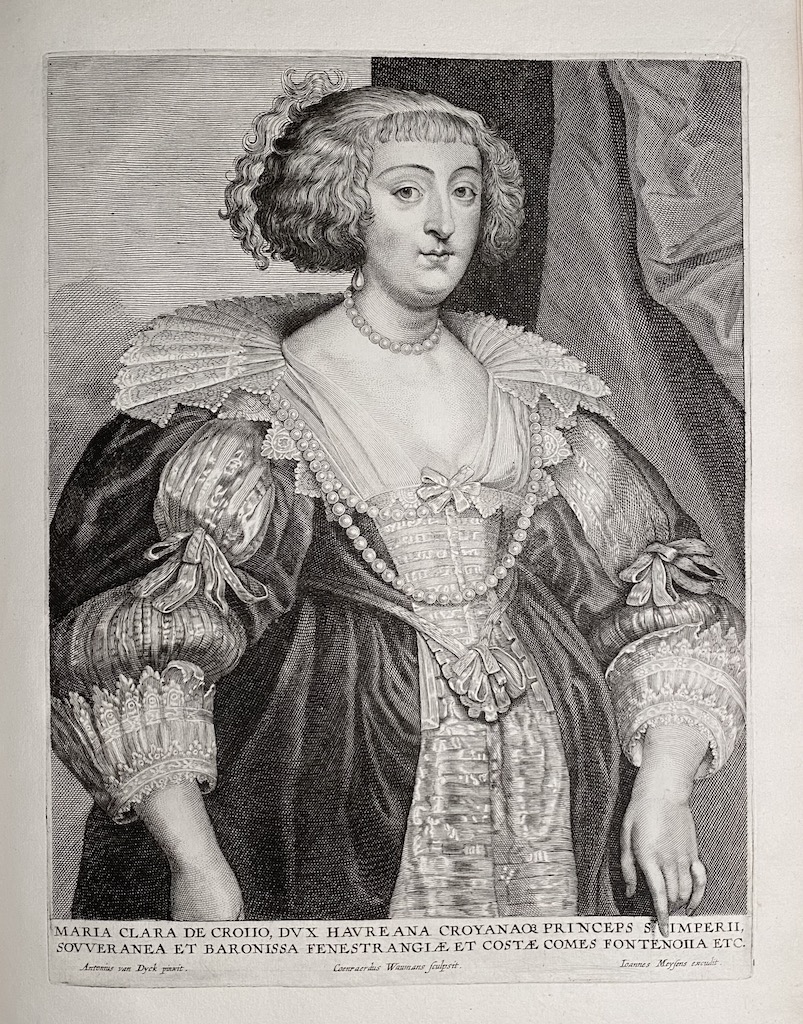 |
64. Marie-Claire de Croy, Duchess of Havré (Flemish, 1605 – 1664); engraved by Conraad Waumans, published by Ioannes Meyssens. Inscription: “MARIA CLARA DE CROIIO, DVX HAVREANA CROYANAQ3 PRINCEPS STE. IMPERII, | SOVVERANEA ET BARONISSA FENESTRANGIÆ ET COSTÆ COMES FONTENOIIA ETC”. In lower margin: “Antonius van Dyck pinxit.” <–> “Coenraerdus Waumans sculpsit.” <–> “Ioannes Meysens excudit.”. Second state. British Museum # R,1a.188. [Similar to №36, but this one with Ioannes Meysens name present]. |
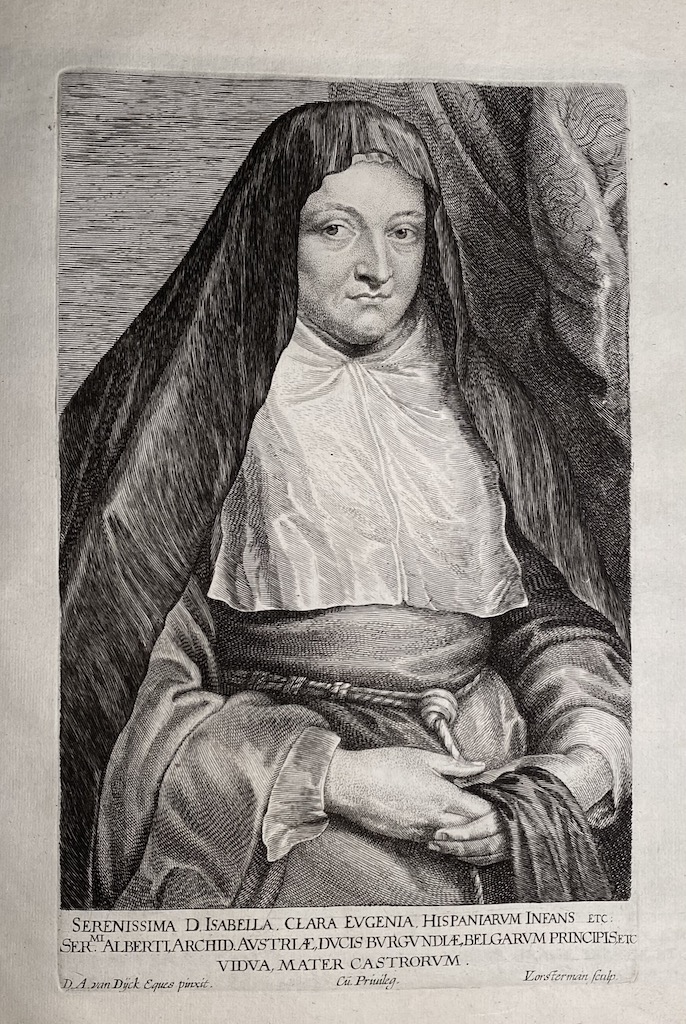 |
65. Isabel Clara Eugenia, ruler of the Spanish Netherlands (Spanish, 1566 – 1633); engraved by Lucas Vorsterman I. “SERENISSIMA D. ISABELLA. CLARA. EVGENIA. HISPANIARVM INFANS ETC. | SER.MI ALBERTI. ARCHID. AVSTRIÆ, DVCIS BVRGVNDIÆ, BELGARVM PRINCIPIS, ETC. | VIDVA, MATER CASTRORVM.” In lower margin: “D. A.van Dÿck Eques pinxit.” <–> “Cū Priuileg.” <–> “LVorsterman sculp.”. Fourth state with initials of Gillis Hendricx burnished. British Museum # 1863,0509.820. |
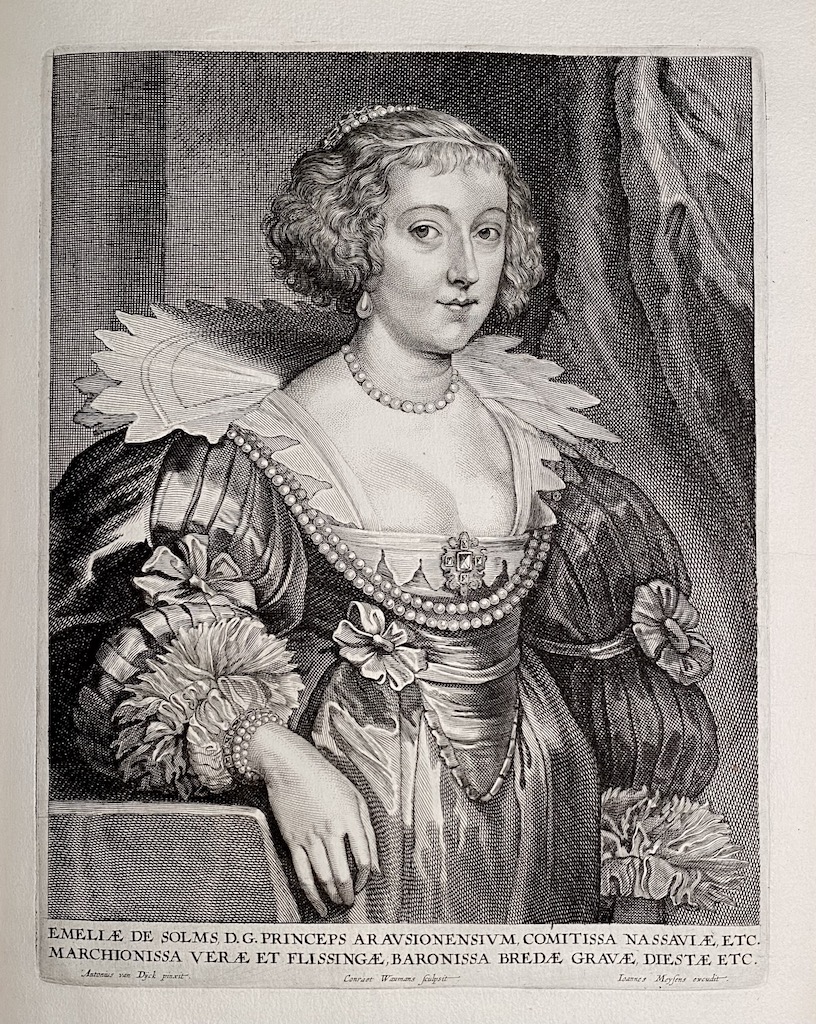 |
66. Amalia van Solms, Princess of Orange (German, 1602 – 1675), engraved by Conraad Waumans and published by Johannes Meyssens. Inscription: “EMELIÆ DE SOLMS, D. G. PRINCPES ARAVSIONENSIVM, COMITISSA NASSAUVIÆ, ETC. | MARCHIONISSA VERÆ ET FLISSINGÆ, BARONISSA BREDÆ, GRAVÆ, DIESTÆ ETC.” In lower margin: “Antonius van Dijck pinxit.”, “Conraet Waumans sculpsit.” and “Ioannes Meysens excudit.”. First, lettered state with the title and production details lettered. [Similar to №32, but this one with Ioannes Meysens name present]. |
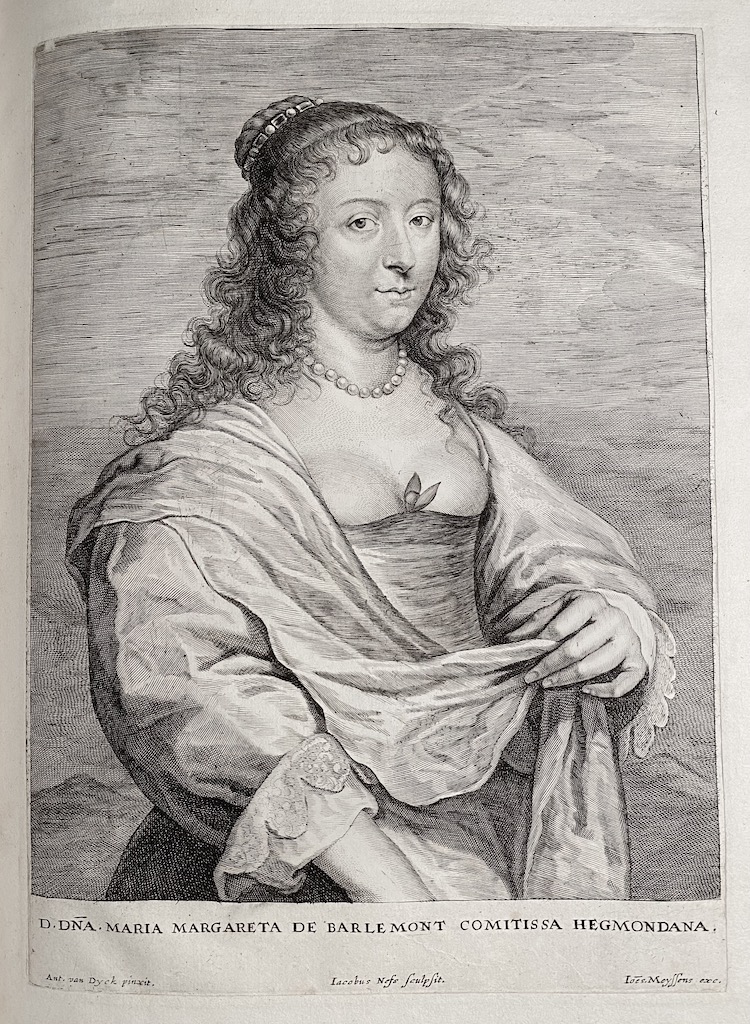 |
67. Marie-Marguerite de Berlaymont ( ? – 1654); engraved by Jacobus Neeffs, published by Ioannes Meyssens. Inscription: “D.DNA. MARIA MARGARETA DE BARLEMONT COMITISSA HEGMONDANA.” In lower margin: “Ant. van Dyck pinxit.” <–> “Iacobus Nefs sculpsit.” <–> “Ioes Meyssens exc.”. Fourth state. [Similar to №45, but this one with Ioannes Meysens name present]. |
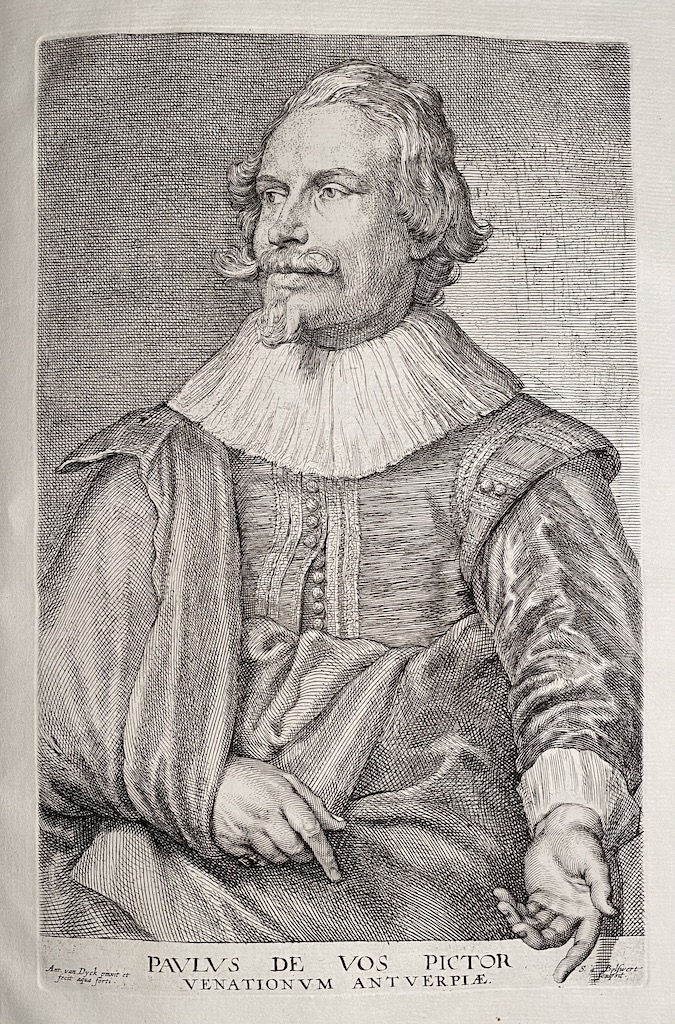 |
68. Paul de Vos (Flemich, 1596-1678); engraved and etched by Anthony van Dyck and by Schelte Adamsz. Bolswert, published by Gillis Hendricx. Eighth state with the initials of Gillis Hendricx burnished. Inscription: PAVLVS DE VOS PICTOR | VENATIONVM ANTVERPIÆ.”. “Ant. van Dyck pinxit et | fecit aqua forti.” <–> “S. à Bol∫wert | sculpsit. ”. [Look s very much alike №53, but with a two-line inscription and engraved by Bolswert instead of Meyssens, etc.]. |
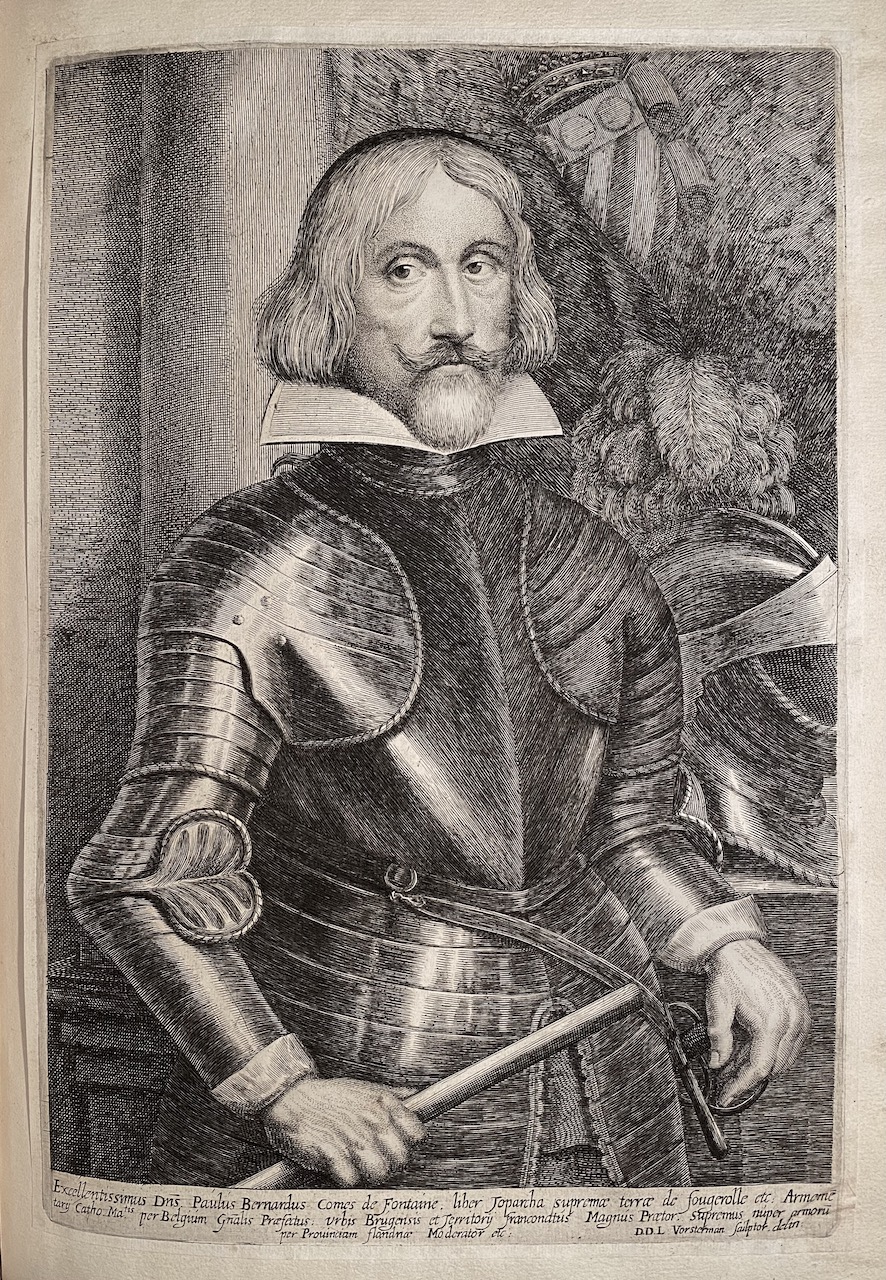 |
69. Paul-Bernard de Fontaines (French, 1566 – 1643) delineated and engraved by Lucas Vorsterman I (Flemish, 1595 – 1675) in 1615–75. Inscription: “Excellentissimus Dns. Paulus Bernardus Comes de Fontaine. liber Toparcha supremae terrae de fougerolle etc: Armeme tarij Catho. Matis. per Belgium Gnalis Praefectus: Vrbis Brugensis et Territorij fraconatus Magnus Praetor. Supremus nuper armpru Prouinciam flandriae Moderator etc: D.D.L Vorsterman sculptor. delin”. Cut without margins and pasted to inbound leaf. See: MET: Accession Number: 51.501.1332 |
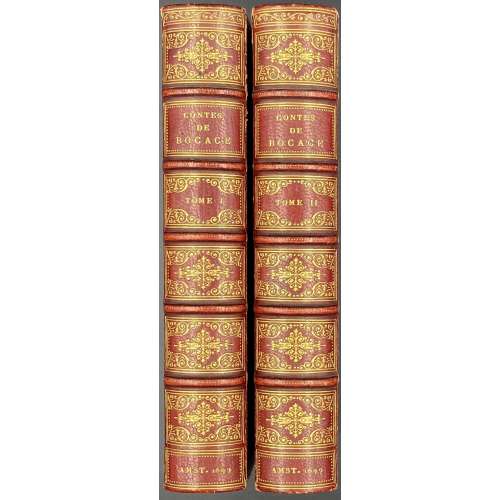
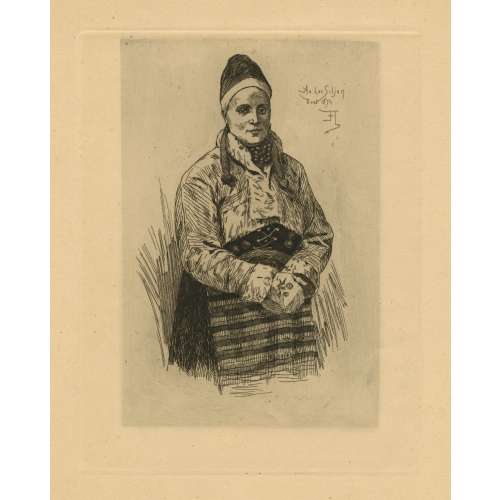
Etching on laid paper, monogrammed in the plate and inscribed "Au Lac Siljan, Août 1874". Owner's stamp LVM on verso.
Dimensions: Paper: 47 x 34 cm; Plate: 24 x 19 cm; Image: 21 x 14 cm.
Catalogue raisonné: Rouir 858:5; Arthur Hubschmid (1977): 320.
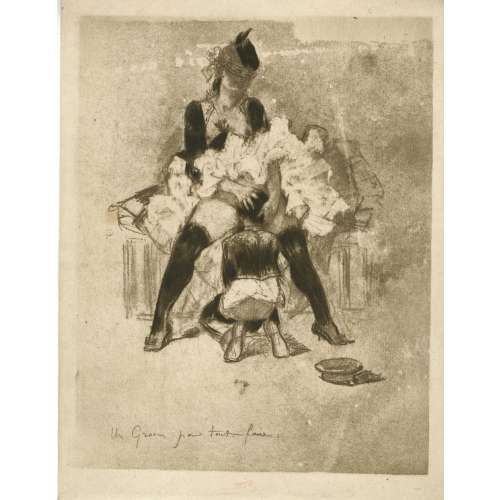
Etching on laid paper, depicting a kneeling groom with his head between the spread legs of a bare-breasted woman in a veiled hat. Inscribed on plate: Un groom a tout faire. Owner's stamp LVM on verso.
Dimensions: Paper: 24.4 x 15.8 cm; Image: 12 x 7.5 cm
Catalogue raisonné: Arthur Hubschmid (1977): 662.
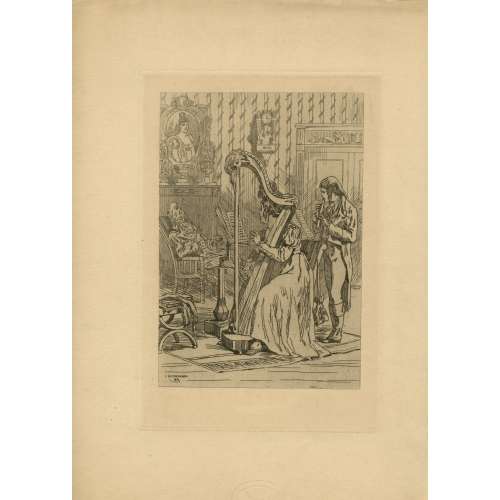
Two prints on laid paper, one in an earlier state, published under the name Niederkorn. Owner's stamp 'LvM' on verso.
Dimensions: Paper (1): 31 x 22.3 cm; Paper (2): 46 x 33.8 cm; Plate: 31 x 22 cm; Image: 25.5 x 17.5 cm.
Catalogue raisonné: Arthur Hubschmid (1977): 318; Rouir 954:3 and 954:5?.
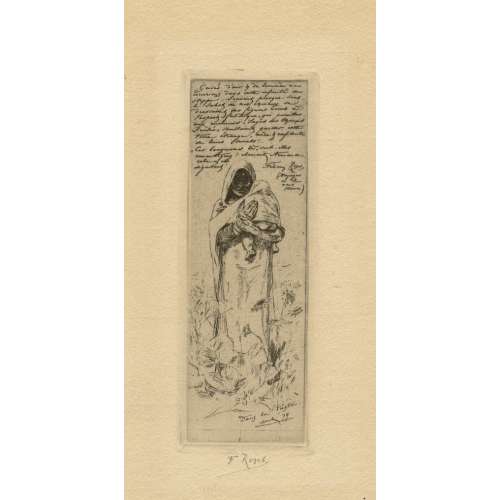
Etching and drypoint, signed in pencil by the artist under the plate; 2nd state. Pasted on a sheet of blue paper. Fragment of "La messe de Gnide". Owner's stamp 'LvM' on verso.
Dimensions: Blue paper: 32 x 27 cm; Laid paper: 30.7 x 22 cm; Image: 12.5 x 4 cm.
Catalogue raisonné: Arthur Hubschmid (1977): 364; Graphics irreverent and erotic (1968): 59; Rouir: 508.
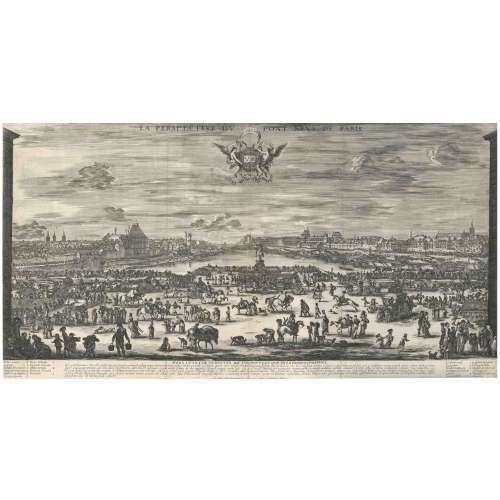
Etching on laid paper, backed. Massar (1971): 59-61. View of the Pont Neuf in Paris, with the statue of Henry IV at centre in front of the Seine, the church of St.-Germaine l'Auxerrois and the Louvre to the right, and the Hôtel de Nevers and Tour de Nesle to the left (MET). in the banner below: LUDOVICO XIIII GALLIARUM ET NAV REGI; below image: PONS LVTETIÆ STRVCTVS, DICTVS NOVVS, ET QVÆ EX EO PROSPICI POSSVNT.; bellow: En pulcherrimus toto ... caufatus, vifere; along the bottom: Ste. Della Bella Florentinus In. e Fecit DD. 1646. Cum Privilegio Regis; additional lettering a lower left and right identifying places depicted.
State: 2nd, with the weathercock on the belltower of Église Saint-Germain l'Auxerrois (under 8). Size: 35.5 x 67.6 cm. Condition: Three vertical folds, these partly cracked and backed at the bottom, dusty or slightly stained, partly slightly rubbed, a small diagonal crease on the upper left, tiny marginal blemishes.Quotation from Phyllis D. Massar. Presenting Stefano della Bella. — NY: The Metropolitan Museum of Art, [1971]: "For size and complexity, one of Della Bella's most impressive achievements is his view of Paris across the Pont Neuf from a point between the buildings bounding the Place Dauphine. Besides the well-known landmarks-the Hộtel de Nevers, the Tour de Nesle, the church of Saint Germain l'Auxerrois, and, at the centre, the bronze equestrian statue of Henri IV by the Florentines Giovanni Bologna and Pietro Tacca – the print provides a microcosm of Paris in transit across the Seine. With a glass, one can compile a census of 451 people, thirty-eight horses, nineteen dogs, three donkeys, and one lamb. All but lost in the vast scene, nevertheless, all contributing to it, are duelists, men fighting with staffs, brawlers routing passers-by, a tooth-puller making an extraction, sellers of sweetmeats and fruits, falconers, hunters with a pack of dogs, a legless cripple, many begging gypsies (one of them telling a fortune), and a hurdy-gurdy player with an audience. Moving among the splendid carriages is a humble water cart, and back among the market stands at the right is an early Seine-side bookstall."
Catalogue raisonné: Massar (1971): pp. 58-61; De Vesme p. 132, № 850ii/ii. Contributor: Stefano della Bella (Italian, 1610 – 1664) – artist and engraver.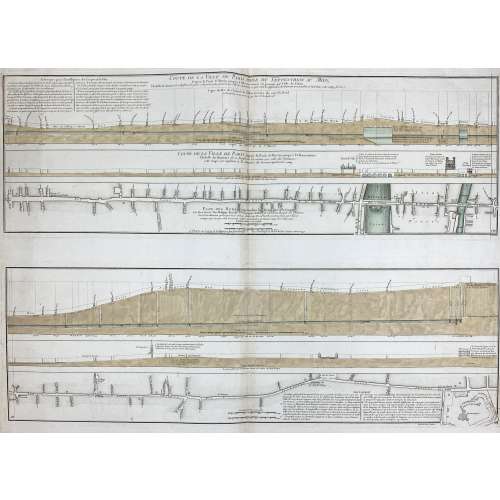
Two prints on one sheet of watermarked laid paper.
Coupe de la ville de Paris prise du septentrion au midy, depuis la porte St Martin jusqu'à l'Observatoire en passant par l'isle du Palais... Coupe de la ville de Paris depuis la porte St Martin jusqu'à l'Observatoire... Plan des rues comprises dans la direction dela coupe... / Le tout dressé par Philippe Buache... ; Desbruslins, sculpsit.
Watermark: "IHS" within circle; countermark of "FIN/ DUPUY/ AUVERGNE 1749".
LOC dates it to 1757. Gallica – to 1742, though the watermark is 1749.
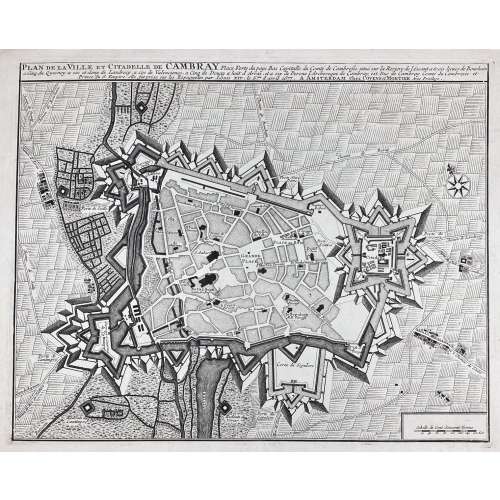
Plan de la ville et citadelle de Cambray : place forte du pays bas capitalle du Comté Cambresis situé sur la riviere de l'Escaut a trois lieues de Bouchain, a cinq du Quesnoy, a six et demy de Landrecy, a six de Valenciene, a cinq de Douay, a huit d'Arras, et a six de Perone, l'Archeveque de Cambray est Duc de Cambray, Comté du Cambresis et Prince du S. Empire, elle fut prix sur les espagnoles par Louis XIV, le 5.me d'April 1677; A AMSTERDAM Chez Covens & Mortier, Avec Privilege.
Date of publication: [between 1721 and 1778].
Dimensions: Sheet: 48 x 58.3 cm; Image: 38.2 x 47.7 cm. Earlier editions of the same were by Pierre Husson in the Hague (ca. 1715) and by Eugene Henry Fricx in Brussels (1710).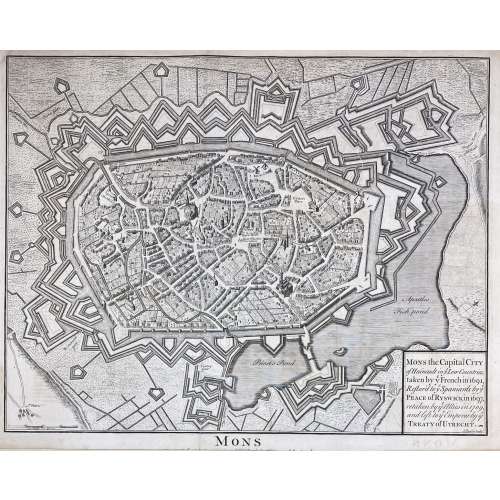
Mons the Capital City of Hainault in y Low Countries, taken by y French in 1691, Restor'd to y Spaniards by y Peace of Ryswick in 1697, retaken by y Allies in 1709, and left to y Emperor by y Treaty of Utrecht. attribution to publication source has been trimmed.
Dimensions: Sheet: 40.7 x 52.5 cm; Image: 37.5 x 48 cm. Published between 1744 and 1747. Attribution to publication source has been trimmed. Reference: Royal Academy 03/2919. Source: Maps for Mr. Tindal's Continuation of Mr. Rapin's History of England. London: John and Paul Knapton. Nicolas Tindal (British, 1687 – 1774) – the translator and continuer of the History of England by Paul de Rapin. Paul de Rapin (French, 1661 – 1725) – a Huguenot historian, author of the History of England.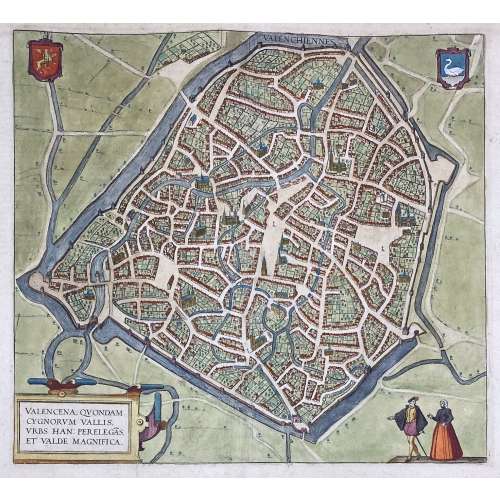
Engraved and hand-coloured map of Valenciennes first produced for Braun & Hogenberg's 6-volume Civitates orbis terrarum edition in 1570.
English translation of the text printed on verso: "The Loire, an exceedingly well-known river in France, flows directly past the city and is very beneficial for trade. The fields surrounding the city are very fertile, and for this reason, the city is also called the granary throughout France, just as in earlier times Sicily was the granary of Rome. A famous wine also grows in this soil, which is exported from here not only throughout France but to all the countries in Europe. [...] The French spoken here is pure and uncorrupted, which is also the reason why so many foreigners settle here. For some are here for trade, others for study and others again to acquire the language, but also many without doubt for both these last two reasons, [...] and Germans, in particular, send their children here." [by Barry Lawrence Ruderman Antique Maps Inc.]
Dimensions: Sheet: 39.8 x 53.5 cm; Image: 35.2 x 38.5 cm.
Probably published in Cologne is 1612-18 by Petrum à Brachel: [Coloniae Agrippinae: apud Petrum à Brachel, sumptibus auctorum, 1612-1618]. Ref: LOC.Georg Braun [Brunus; Bruin] (German, 1541 – 1622).
Frans Hogenberg (Flemish-German, 1535 – 1590).
Abraham Ortelius [Ortels; Orthellius; Wortels] (Dutch, 1527 – 1598).